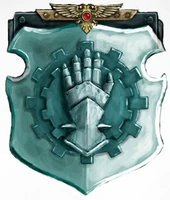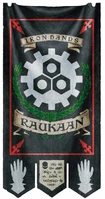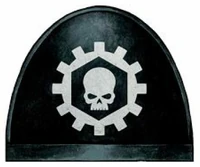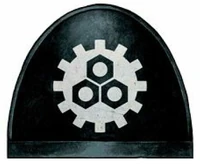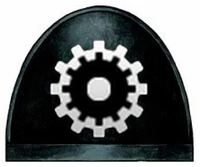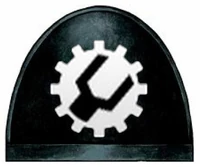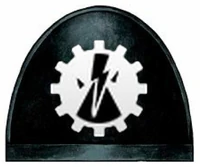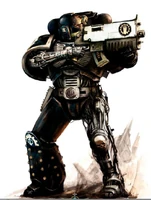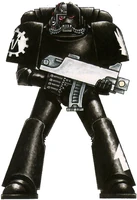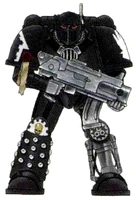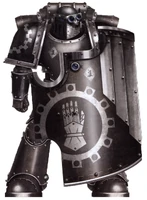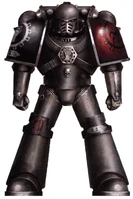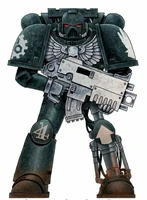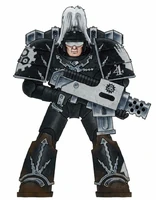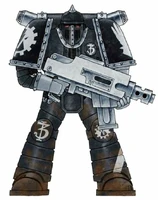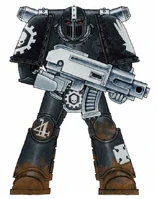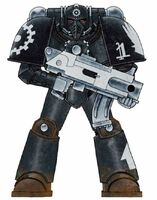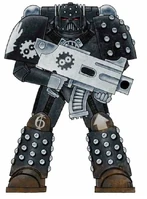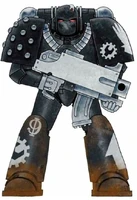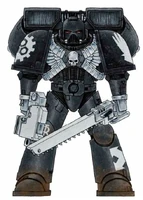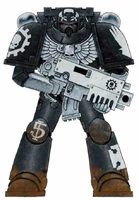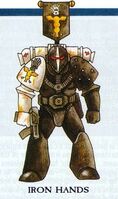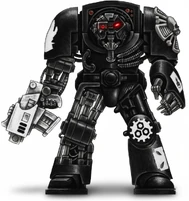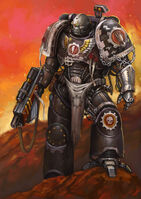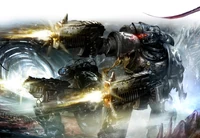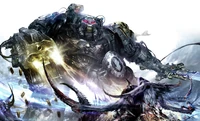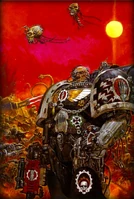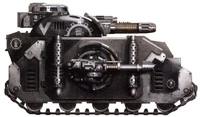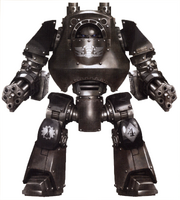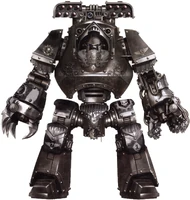No edit summary |
No edit summary |
||
| Line 649: | Line 649: | ||
IH Contemptor Mortis Pattern2.png|Iron Hands Legion [[Contemptor-Mortis Pattern Dreadnought]] Veneratii Urien, Order Quarii, Clan Vurgaan; note that Veneratii Urien's Dreadnought armour is configured according to the Mortis sub-pattern, mounting a pair of Kheres Pattern [[Assault Cannon]]s, as well as highly advanced targeting systems |
IH Contemptor Mortis Pattern2.png|Iron Hands Legion [[Contemptor-Mortis Pattern Dreadnought]] Veneratii Urien, Order Quarii, Clan Vurgaan; note that Veneratii Urien's Dreadnought armour is configured according to the Mortis sub-pattern, mounting a pair of Kheres Pattern [[Assault Cannon]]s, as well as highly advanced targeting systems |
||
IH Contemptor siege variant2.png|Iron Hands Legion [[Contemptor Pattern Dreadnought]] [[Ancient Morn]], Order Primii, Clan Avernii |
IH Contemptor siege variant2.png|Iron Hands Legion [[Contemptor Pattern Dreadnought]] [[Ancient Morn]], Order Primii, Clan Avernii |
||
| − | 3cf0bbdd2efa806ffbee589f1c86e7ee.jpg|link=http://wh40kart.im/post/view/37954?search=iron_hands |
+ | 3cf0bbdd2efa806ffbee589f1c86e7ee.jpg|A Post-Heresy image of an Iron Hands tactical squad|link=http://wh40kart.im/post/view/37954?search=iron_hands |
| − | 8af64ce206c6ab0f76dbadfeb289e84d.jpg|link=http://wh40kart.im/post/view/37537?search=iron_hands |
+ | 8af64ce206c6ab0f76dbadfeb289e84d.jpg|Another image of Post-Heresy Iron Hands space marines|link=http://wh40kart.im/post/view/37537?search=iron_hands |
0844e96ee9ff89e807f1e1df09839d34.jpeg|Iron Hands battle brothers fight alongside a Tech-Marine|link=http://wh40kart.im/post/view/37537?search=iron_hands |
0844e96ee9ff89e807f1e1df09839d34.jpeg|Iron Hands battle brothers fight alongside a Tech-Marine|link=http://wh40kart.im/post/view/37537?search=iron_hands |
||
</gallery> |
</gallery> |
||
Revision as of 00:19, 17 September 2014
"Only when by the power of our hate we have truly shed the prison of our own flesh, shall we be judged worthy to stand at the side of the returned Primarch. Every foe I slay, every stone I cast down, makes my hatred purer, and the day Ferrus Manus is restored to us a day closer."
- — Iron Father Klaanu Johar
The Iron Hands are a Loyalist Space Marines Chapter and one of the original First Founding Space Marine Legions created from the gene-seed of their martyred Primarch, Ferrus Manus. Like the other Loyalist Astartes Legions, the Iron Hands would later be divided up after the Horus Heresy into multiple different Chapters, as required by the Codex Astartes, although one Chapter of the original Legion remained known as the Iron Hands and is described below. Although unwavering in their faith in the Emperor of Mankind and his dream of human unity as embodied in the Imperium of Man, the Iron Hands also believe that human flesh is weak and easily corruptible, and strive to replace their organic bodies with more "pure" bionic substitutes, thus closely emulating the faith of the Adeptus Mechanicus' Cult of the Machine.
The Iron Hands were born as the X Legion of Space Marines, engineered by the Emperor of Mankind to bring His light to the long-lost human colony worlds scattered across the stars. Renowned for their pride, cold-hearted brutality and remorselessness in battle, the Iron Hands were among the most powerful and famed Space Marine Legions of the Great Crusade. They were the hammer that had shattered countless foes in the Emperor's quest to liberate Mankind from the darkness of Old Night. Their Primarch was Ferrus Manus, a bellicose and uncompromising warlord and peerless weapon-smith, from whom the X Legion took their name and whose command was to them inviolate law.
When the Horus Heresy first erupted and plunged the newborn Imperium into a galaxy-wide civil war, the Iron Hands Legion was too far from Terra to intervene directly in the climactic battle of the conflict. Their Primarch Ferrus Manus was enraged by the weakness of those Legions who fell to Chaos, particularly with his closest brother amongst the Primarchs, Fulgrim of the Emperor's Children, and by his own inability to face the Traitors. Ferrus Manus gathered together his most Veteran Astartes and departed for the Istvaan System. It was during the Drop Site Massacre of Istvaan V that the Iron Hands, the Raven Guard and the Salamanders Legions were ambushed by the Traitors led by the Warmaster Horus, and though the three Loyalist Legions fought with extraordinary valour, Ferrus Manus himself was lost, beheaded by Fulgrim's Slaaneshi daemonblade which he had recovered from the xenos world of Laeran. The Iron Hands were undone by their own hubris and the blade of the traitor both, and paid a heavy price in the brutal slaying of their Primarch and the near-crippling of their strength. Though left a shattered Legion, the cold fury of the Iron Hands' bitter vengeance would afterwards be writ across the stars. While the Traitors declared their Primarch dead upon the blasted wastes of Istvaan V, the current Iron Hands Chapter refuses to accept this, for the Primarch's body was never recovered. For over 10,000 Terran years, the Sons of Ferrus Manus have stoked their burning hatred, drawing strength from this inexhaustible well of rage as they await their lost Primarch's return.
The unique identity of the Iron Hands is forged by their belief that all flesh is inherently weak, for it is subject to mortification, decay and temptation and is thus a weakness that must ultimately be purged if the Chapter's Astartes are to best serve the Emperor. This is a belief most probably rooted in the experiences of the Horus Heresy, but the inherent character of the people of the Chapter's homeworld of Medusa, with their stoicism and patient forbearance, also plays a part. Following the apparent death of their Primarch at Istvaan V, the surviving members of the Legion returned to their homeworld and fanned the coals of hatred that would endure across the millennia. The Iron Hands chose to isolate themselves from many of their fellow Astartes Chapters after the Second Founding and slowly became bitter recluses, wielding their anger as a protective shield against a universe of growing weakness and insanity. Unfortunately, in time, this hatred was directed at all outside the Chapter. The Traitors had renounced their oaths to the Emperor and shed the blood of their brothers, but the Loyalists had also allowed this to happen, and even the Emperor had fallen after defeating Horus. The Iron Hands harbour a special hatred for the Successor Chapters of the other two Loyalist Legions that fought with them at Istvaan V, for they believe that if those Legions had been stronger and continued to fight rather than retreating, Ferrus Manus would not have been lost and the Heresy might have ended there. This belief defies all facts to the contrary.
Chapter History
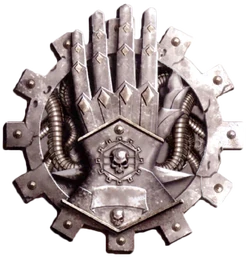
Chapter Badge of the Iron Hands
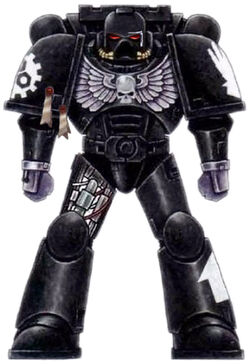
Iron Hands Chapter Colour Scheme
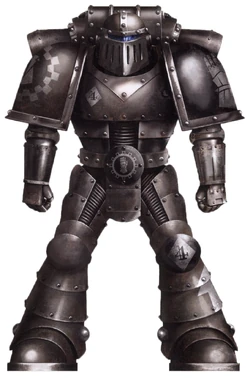
Pre-Heresy Iron Hands Legion Colour Scheme
The Hammer and the Storm
The martial history of the X Legion is a relatively well-documented one, about which a great deal still survives on record in the present era (in marked contrast with some of the others). Alongside the other proto-Legions created by the Emperor of Mankind during the latter days of the Unification Wars on Ancient Terra in the late-30th Millennium, they were prepared and armed in preparation for the great work ahead, and their initial outfitting and organisation followed closely to the standard patterns set for the Legiones Astartes at the start of the Great Crusade. Their recruitment base is noted as being relatively widespread, with elements drawn from all over Ancient Terra, both from areas of the Qavitine Plate cities, and from former enemy blocs such as the Solus Stellax. In particular, the warlike culture and renowned brutality of the population of Old Albia, which supplied substantial numbers of recruits for the X Legion, had a great deal to do with the Legion's early character (as it also did for the XIV Legion), lending them a fierce pride in a warrior ancestry that predated the Legion's Founding.
Utilised as part of larger Legion taskforces in the closing stages of the battles on Ancient Terra itself, its first individual battle honours are recorded in the wider Sol System against the mutant "Scythers" of the deep-orbiting Mican Aggregation and in the extermination of the xenos Lyasx enclave hidden beneath the ice of Oberath. In both of these prior engagements, the X Legion had proved itself a remorseless and fiercely discipline attacking force, fully capable of operating with remarkable co-ordination and tightly focused wrath to achieve tactical and strategic aims. On both occasions, the Legion had defeated a powerful foe with relatively few losses despite very heavy resistance and while operating in environmentally hazardous conditions. Because of the constraints of these two battle environments -- the first being a human-made Space Hulk, and the second, the airless and frozen caverns of a Dead World -- these victories, while notable, did not serve to distinguish them yet in the particular style of warfare to which they would later become most famed.
Instead it would take the Legion's third large-scale engagements -- the invasion of the planet designated 02-34 (or the "Battle of Rust" as it would be commonly known to Imperial military historians) -- to show the X Legion's particular martial gifts for what they were, and would do so with empathic force. Planet 02-34, or "Rust" to give its colloquial name, was an arid waste world, rich in pyro-chemical deposits, oxide deserts and the corroded remnants of vast, long-dead cities. In order to exploit these resources, the Orks of the powerful and expanding "Krooked-Klaw" empire of Wardog Kulo, a Greenskins empire which spanned more than sixty inhabited star systems to the galactic northeast of Seraphina, had made Rust a slave-mining colony comprising millions of Orks and a vast, shifting population of short-lived human slaves harvested in inter-stellar raids. Scouted out by the Rogue Trader Hedrik Zuckermann and identified as a primary target of the early Great Crusade, it was into this alien domain that the combined forces of the Legions, with the Emperor at their head, slammed with devastating force in 807.M30 in what was, at that early stage, the most widespread mass offensive of the era.
Setting the future pattern for attacks upon widely spread Ork territories, the Seraphin Offensive utilised the forces of eleven entire Space Marine Legions and hundreds of Imperial Army battle groups to assault scores of Ork-held worlds as simultaneously as the vagaries of Warp transit would allow, keeping the xenos forces fragmented and isolated so that they could be destroyed in detail. The task of taking the strategic world of Rust and the liberation of the enslaved human population there (thought to number almost a billion by some estimates) was entrusted to the X Legion, supported by two secondary battle groups, one comprised of the Urshan Velites of the Imperial Army and one comprising the Halgentine Covenant of the Legio Cybernetica.
Having already measured themselves against the savage threat of the Ork race in lesser battles previously, the massed forces of the X Legion, under the generalship of their Lord Commander Amadeus DuCaine, formulated a plan of attack which owed much to the feared and pitiless battlecraft of Old Albia; a tactic known as the Hammer and the Storm. After forcing a landing via the brute power of their warships from orbit, DuCaine ordered the Urshan soldiery to make planetfall in full strength. He had them form up in a triangular deployment zone, many kilometres on each side of the wasteland plain between the three largest Ork settlement-fortresses in the corroded cityscapes and dig in. In this they had successfully "raised the storm"; the Orks, bestirred in their millions by the attack from above and, ever-warlike, poured from their warrens to attack the invaders.
Within only a few solar hours the plain was a bloodbath of shot and shell, mangled machinery and bomb craters swollen with broken bodies, both human and Ork. Despite pleas for reinforcements or to be allowed to retreat, DuCaine waited until he was sure the bulk of the Ork forces were fully committed -- swarming like a tide of black ants in numbers large enough to be visible from orbit like a spreading stain -- before answering with the might of his Legion. The Space Marines would be the hammer to the Urshans' storm. Using gunships and assault landers to blast through the hurricane of flak and wings of Ork aircraft which vulture-swept the skies above the battle, the X Legion tore open a hole into the bloated body of the Ork horde and deployed its full armoured might into a single massed spreahead, comprised in the main of heavy Malcador, Mauler and Land Raider tanks. In the shadow of these armoured giants, the Legion's squads and Dreadnoughts formed in close and disciplined ranks. Moving forward as a single, slow-moving mass, lashing out a relentless torrent of firepower, the Legion went in unison like some immense harvesting machine through a field of ripe grain, destroying everything in its path. It rushed forward perpendicular to the half-overrun Imperial defence lines, the Legio Cybernetica and the Legion's own rapid-moving skimmer and Jetbike squadrons spreading out in its wake to terminate any pockets of survivors and guard the hammer's flanks and rear.
On and on the Orks came to fight and to die. In response, the X Legion re-armed and re-formed, meeting them in open counter-attack, unleashing their pent-up bloodlust and rage on the enemy until the wasteland plain was choked with bodies and broken war machines. After days of near-continuous fighting, the waves of alien assault grew fewer and fewer between, until they guttered and stopped at last. The Orks of Rust had not lost the will to fight, but had simply run out of blood and machinery to spend. At the end of the battle, the X Legion had suffered less than a fifth of its number in fatalities; a far lower figure than might have been expected if it had been forced to attack the ancient warren-tunnelled cityscapes and take them one-by-one in gruelling attrition. The Urshan had also suffered heavy losses in the battle's opening stages, but afterwards they had been employed principally only in guarding the landing zones and supply lines while the X Legion fought, and many had ultimately been spared, leading to Rust being hailed as a great triumph also on account of how little had been sacrificed to attain it.
Having gained much renown on Rust, the X Legion went on to practice the Hammer and Storm tactic again successfully elsewhere against the Orks during the Seraphina Offensive, and from it gained a reputation for remorseless, highly-coordinated warfare and a particular fame for successfully prosecuting "set-piece" battles incorporating close armoured-vehicle support soon followed the Legion. The X Legion's developing strategies were studied and indeed copied to varying degrees of success by several other Legions, such as the IV Legion and the XIII Legion in the campaign against the Krooked Klaw Orks and thereafter. This emulation was not universal however, and some Legions ignored the X Legion's success simply because they ill-suited either their temperament or fighting style (some also had already evidenced a lack of discipline of the kind that the X Legion had displayed in order to carry it off). Very quickly, with its victories and developing tactics, the X Legion was forging an identity for itself in battle, and the name "the Storm Walkers" had been coined for them by the Urshan who had come to view them with an almost superstitious awe. But what might have come of this independent progression, however, will never be known, as in a short span of years after the sundering of the Krooked Klaw empire, news came that the X Legion's Primarch had been found on a cold, merciless world named Medusa.
Ferrus Manus
"They are not my hands. This fact is forgotten by my brothers -- inexplicably, it has always seemed to me. The hands are strong, to be sure, and have created great things for us all, but they are not mine. And that counts for something. They forget that the silver on my arms comes from a beast that I vanquished. It is the mark of a great evil that I ended, and yet it persists within me...I would struggle to remove it now...I will not remove the silver from my flesh because I have learned to depend on it. The fault is with my mind. I rely on the augmentation given to me by my metal gauntlets, so much so that the flesh beneath them is now little more than a distant memory...A day will come when I will strip it from me, lest I lose the power to master myself forever. Already my Legion's warriors replace their shield hands with metal in my honour, and so they too are learning to doubt the natural strength of their bodies. They must be weaned off this practice before it becomes a mania for them. Hatred of what is natural, of what is human, is the first and greatest of the corruptions. So I record it here: when the time comes, I will strip my hands of their unnatural silver. I will instruct my Legion to recant their distrust of the flesh. I will turn then away from the gifts of the machine and bid them relearn the mysteries of flesh, bone and blood. When my father's Crusade is over, this shall be my sacred task. When the fighting is done, I shall cure my Legion and myself. For if fighting is all there is, if we may never pause to reflect on what such devotion to strength is doing to us, then our compulsion will only grow."
- —The Neimerel Scrolls attributed to the Primarch Ferrus Manus
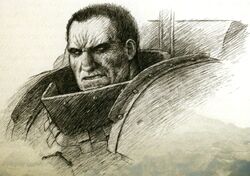
Ancient Remembrancer sketch of Ferrus Manus, Primarch of the Iron Hands Legion; illustration taken from Carpinus' Speculum Historiale
The Iron Hands were the X Legion of Space Marines, created from the gene-seed of the Primarch Ferrus Manus. At the dawn of the Imperium of Man, before the Great Crusade had begun, the 20 gene-children of the Emperor of Mankind, the Primarchs, were scattered across the known galaxy through the Warp in a mysterious accident due to the intervention of the Ruinous Powers of Chaos. The gestation capsules of all 20 Primarchs were stolen from the Emperor's secret gene-laboratory deep beneath the Himalazian (Himalayan) Mountains on Terra and were flung across thousands of light years, all eventually coming to rest on backwater human colony planets. It was this first touch of Chaos before the Primarchs had even been born that may have corrupted so many of them and laid the foundation for the agonising tragedy of the Horus Heresy that was to come. One of these infant Primarchs turned up on the dark, geologically unstable Feral World of Medusa in the Segmentum Obscurus very near to the Eye of Terror, his gestation capsule burning a trail through the cloud-dominated sky as it impacted the highest mountain on the world, Karaashi, the Ice Pinnacle. The impact shattered the mountain top, burying Ferrus deep in the ice in a tremendous explosion of steam. The land shook under the impact which could be felt the world over. Mountains were toppled and great chasms were formed as the planet rumbled under the coming of the Primarch. Medusa rumbled with such ferocity that the Medusans later said that many of the world's mountains simply shook themselves to pieces.
Years later that special infant, named Ferrus Manus by the Medusans (literally "iron handed" in the ancient High Gothic tongue), walked unscathed and already fully grown from the uninhabited mountain ranges of the far northern wastes where the Ice Pinnacle lay. The legends of the roaming clans, taught from father to son throughout the ages, revolve around the early exploits of Ferrus, who came to be regarded as a great warrior amongst the nomadic clans of Medusa. No one could match his strength of arm, try as he might to find a worthy opponent. He sought out every physical challenge that he could, always returning victorious. According to one oft-recounted myth, Ferrus once challenged a Storm Giant to a competition of strength. The giant lifted a mountain between his hands and set it back down a mile away. The giant's laugh died when Ferrus lifted the entire mountain range on his back, carrying it to a neighbouring island. The poor, humbled giant was never seen again. Ferrus travelled the length and breadth of Medusa, becoming well-known by all the clans and coming to know the land itself as no one ever had. He travelled areas that any other man would have found inaccessible. He climbed the highest mountains, he swam the deepest oceans, always pushing his levels of endurance and strength to levels unfathomable to mortal men. His strength and fury made him renowned and feared amongst the people of the clans who valued such qualities highly in their harsh environment. Ferrus was eventually adopted by the Medusan clans as one of their own. He never interfered in the various clans' conflicts, believing that such competition was healthy for his people and should be allowed to thrive. Because of this impartiality, Ferrus was ultimately accepted universally as an honourary member of every Medusan clan, and great (often exaggerated) legends like the one above were told of his deeds.
Much about the formative years of Ferrus Manus on Medusa remains unknown, not so much through any deliberate veil of secrecy perhaps, but because what was later retold by the Medusans themselves was filtered through the barbaric folk-memory of their culture, while the Gorgon himself was taciturn on the matter to any save the Emperor. There have been many who have studied the formative situations of the Primarchs who have drawn parallels between the conditions in which Vulkan found himself on Nocturne and Ferrus Manus encountered on Medusa; both were found on savage, barren worlds riven by hostile conditions and both were home to primitive cultures, long cut off from the rest of Mankind during the Age of Strife. But beyond these surface features, the two worlds and, in particular, those who dwelled upon them could not have been more different.
If what can be gleaned from the Medusan folk tales holds true, it was not into the clan-ranges he first fell in blaze of light that sundered the grey, shrouding skies of the planet, but in the northern polar regions, shattering Karaashi, the Pinnacle of Black Ice. This locale was one of many places the Medusans considered the accursed abodes of the malign shades of the dead and slumbering iron-skinned monsters of legend. This set the scene for the Primarch's entrance into mythic history, and the Medusan legends teach of him wandering the northern realms, casting down hulking storm giants, performing superhuman feats of cunning and strength, and slaying monsters and murderous machine-creatures left relic beneath the black ice of Medusa from bygone ages of war and slaughter.
One such legend was of the titanic battle between the Primarch and Asirnoth, the Great Silver Wyrm. This tale is recounted in the Canticle of the Travels, an epic Medusan poem of unknown origin that is still taught to the children of the clans at their parents' knees. The Wyrm was said to possess a skin of living metal that was stronger than any armour. It was said that Ferrus spent many days spent tracking the beast through the legendary Land of Shadows, the fearful homeland of the ancients, a place of mystery and terror. This place, long since lost, was said to be a land forged of metal and stone relics of giant proportions, the remnants of a forgotten age in the galaxy's history. The ghost-spirits of the clans were said to roam there once they left the world of the living. Imperial academics now believe that the description of the Land of Shadows given in the Canticle makes it sound very much like the Necron ruins later encountered by the forces of the Imperium in the late 41st Millennium. As such, Asirnoth may actually have been a C'tan or Necron construct created from their Necrodermis material, which is known to act as a type of "living metal."
Ferrus was unable to defeat the beast with raw strength alone, his punches and blows having no discernible effect. Ferrus was eventually able to slay the creature, drowning it in a river of molten lava despite the agonising pain this caused him, and he bore it stoically. When Ferrus removed his arms from the lava, the Great Silver Wyrm had been completely destroyed, and he discovered that his hands and forearms were covered in the same living metal as the Wyrm's skin, which had flowed across his own flesh, protecting it, even as Asirnoth had been destroyed (or dispersed) by the heat of the molten rock. This was a substance that was as flexible as flesh yet as strong and impervious as the hardest ceramite. It is known that myths involving Ferrus and his metal hands precede the writing of the Canticle of Travels, but only in the Canticle is this explanation given as to how the living metal came to be fused to his body. The alien metal also altered the Primarch's physiology, for following the battle his eyes turned silver and seemed to lose their pupils, indicating that the necrodermis, if that is what the substance was, had also entered deep within his body. The reigning hypothesis among Imperial scholars at present is that Asirnorth was a Necron construct, some kind of guardian creature placed on the planet to protect a possible Necron Tomb or even the resting place of a true C'tan Shard, made of the "living metal" alloy the Necrons called necrodermis. It is possible that Ferrus was in some way polluted or corrupted by the Necron technology in the process of slaying the Great Silver Wyrm.
When the Gorgon, as he had become known, strode forth from the forbidden realms of sundered Medusa to batter the disparate clans of his world into submission to his overlordship, he was already thought of as a living god by its natives. But while he did not require of the Medusans worship and did nothing to encourage it, he demanded obedience to his will, and bloodily broke any who would contest his word. Nor did he quell conflict or bring peace upon the planet, but instead he gave the Iron Fathers -- the half Tech-priests, half-shamans who ministered to the clans' spiritual and technological needs -- the fruits of his own intervention in exchange for the technological secrets they had kept down the generations. Through the Gorgon's teachings the Medusan clans then forged better weapons and stronger machines with which to fight to prove their worth to survive.
Ferrus returned to the Medusan clans after his travels, filled with new and wonderful ideas, which he taught to all who wished to learn. He was able to craft strange and powerful tools and objects out of metal, shaping them with his living metal hands without even the need for a hammer or forge. Under his tutelage, the clans of Medusa became much stronger than they had been before his arrival and became capable of wonders that they never could have imagined possible. It was a time of greatness for the people of Medusa -- the civilisation of the clans advanced at a tremendous pace and the Medusan people became strong and proud.
Ferrus Manus also led the bravest warriors of the clans to delve into the frozen realms below, breaking open long-sealed vaults and intruding into ice-buried fragments of the great machine-works that had plunged from the skies in ancient days in search of salvage and strong metal. In the depths, the warrior-bands and the silver-eyed giant who led them fought degenerate mutants, living-dead cyborgs whose decayed flesh hung in tatters from corroded metal bodies, and subdued the dark-engines of the nightmare ages that had gone before to take their plunder. By the time the Emperor had come to claim him for the Great Crusade, Ferrus Manus was warlord, demi-god and sage to the people of Medusa, and it is said that he was waiting, and that he more than half-suspected the true purpose of his creation.
The Coming of the Emperor
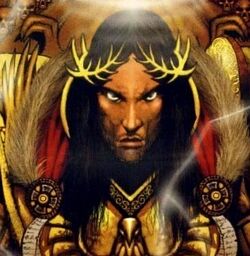
When the sky was split for a second time in the history of Medusa, the clans were confused, unsure of what this sign might represent. Without a word, Ferrus left the clans immediately and travelled to the landing site of the phenomenon. Weeks passed with no news of Ferrus, but before the clans decided what they should do in regard to discovering the fate of their saviour, the sky erupted with titanic electrical storms and the ground shook to savage earthquakes, terrifying everyone. These events lasted for eight days, after which the entire world was said to have fallen unnaturally silent. A single day later, Ferrus returned to the site of the clans' great meeting, escorting an awe-inspiring figure. Stories concerning what acts the two great men performed vary, but most revolve around the common theme of a battle or trial of powers, responsible for the unnatural storms. Whatever had happened up in the mountains, it was clear to everybody present that there was now a close bond of mutual respect between Ferrus and the Emperor, who had arrived in search of his son. The Primarch of the X Legion was among the first of the Emperor's sons to be discovered and, like Horus and Leman Russ before him, had risen to become a warlord in his own right on the world on which he had been cast. Ferrus Manus soon left with the Emperor to visit Terra, the world of his birth, and become acclimated to the customs and technologies of the Imperium of Man. Yet he promised the clans that he would always return to Medusa, the troubled world that would remain his true home.
When the Primarch of the X Legion was discovered, he was among the first of the Emperor's lost sons to be found, and, like Horus Lupercal and Leman Russ before him, had risen to become a warlord in his own right on the world on which he had been cast. So it was that Ferrus Manus' transition from planetary warlord to general of the Great Crusade was a swift one, aided by his evident hunger for the task set before him and the uncompromising intelligence and diligent application to this greater challenge he displayed. In a scant few years, Ferrus Manus was transferred full control of the X Legion which he took command of body and soul, renaming it and remaking it in his image. Sweeping away much of what had gone before by way of organisation at a stroke, the Primarch took the X Legion apart with the precision and intent with which an artisan might deconstruct a mechanical chronograph, reconfigure its components and re-assemble it in a fashion more to his liking.
When Ferrus Manus took charge of his Legion, he, like most of the other Primarchs, used his foster-world as the base and principal headquarters of his Legion. In doing this he wedded the two: the Medusan people and the Terran-founded X Legion together forcibly, creating something new that shared aspects of both that had gone before and eradicating with bloody-handed ruthlessness anything that would not yield to his will. Where once there had been Chapters as constituent units of the Legion in the Terran style, there would now be Clans, but this was not a mere symbolic union, and Terran Space Marines were ordered to displace the existing Clans' rulership both temporal and spiritual in the only way that the Medusans knew; by brute force. So the Iron Hands became the new Medusans; the Astartes walking among them as demi-gods, and the people of the nomad clans under their thrall fighting and dying not simply just to survive any more, but ultimately for their children to prove worthy to join the Iron Hands Legion's ranks.
The installation of the Iron Hands on Medusa and the establishment of Imperial Compliance over the world did little to alleviate hardship, halt conflict or undo the barbaric superstitions of the natives. Ferrus Manus saw to that, for the trials and hardships of life on Medusa would winnow the weak from the strong and see that only the physically fittest, most warlike and psychologically "suitable" recruits would join the ranks of his Legion. To counteract the potential flaw of Medusa's small population base, Ferrus Manus saw to it that on suitably recalcitrant human worlds his Iron Hands conquered by force, he exacted a tithe in perpetuity of strong male youths, taking them in early adolescence and selected at his behest by mendicant priests of the Mechanicum as tribute to Medusa: there to live, struggle, fight and survive if they were strong enough, as fresh blood for its clans. Should they prove worthy, they would become Aspirants for his Legion upon attaining their majority. So it was the bloody inheritance and bleak creed of Medusa was spread to successive generations of the Iron Hands, forging the X Legion into a weapon of unparalleled ruthlessness.
The Gorgon and the Phoenix
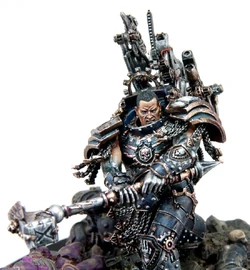
Primarch Ferrus Manus during the Great Crusade with his warhammer Forgebreaker
The brotherhood shared by the Primarchs Fulgrim and Ferrus Manus, the Phoenician and the Gorgon, was well known in the Imperium at the time of the Great Crusade, as the two superhuman leaders formed an instant connection upon their first meeting. This initial encounter occurred on Terra, beneath Mount Narodnya, the greatest forge of the Urals, where Ferrus Manus was busy toiling with the forge-masters who had once served the Terrawatt Clan during the Unification Wars soon after his arrival from Medusa. The Primarch of the Iron Hands had been demonstrating his phenomenal skill and the miraculous powers of his liquid metal hands when Fulgrim, the Primarch of the III Legion, the Emperor's Children, and his elite Phoenix Guard, had descended upon the sprawling forge complex.
Neither Primarch had yet met the other, but each had felt the shared bonds of alchemy and science that had gone into their making. Both were like gods unto the terrified artisans, who prostrated themselves before these two mighty warriors as though fearing a terrible battle might ensue between them. Ferrus Manus later told the tale to the Astartes of the X Legion claiming that Fulgrim had declared that he had come to forge the most perfect weapon ever created, and that he would bear it in the coming Great Crusade. Of course the Primarch of the Iron Hands could not let such a boast go unanswered, and he had laughed in Fulgrim’s face, declaring that such pasty hands could never be the equal of his own living metal appendages. Fulgrim accepted the challenge with regal grace, and both Primarchs had stripped to the waist, working without pause for weeks on end, the forge ringing with the deafening pounding of hammers, the hiss of cooling metal, and the good natured insults of the two demigods as they sought to outdo one another.
At the end of three months' unceasing toil, both warriors had finished their weapons. Fulgrim had forged an exquisite warhammer -- Forgebreaker -- that could level a mountain with a single blow, and Ferrus Manus a golden bladed sword -- Fireblade -- that forever burned with the fire of the forge. Both weapons were unmatched by any yet crafted by Man, and upon seeing what the other had created, each Primarch declared that his opponent’s was the greater. Fulgrim declared the golden sword the equal of that borne by the legendary hero Nuada Silverhand, while Ferrus Manus had sworn that only the mighty thunder gods of Nordyc legend were fit to bear such a magnificent warhammer. Without another word spoken, both Primarchs had swapped weapons and sealed their eternal friendship with the craft of their hands.
The weight of the formidable warhammer Forgebreaker was enormous and unbearable for anyone but one of the Emperor’s Astartes. Its haft was the colour of ebony, elaborately worked with threads of gold and silver that formed the shape of a lightning bolt, and the head was carved into the shape of a mighty eagle, its barbed beak forming the striking face and its tapered wings the claw. Anyone who looked upon the mighty warhammer could feel the power radiating from within it and know instinctively that more than just skill had gone into its forging. Love and honour, loyalty and friendship, death and vengeance...all were embodied within its majestic form, and the thought that the Iron Hands Primarch’s sworn honour brother had created this weapon made it truly legendary.
According to legend, Ferrus Manus was commonly referred to as The Gorgon. Some on Terra said the name was in reference to an ancient legend of the Olympian Hegemony. The Gorgon was a beast of such incredible ugliness that its very gaze could turn a man to stone. Many would be outraged at the disrespect in the implication of such a term when referring to a Primarch, but those who knew him best believed that Ferrus Manus quite enjoyed the name, because in any case, that was not where the name originated. It was an old nickname Fulgrim had given his brother after their initial meeting. Unlike the Phoenician, Ferrus Manus had little time for art, music or any of the cultural pastimes the III Legion's Primarch so enjoyed. It is said that after the two Primarchs met at Mount Narodnya, they returned to the Imperial Palace where Primarch Sanguinius of the Blood Angels Legion had arrived bearing gifts for the Emperor, exquisite statues from the glowing rock of Baal, priceless gem-stones and wondrous artefacts of aragonite, opal and tourmaline. The lord of the Blood Angels had brought enough to fill a dozen wings of the Palace with the greatest wonders imaginable.
Of course, Fulgrim was enthralled, finding that another of his brothers shared his love of such incredible beauty, but Ferrus Manus was unimpressed and said that such things were a waste of their time when there was a galaxy to win back. Fulgrim laughed and declared Ferrus a "terrible gorgon," saying that if the Primarchs did not value beauty, then they would never appreciate the stars they were to win back for their father. After that time the name stuck, and forever after Ferrus Manus was often referred to as The Gorgon.
The Hour of the Gorgon
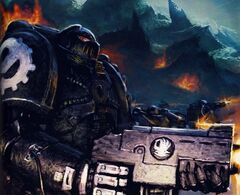
The Iron Hands subjugate a planet to bring it into Imperial Compliance during the Great Crusade
In a scant few years, Ferrus Manus was transferred full control of the X Legion which he took command of body and soul, renaming it and remaking it in his image. Sweeping away much of what had gone before by way of organisation at a stroke, the Primarch took the X apart with the precision and intent with which an artisan might deconstruct a mechanical chronograph, reconfigure its components and re-assemble it in a fashion more to his liking. The X Legion, under their Primarch's command, would become, perhaps more than any other Legion, a literal "engine of war"; a purpose-built machine -- unsubtle, efficient and dedicated to a particularly brutal and direct method of warfare. Under his tutelage and direction, the Legion's already evident preference for order and systematised combat was refocused and increased, while the Primarch, no doubt seeing an echo of his own belligerent soul within the Legiones Astartes which bore his blood, harnessed the wellspring of anger and pride which burned in the hearts of the Legion with unbreakable chains of discipline, logic and order. In response to their Primarch's own values, the newly renamed Iron Hands valued superiority in terms of weaponry and wargear as much as they did zeal, valour or discipline, and the Legion saw a concentration of technological expertise seldom matched by other Legions. Victory, by the most direct and efficient means possible was the Legion's mantra; they would be the hand that reached out and crushed the enemies of humanity, as unfeeling, relentless and coldly implacable as the Iron Hand they had so fittingly taken for their name.
From the beginning, it was clear Ferrus Manus would prove a harsh but constant overlord. The Primarch was utterly intolerant of failure and swift to anger, but also rigidly and rationally controlled in the application of the wellspring of wroth that was never far from the surface of his thoughts and actions. To his Legion -- just as he had been on Medusa to its barbaric inhabitants -- he was "the Gorgon"; a figure from myth come to life; a being whose strength and intelligence was more than superhuman, in whose veins hot metal flowed like blood and whose silver gaze it was said, could kill. Quick to scorn and rare to praise, Ferrus Manus set utterly uncompromising standards for his Legion, which he saw as an extension of his own body and will. In truth the Primarch also held himself to those same unmatchable standards and despised duplicity and dissembleage as much as he did weakness, and for these reasons, more than any others, the warriors of the X Legion loved him as sons loves a hard-hearted father, with a scrap of his praise worth more to them than any laurel of victory.
Very quickly because of the Primarch's influence, a mind-set was crystallised in the Legion that meant that failure to the Iron Hands was intolerable. Failure was weakness, and weakness was the greatest sin -- weakness had led to the terror of Old Night, just as on Medusa the weak endangered those around them in the daily battle for survival -- weakness threatened all. Where this weakness manifested in others who succumbed to degradation of the body or mind such that they denied the Great Crusade (and in doing so threatened the safety of humanity), it engendered the coldest hate in the Iron Hands. Likewise, if weakness was found in their own ranks, that of their aspirants, or in those who fought beside them, it would be purged so that only the strong remained and so were further strengthened. Such was the harsh and absolute creed the Iron Hands' father ingrained in his children.
The Legion quickly added their efforts to the Emperor's ongoing Great Crusade, becoming the heart of the 52nd Expeditionary Fleet. With the Gorgon at their head, the Iron Hands Legion quickly became renowned for its ability to confront the enemies of the Great Crusade head-on; gaining a reputation as a ruthless, calculating Legion at its strongest and most effective where the din of battle was the greatest, and the clash of arms as its most absolute and direct. Building on the talents and tactics of the X Legion had already displayed, Ferrus Manus and the Iron Hands excelled at high-intensity warfare both against technologically advanced opponents and xenos species such as the Orks, whose sheer physical power and vast numbers constituted an overwhelming threat to the success of the Great Crusade. This ability in the Iron Hands being recognised by the Emperor, and the challenge such foes represented being relished by Ferrus Manus and his Legion alike, the "Iron Tenth" as they became commonly known, was deliberately deployed to battlefronts where set-piece engagements against massed armies of advanced war machines were likely, creating a circular effect which caused the Legion to both become more specialised at its chosen field, and in ever greater demand as the Great Crusade's favoured weapon to meet this need. As a consequence of this, the Legion's common opponents in battle often included intransigent human factions who actively resisted unification and had retained some fragment of the technological might of the lost Dark Age of Technology.
In such conflicts it was common, due to strategic necessity, for the Iron Hands to fight closely alongside elements of the Mechanicum and the Titan Legions, with whom a cultural relationship inherited from Medusa was shared, and over years of battle these ties of allegiance grew. In these battles, the Iron Hands' rapidly developing skill and renown as weapon-smiths and artificers would also come into play, allowing them both to innovate new forms of armaments and defences where needed, and to quickly counter previously unknown weapons employed against them, acquiring them alongside the Mechanicum for the Imperium's later study and use as required. The Great Crusade would also see the Iron Hands serve alongside many other Legions directly, often employed as shock troops in major campaigns, as well as a senior element in a larger army group, with Ferrus Manus taking an overarching battlefield command role over other, later-found Primarchs on many occasions. The long term results of these joint endeavours would be mixed for the Legion, leading to close and lasting allegiances in some cases, as with the Emperor's Children and their Primarch, and lingering resentment and malcontent bordering on internecine strife in others, as with the Alpha Legion.
In distinct counterpoints to the Iron Hands' noted strengths, as time progressed it became clear that there were certain avenues of warfare and exigencies of the Great Crusade to which the Iron Hands were decidedly unsuited, either by doctrine or temperament. Where once on Rust, the X Legion had been mindful of the cost to the allies of their tactics, such niceties were now forgotten, viewed as weakness that would no longer be tolerated to go on; better the bloody price paid on the battlefield now, went the Iron Hands' reasoning, rather than risk the prize of unifying humanity and the peace that would bring one day. Further to their notoriety this stance brought them, particularly with elements of the Imperial Army, as the years passed the Iron Hands also gained an increasingly belligerent reputation with the fellow Legions as lacking both patience with others and subtlety of action, both in the person of their Primarch and the character of the Legion's rank and file.
While the ill-feeling these negative factors provoked in some quarters was still far from the acrimony and distrust the nearly uncontrollable bloodlust displayed by the World Eaters or the catastrophic cost of the arts of war practiced by the Death Guard engendered, or indeed the suspicions created by the fickle unpredictability of the White Scars, the Iron Hands' ruthlessness in battle and their seemingly callous indifference to the price of victory made them conquerors, not liberators. This plain fact was acknowledged both by the Iron Hands themselves and by the Emperor in employing them accordingly. It is also consequently true that Ferrus Manus and his Legion cared little for the minutiae of the Great Crusade, they saw their task as a clear one; to expand the borders of the Imperium and destroy its enemies -- nothing more -- they disdained the politics of the Imperial Court and the pursuit of glory as empty trifles, and left the task of winning over the hearts and minds of those they brought into Imperial Compliance and the rebuilding of what they had shattered to those better suited to the task. When once asked of his Legion's role in the Great Crusade, Ferrus Manus is apocryphally held to have simply said; "Make war and move on, and again, and again, until nothing breathes which stands against us. All else is sophistry and pretty lies."
As the Great Crusade progressed, the Iron Hands Legion was in constant service at the front lines of expansion, both at the head of its own battle groups, compliance and extermination taskforces, and wielded as a part of larger Expeditionary fleets, fighting alongside other Legions where needed. After more than a century under its Primarch's command, the victories of the Iron Hands could not be easily counted and, indeed, it is believed many of its battle wen unrecorded, as the Legion itself became increasingly insular in many ways, and uninterested in sharing the details of its independent operations in anything but the most perfunctory way. To the wider Imperium it presented a cold, brutal facade; the Legion as a calculating, prideful and powerful engine of war that did not stoop to deal with petty concerns or affairs of state. Such secrets the Iron Hands Legion did keep, it kept well.
The Ascension of Horus
The Ullanor Crusade was a vast Imperial assault on the Ork empire of the Overlord Urrlak Urruk during the Great Crusade. Ullanor, the capital world of this empire, and the site of the final assault, lay in the Ullanor System of the galaxy's Ullanor Sector. The Ullanor Crusade marked the high point of the Great Crusade's vast effort to reunite the scattered colony worlds of humanity. The Orks of Ullanor represented the largest concentration of Orks ever defeated by the military forces of the nascent Imperium of Man at that time. With the great victory sealed in blood and iron, the call to a Triumph was sounded, to recognise this highpoint of the Great Crusade and to honour all the warriors of the Ullanor Crusade, mortals and Astartes alike, for their extraordinary valour and service to humanity's cause. A full fourteen of the Space Marine Legions stood represented at the Ullanor Triumph, and with them came their Primarchs -- nine beings of superhuman power and majesty. In the aftermath of this Ullanor Crusade, Horus was granted the newly-created title of "Warmaster", the commander-in-chief of all the Emperor's armies who possessed command authority over all of the other Primarchs and every Expeditionary Fleet of the Great Crusade. After declaring Horus as Imperial Warmaster and the new supreme commander of the Great Crusade, the Emperor, much to the shock of those assembled, announced his own intention to return to Terra to pursue a secret project intended to benefit all Mankind. Although considered one of the finest and most senior field commanders in the Imperium, and an individual of great and sometimes barbed pride, Ferrus Manus did not display any outward signs of displeasure at Horus Lupercal's promotion above him as Warmaster, although as one of the most veteran of the Primarchs, he might have expected such consideration. Both he and his Legion continued to serve closely with the Sons of Horus after Horus' ascension and remained a key part of the Warmaster's strategic deployments throughout the dying years of the Great Crusade.
Despite being part of the Traitors' close orbit, and the fact that a particular comradeship had developed between Ferrus Manus and the Primarch Fulgrim of the Emperor's Children, the Iron Hands never became fully ensnared in the dark conspiracy of Horus' rebellion that would tear the Imperium asunder. It is of some note that the Traitors clearly did believe that such an entanglement was possible (whereas they did not with certain other Legions), although whether this was because of binding ties on the Legion Horus believed outweighed those to the Emperor, the reputation and nature of the Iron Hands Legion itself or some other unknown factor is unclear and not knowable. It is salutary to consider, however, that if this had been the case; had Ferrus Manus and the power of the Iron Hands also sided with the Traitors, then the outcome of history might well have been very different.
The Diasporex Persecution
During the latter part of the Great Crusade, the Iron Hands encountered a nomadic, fleet-based civilisation composed of both humans and xenos known as the Diasporex. The Iron Hands shared the Imperial Truth of the Emperor of Mankind and offered the human members of the Diasporex the opportunity to separate from their alien allies and to join the newly forged Imperium, but they declined the Astartes' offer. Their offer rejected, the Iron Hands passed judgement, and in the following months the Iron Hands fleet attempted to annihilate the Diasporex, but they proved to be highly skilled and experienced in the realm of naval warfare, and managed to easily evade crucial battles and even to severely damage the Iron Hands' Strike Cruiser Ferrum. The Emperor's Children of the 28th Expeditionary Fleet were called in as reinforcements, and so, a joint Imperial strike force composed of both the Iron Hands and forces from the Emperor's Children Legion launched an all-out assault against the willful Diasporex. Though the Diasporex knew that a powerful fleet of warships was hunting them and sought their destruction, they refused to leave the sector and move on to someplace safer. The Iron Hands' scout ships soon discovered the truth—the Diasporex used hidden solar collector arrays to collect fuel for their vessels from a star. This was the reason why the Diasporex remained within the sector. Attacking these vital fuel stations, the two Imperial Expeditionary Fleets drew the Diasporex fleet out into open battle as the human-alien alliance sought to avoid utter annihilation at the Imperials' hands.
During the massive naval battle that ensued Fulgrim's personal gunship, the Firebird, came under heavy attack and soon found itself in trouble. Rushing to his brother's side, Ferrus Manus' flagship, the Battle Barge Fist of Iron, came rushing to the rescue of his beleaguered brother. To restore his wounded pride, Fulgrim led a brief shipboarding action where the Emperor's Children wreaked bloody havoc on the troops of the Diasporex. But ultimate victory was robbed from him when the enemy ship's bridge was taken by one of his subordinate commanders. For months thereafter, Fulgrim would resent The Gorgon's actions, unable to truly understand the altruism of Ferrus' deed and the loss of life his selfless act had incurred on his Legion. Under the malignant influence of the daemon-possessed Laer blade that he wore at all times, Fulgrim could only see self-aggrandisement in his brother’s action, instead of the the heroic deed it had truly been. Ferrus' critical comments, the wounding darts that Fulgrim believed were meant to undermine him, were in actuality only jests designed to puncture Fulgrim's self-importance and restore his humility. What Fulgrim perceived as Ferrus’ prideful boasts and rash actions had been deeds of courage that he spitefully dismissed as the influence of Chaos began to claim the Phoenician's soul.
Horus Heresy
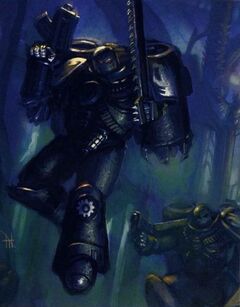
The Iron Hands Halmech Swift Assault Squad during the Horus Heresy
As the Warmaster Horus made the opening moves of his rebellion on Istvaan III, Ferrus Manus' oldest and dearest friend Fulgrim was ordered by the Warmaster to meet with the Iron Hands Primarch aboard his flagship Fist of Iron in the hope that he could be swayed to the side the Traitor Legions who now served Chaos. Fulgrim had sent the bulk of his III Legion and the 28th Expeditionary Fleet on to meet Horus and the 63rd Expeditionary Fleet in the Istvaan System while he and a small force aided the Iron Hands' 52nd Expeditionary Fleet in retaking the world of Callinedes IV from Orks. Great bonds of friendship and brotherhood had long existed between the two Legions, and Fulgrim felt that he could convince Ferrus of the righteousness of Horus' cause. Fulgrim's hope proved disastrously wrong and the meeting of the two Primarchs in Ferrus's private inner sanctum in his flagship's Anvilarium did not go well, as Ferrus was utterly outraged that his brothers would turn against their father the Emperor. The meeting ended in violence as The Gorgon made his difference of opinion over continued loyalty to the Emperor known to the Phoenician with his weapons, determined to stop Fulgrim's betrayal of the Imperium before it could begin. Ferrus attempted to use his silvery necrodermis hands to destroy Fulgrim's golden sword Fireblade, but the resulting explosion knocked him unconscious.
Fulgrim intended to kill his unconscious brother with the weapon he had forged for him, the warhammer Forgebreaker, but proved unable to kill his oldest friend despite the promptings of the Slaaneshi daemon that now corrupted his soul. Instead he took the wonderous weapon that he had once crafted in brotherhood for Ferrus as a reminder of their former friendship, and left behind Fireblade, which Ferrus had forged for him. When Fulgrim emerged from Ferrus' inner sanctum, he gave a signal to his elite Phoenix Guard, who instantly beheaded all of the Iron Hands Morlocks Terminators who served as Ferrus' own elite bodyguard with their Power Halberds. The Emperor's Children also nearly slew the Iron Hands' First Captain Gabriel Santor. Fulgrim successfully fled the Iron Hands' expeditionary fleet in his personal assault craft, the Firebird, as he ordered his warships, the Battle Barge Pride of the Emperor and its Escorts, to open fire upon the ships of the 52nd Expeditionary Fleet. This surprise attack crippled the Iron Hands force and provided a distraction while Fulgrim and the Emperor's Children warships fled into the Warp to rendezvous with the rest of their 28th Expeditionary Fleet in the Istvaan System.
Overcome with mind-numbing rage at such treachery, Ferrus and his warriors gratefully received the Emperor's orders through his brother Rogal Dorn. Together with the Raven Guard and Salamanders Legions, the Iron Hands were to confront Horus and his lieutenants on the world of Istvaan V and crush them utterly. A second wave, comprising the Night Lords, Iron Warriors, Alpha Legion and a contingent from the Word Bearers Legions, would follow them and support their initial attack. The Imperial fleet managed to make orbit over Istvaan V and the Loyalist Legions proceeded with their planetary deployment. Thousands of Drop Pods and Stormbirds were deployed for the assault. The first wave was under the overall command of Ferrus Manus and besides his own Legion, the Iron Hands, the Loyalist forces included the Salamanders led by Vulkan, and the Raven Guard under the command of Corax. Vulkan's Legion assaulted the left flank of the Traitors' battle line while Ferrus Manus, First Captain Gabriel Santor, and 10 full companies of elite Morlock Terminators charged straight through the centre of the Traitor Legions' lines. Meanwhile, Corax's Legion hit the right flank of the enemy's position. The odds were considered equal; 30,000 defending Traitor Astartes against 40,000 Loyalists. Horus was aware of the location of the Loyalists' chosen drop site and his troops fell upon the Loyalist Legions.
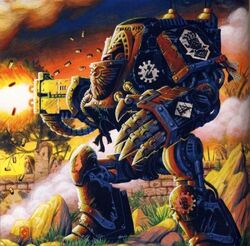
Iron Hands Contemptor Pattern Dreadnought in combat during the Drop Site Massacre on Istvaan V
The battlefield of Isstvan V was a slaughterhouse of epic proportions. Treacherous warriors twisted by hatred fought their former brothers-in-arms in a conflict unparalleled in its bitterness. The mighty Titan war engines of the Machine God walked the planet’s surface and death followed in their wake. The blood of heroes and traitors flowed in rivers, and the hooded Adepts of the Dark Mechanicum unleashed perversions of ancient technology stolen from the Auretian Technocracy to wreak bloody havoc amongst the Loyalists. All across the Urgall Depression, hundreds died with every passing second, the promise of inevitable death a pall of darkness that hung over every warrior. The Traitor forces held, but their line was bending beneath the fury of the first Loyalist assault. It would take only the smallest twists of fate for it to break.
The second wave of "Loyalist" Space Marine Legions descended upon the landing zone on the northern edge of the Urgall Depression. Hundreds of Stormbirds and Thunderhawks roared towards the surface, their armoured hulls gleaming as the power of another four Astartes Legions arrived on Isstvan V. Yet the Space Marine Legions of the reserve were no longer loyal to the Emperor, having already secretly sworn themselves to Chaos and the cause of Horus. The Night Lords of Konrad Curze, the Iron Warriors of Perturabo, the Word Bearers of Lorgar, and the Alpha Legion of Alpharius represented a force larger than that which had first begun the assault on Isstvan V. The secret Traitor Legions mustered in the landing zone, armed and ready for battle, unbloodied and fresh.
Though the Iron Hands, Raven Guard and Salamanders had managed to make a full combat drop and secured the drop site, known as the Urgall Depression, they did so at a heavy cost. Overwhelmed with rage, the headstrong Ferrus Manus disregarded the counsel of his brothers Corax and Vulkan and hurled himself against the fleeing rebels, seeking to bring Fulgrim to personal combat. His veteran troops—comprising the majority of the X Legion's Terminators and Dreadnoughts -- followed. What had begun as a massed strike against the Traitors’ position was rapidly turning into one of the largest engagements of the entire Great Crusade. All told, over 60,000 Astartes warriors clashed on the dusky plains of Isstvan V. For all the wrong reasons, this battle was soon to go down in the annals of Imperial history as one of the most epic confrontations ever fought.
Fulgrim smiled as his brother Ferrus Manus renewed his attack into the heart of the Traitors' defensive lines atop the Urgall Depression. Backlit by the flaring strobe of battle, his brother was a magnificent figure of vengeance, his silver hands and eyes reflecting the fires of slaughter with a brilliant gleam. For the briefest second, Fulgrim had been sure that Ferrus would pause to muster with the Raven Guard and Salamanders, but there would be no restraining his brother's aggrieved sense of honour. Around the Phoenician, the last of the Phoenix Guard awaited the blunt wedge of the Iron Hands, their golden halberds held low and aimed towards their foes.
Ferrus Manus and his Morlocks charged through the shattered ruin of the defences, his black armour and their burnished plates scarred and stained with the blood of enemies. Fulgrim’s fixed smile faltered as he truly appreciated the depths of hatred his brother held for him and wondered again how they had come to this point, knowing that any chance for brotherhood was lost. Only in death would their rivalry end. The Iron Hands pushed through the defences, the bulky Terminators unstoppable in their relentless advance. Lightning crackled from the claws of their gauntlets and their red eyes shone with anger. The Phoenix Guard braced themselves to meet the charge, fully aware of the power of such mighty suits of armour. The Phoenix Guard answered with a terrible war cry and leapt to meet the Morlocks in a searing clash of blades. Electric fire leapt from the golden edges of the halberds and the Lightning Claws of the warriors, and a storm of light and sound flared from each life and death struggle. The battle engulfed the Primarch of the Emperor’s Children, but he stood above it, awaiting the dark armoured giant who strode untouched through the lightning shot carnage as brothers hacked at one another in hatred. Ferrus had long dreamt of this moment of reckoning, ever since Fulgrim had come to him with betrayal in his heart. Only one of them would walk away from their final confrontation.
Death of Ferrus Manus
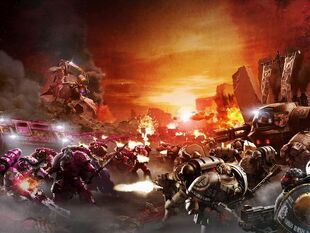
Ferrus Manus confronts Fulgrim amidst the backdrop of the Drop Site Massacre of Istvaan V during the Horus Heresy
Ferrus taunted Fulgrim for his betrayal of the Emperor and siding with the Traitor Horus. He thought his brother mad, for the Warmaster was defeated—his forces routed and the power of another four Legions would soon be brought to bear to crush their attempt at rebellion utterly. Unable to contain himself any longer, Fulgrim shook his head, savouring the final act of betrayal to come, revealing to Ferrus that it was he who was naive. Horus would never be foolish enough to trap himself like this. He pointed out towards the northern edge of the Urgall Depression so that Ferrus could see that it was he and his fellow Loyalists who were undone. Ferrus looked and saw a force larger than that which had begun the assault during the first wave of attack, mustered in the landing zone, armed and ready for battle.
Dragging their wounded and dead behind them, Corax and Vulkan led their forces back to the drop site to regroup and to allow the warriors of their recently arrived brother Primarchs of the second wave a measure of the glory in defeating Horus. Though they voxed hails requesting medical aid and supply, the line of Astartes atop the northern ridge remained grimly silent as the exhausted warriors of the Raven Guard and Salamanders came to within a hundred metres of their allies. It was then that Horus revealed his perfidy and sprung his lethal trap. Inside the black fortress where Horus had made his lair, a lone flare shot skyward, exploding in a hellish red glow that lit the battlefield below. The fire of betrayal roared from the barrels of a thousand guns, as the second wave of Astartes revealed where their true loyalties now lay. Ferrus looked on in stunned horror as Fulgrim laughed at the look on his brother's face as the forces of his "allies" opened fire upon the Salamanders and Raven Guard, killing hundreds in the fury of the first few moments, hundreds more in the seconds following, as volley after volley of Bolter fire and missiles scythed through their unsuspecting ranks.
Even as terrifying carnage was being wreaked upon the Loyalists below, the retreating forces of the Warmaster turned and brought their weapons to bear on the enemy warriors within their midst. Hundreds of World Eaters, Sons of Horus and the Death Guard fell upon the veteran companies of the Iron Hands, and though the warriors of the X Legion continued to fight gallantly, they were hopelessly outnumbered and would soon be hacked to pieces. Ferrus Manus turned to face Fulgrim, his teeth bared with the volcanic fury of his homeworld. The two Primarchs leapt at one anther, Ferrus wielding Fireblade and Fulgrim holding Forgebreaker. Their weapons had been forged in brotherhood, but were now wielded in vengeance, meeting in a blazing plume of energy. The two Primarchs traded blows with their monstrously powerful weapons, Ferrus Manus wielded his flaming blade in fiery slashes, his every blow defeated by the ebony hafted hammer he had borne in countless campaigns. Both warriors fought with the hatred only brothers divided could muster, their armour dented, torn and blackened by their fury.
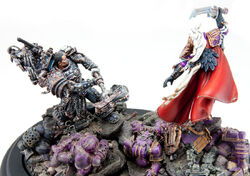
Ferrus Manus and Fulgrim confront one another for the last time
The two Primarchs traded terrible blows, wounding one another deeply during their fierce struggle. As Ferrus pushed himself to his feet and staggered towards the wounded Fulgrim, he cried out as he brought the flaming blade towards his brother's neck. But Fulgrim lashed out as he drew the single-edged, daemonically-possessed sword he had taken from the Laer temple and blocked the descending weapon. With the power of Chaos streaming from the blade, diabolical strength flooded Fulgrim's limbs as he pushed against the power of Ferrus Manus, feeling his brother's surprise at his resistance. Fulgrim managed to surge to his feet and lashed out, his silver blade biting deep into the breastplate of Ferrus' armour, and the Primarch of the Iron Hands cried out, falling to his knees once again. Fireblade slid from his grasp as he gasped in fierce agony. As Fulgrim raised the silver sword in preparation of delivering the deathblow to Ferrus Manus, he found that he did not possess the fortitude to deliver the killing blow. In an instant he saw what he had become and what monstrous betrayal he had allowed himself to be party to. He knew in that eternal moment that he had made a terrible mistake in drawing the sword from the Temple of the Laer, and he fought to release the damnable blade that had brought him so low.
His grip was locked onto the weapon and even as he recognised how far he had fallen, he knew that he had come too far to stop, the realisation coupled with the knowledge that everything he had striven for had been a lie. As though moving in slow motion, Fulgrim saw Ferrus Manus reaching for his fallen sword, his fingers closing around the wire-wound grip, the flames leaping once more to the blade at its creator’s touch. Fulgrim’s blade seemed to move with a life of its own as he swung the blade of his own volition. Fulgrim tried desperately to pull the blow, but his muscles were no longer his own to control. The daemonic blade sliced through the genetically-enhanced flesh and bone of one of the Emperor's sons. The Iron Hands' Primarch fell to the ground, his head decapitated. Ferrus Manus was dead by his brother's own hand and his Legion nearly shared his fate. A small group of surviving Iron Hands managed to elude the Traitors' closing trap and flee off-world, but the X Legion had been shattered in body and spirit and would play no further role in the Horus Heresy as it moved to recover from its critical losses at the Drop Site Massacre.
The fate of their Primarch was a mystery to the Legion as his last known position was overrun by hordes of screaming enemy warriors. What became of the great Primarch Ferrus Manus would remain a mystery to the Astartes of the X Legion. Their enemies proclaimed the Iron Hands’ Primarch dead upon the blasted wastes of Istvaan V, but the X Legion refused to accept this for no body was ever recovered, and many Iron Hands Astartes believed that Ferrus had somehow survived. One particular Imperial legend tells that his wrecked body was rescued and restored, and that he took refuge on Mars where he resides still, though this is violently refuted by the Iron Hands themselves. Their Primarch lost, the Iron Hands despaired as to the fate of Mankind. Their distress and confusion grew further when they learned that the Emperor had fallen in a titanic battle with the corrupted Horus. For the next 10,000 Terran years, the sons of Ferrus Manus would continue to stoke the unquenchable fires of their hatred, drawing strength from their bitterness and awaiting with faithful devotion the day of their Primarch’s return.
Iron Over Flesh
Just as falsehoods and myths have grown up around the death of Ferrus Manus, so too have such myths persisted about the fate of his remains. While many believe that the head of the Iron Hands Primarch was presented to Horus by Fulgrim after he was slain, other tales claim that it and the rest of his remains were given as a gift to, or perhaps stolen by, agents of the Dark Mechanicum with the goal of creating their own fearful Legion of twisted Astartes from his genetic makeup. Others believe that at some later date his body was recovered in whole or in part by his sons, while some scions of the Iron Hands quest for it still. The Iron Hands have refused to accept the fact of their Primarch's death, choosing instead to believe that he had somehow escaped the massacre on Istvaan V and would one day return. Such delusional solace did little to aid them in the wake of the massacre, however, and with their Primarch "lost" and the Legion crippled, they returned to Medusa full of bitterness. None were immune to their ire, not aliens, not Traitors, and on a few occasions, not even their allies. The Iron Hands harboured a special resentment for the Salamanders and Raven Guard, believing that had they followed Ferrus instead of retreating, the Traitors would have been defeated. The Iron Hands also developed a self-loathing, blaming both their own veterans and even their Primarch for the Isstvan V defeat. They saw that Ferrus' disastrous tactical decisions in the battle had been based on emotion instead of logic, and that those Iron Hands who had fought that day lacked the psychological and physical strength they needed to prevail. As a result of this, the Iron Hands set about purging those weaknesses from themselves over the millennia that followed, smothering their anger with cold reason and accelerating the process of augmenting their flesh with cybernetics.
Angel Exterminatus
As Horus’ rebellion ground on, the Iron Warriors took the time to humble their great enemies, the Imperial Fists, upon the isolated world of Hydra Cordatus that the Sons of Dorn had recently brought into Imperial Compliance. Following their victory, word reached Perturabo that Fulgrim and his Emperor's Children Legion, wished to rendezvous with him to discuss something of great import. Though the Phoenecian had yet to reveal the true purpose of his visit, he had promised Perturabo that it was "wondrous." Perturabo knew that his brother had a flair for the melodramatic, which only seemed to have gotten worse since the III Legion threw their lot in with the Warmaster. The Lord of Iron counted none of his fellow Primarchs as close, but the Phoenician’s adherence to perfection in all things had once provided common ground between the two superhuman warriors and allowed them to talk as trusted comrades-in-arms if not beloved brothers. What the Emperor’s Children had sought with constant movement towards the attainment of perfection, the Iron Warriors earned with rigid discipline and methodical planning; two divergent paths to the same ultimate goal.
Perturabo believed Fulgrim's visit had something to do with the inevitable campaign to be conducted against Mars. The Warmaster needed the Martian theatre fully secured before they moved against Terra, and he believed that Fulgrim was there to seek the Iron Warriors' aid in breaking open the forge-cities of the Mechanicum. If he was right, Perturabo wanted his Legion to have a plan in place to achieve that objective. Until the Iron Warriors received further orders, Perturabo would humour his brother and listen to what Fulgrim had to say. While making plans for the upcoming campaign, Perturabo received word that the Emperor's Children had arrived, unannounced, on the surface of Hydra Cordatus. Over three hundred drop-craft had landed beyond the mouth of the valley where the Iron Warriors had made their encampment.
The IV Legion quickly gathered in formation to honour the III Legion with a vanguard to receive them. Battalions of Thorakitai Imperial Army troops stood ranked in their tens of thousands. Before them stood two hundred Grand Battalions of Iron Warriors, fifty thousand warriors in amberdust-burnished warplate. Such a display of might and magnificence had not been seen since the slaughter unleashed upon the black sands of Istvaan V. Yet Perturabo and his senior officers looked on in awe at the gaudy cavalcade of noise, colour and spectacle that emerged from the III Legion's drop site into the valley. Fulgrim and his Emperor’s Children were now completely unrecognisable from the honourable warriors that had once formed the III Legion. Perturabo knew something fundamental had changed within the Emperor’s Children, but could not imagine what purpose the disfigurements and degradations its warriors now sported could possibly serve.
Fulgrim met with his brother Primarch in the private inner sanctum of his command bunker with an enticing offer that Perturabo could not refuse; the means to make it so that the Lord of Iron's every desire could be made real and would never disappoint, never fail to live up to his fondest expectations, and never, ever be eclipsed. Fulgrim came with an offer to unite their mutual forces in battle on a glorious quest. One that might tip the balance of the Warmaster’s rebellion. Though Perturabo was suspicious of his brother's intentions, perhaps this joint venture would grant understanding through common cause. Fulgrim revealed his purpose; they were to venture to the Warp Storm that had plagued Perturabo's dreams all of his life. Within it was hidden an ancient and forbidden xenos weapon known as the Angel Exterminatus. It had been hidden in the grave of its doom, a weapon of such power that the stars themselves turned upon it rather than allow it to escape its prison.
Sisypheum
Unknown to both the Emperor's Children and the Iron Warriors, they were being pursued by a ragtag group of Loyalist Astartes who were survivors of the Drop Site Massacre of Istvaan V and were determined to stop the Traitors at all costs. These Loyalist Space Marines were gathered from survivors that had fought their way out of the killing ground of the Urgall Depression on Istvaan V. They had managed to escape the Istvaan System aboard an Iron Hands Strike Cruiser known as the Sisypheum. Iron Hands Astartes and their mortal serfs formed the bulk of the warship's crew, but surviving warriors of the Salamanders and a single Raven Guard Astartes were also counted among their number. In the wake of the slaughter, escape from the Istvaan System had been a nerve shredding series of mad dashes under fire and silent runs through the Traitors' orbital blockade, culminating in a final sprint to the gravipause, the minimum safe distance between a star’s mass and a vessel’s ability to survive a Warp Jump. The Sisypheum had escaped the trap, but not without great cost.
The months that followed saw the Sisypheum embark on a series of hit-and-run attacks on Traitor forces on the northern frontiers of the galaxy, wreaking harm like a lone predator swimming in a dark ocean. Traitor forces seeking flanking routes through the Segmentum Obscurus were their prey; scout craft, cartographae ships, slow-moving supply hulks heavily laden with mortal troops, ammunition and weapons. Disruption and harassment were the Sisypheum's main objective until contact had been established with disparate groups of Loyalist forces that had also escaped the massacre, and a stratagem of sorts agreed upon. With the X Legion too scattered to function in a traditional battlefield role, its surviving commanders found their own way to fight back: as the thorns in the flanks of the leviathan that distract it from the swordthrust to the vitals.
At Cavor Sarta, an Iron Hand known as Sabak Wayland and the lone Raven Guard survivor Nykona Sharrowkyn had captured an Unlingual Cipher Host -- one of the so-called "Kryptos" -- a hybrid abomination creature of the Dark Mechanicum that had previously made the Traitors' code network a cryptographic impossibility to break. With the Kryptos, Loyalist commanders were able to finally access the Traitors’ coded communications. And with this knowledge, the Sisypheum's Captain, the Iron Hand Ulrach Branthan, had ordered the Sisypheum to make the circuitous journey to Hydra Cordatus and the meeting of the Traitor Primarchs that had been indicated by the cracked communications. After learning of Fulgrim's intentions to enter the Eye of Terror and recover the Angel Exterminatus, the crew of the Sisypheum made their way towards the Warp Rift, aided by a mysterious Eldar guide with the intention of thwarting the Traitors' plan to acquire the unknown xenos weapon.
Crone World
The destination of the joint fleet of Iron Warriors and Emperor's Children vessels was the lost Eldar world of Iydris, a world said to have been favoured by the goddess Lileath. Iydris was one of the legendary Crone Worlds, which once formed the heart of the lost Eldar empire before they were consumed by the creation of the vast Warp Rift that was the Eye of Terror following the birth of the Chaos God Slaanesh. The lost world was located at the heart of the Eye of Terror, somehow remaining in a fixed position keeping it from destruction in the gravitational hellstorm of a supermassive black hole that lay at the centre of the eternal Warp Storm. It was from this epicentre that the galaxy vomited unnatural matter into the void, a dark doorway to an unknowable destination and an unimaginably powerful singularity whose gravity was so strong that it consumed light, matter, space and time in its destructive core.
Their ultimate goal was within the Primarchs' grasp; the Sepulchre of Isha's Doom, which sat at the centre of the citadel of Amon ny-shak Kaelis. The citadel stood astride the entrance to the prison tomb of the Angel Exterminatus. Before launching a full planetary assault, the Iron Warriors launched a preliminary orbital bombardment around the citadel, a standard practise when preparing to assault a potentially hostile environment. A cone of fire gouged the surface of Iydris, burning, pounding and flattening in the blink of an eye structures that had stood inviolate for tens of thousands of Terran years. A barren ring of pulverised earth encircled the citadel of Amon ny-shak Kaelis, leaving its walls, towers and temples an isolated island cut off from the rest of the planet’s structures by a billowing firestorm of planet-cracking force. In the wake of this orbital bombardment flocks of Thunderhawks, Stormbirds, Warhawks and heavy planetary landers launched from crammed embarkation decks. Bulk tenders descended to low orbit and disgorged thousands of troop carriers, armour lifters and supply barques. Titanic, gravity-cushioned mass-landers moved with majestic slowness as two Titans of the Legio Mortis took to the field, and this was but the first wave of the invasion. Another eight would follow before the martial power of two entire Space Marine Legions and their auxiliary Imperial Army forces had made planetfall.
Amon ny-shak Kaelis
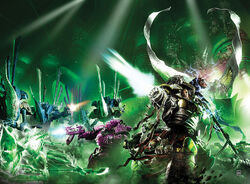
Fulgrim looks on as his Emperor's Children, his brother Perturabo and the Iron Warriors fight for their lives against an army of Eldar revenants within the Sepulchre of Isha's Doom at the heart of the citadel of Amon ny-shak Kaelis
The Traitors' assault began five hours later, despite the full circuit of fortifications still being incomplete. For all intents and purposes, the route into the citadel of Amon ny-shak Kaelis was undefended and their route unopposed. Ever mistrustful of the lack of defences, Perturabo had his Iron Warriors dug in, assuming a perfect formation outside the walls in a layered barbican that protected the Traitor Legions' line of retreat. Fulgrim’s host broke apart into individual warbands, ranging in size from around a hundred warriors to groups of nearly a thousand. Each of these autonomous groups appeared to be led by a captain, though such was the bizarre ornamentation and embellishment on each warrior’s armour, it was often impossible to discern specific rankings. Leaving the fortified bridgehead behind, Perturabo led his Iron Warriors and the Emperor’s Children contingent into the heart of Amon ny-shak Kaelis. The Sepulchre of Isha’s Doom was a monumental palace, sprawling and richly ornamented with bulbous mourn-towers and sweeping, ivory-roofed domes. As the column of Traitors pressed onwards towards the sepulchre, they were being silently and unknowingly observed by the Loyalist Astartes of the Sisypheum. Despite being outnumbered a thousand to one, the small force of Loyalist Legionaries devised a means to find another way into the massive sepulchre.
As the two Primarchs neared their ultimate goal, Fulgrim kept pressing his stern brother with curt impatience to not linger. Perturabo took the time to study Fulgrim and his assembled host. His brother was sheened in sweat, but it was not perspiration that beaded his brow, Fulgrim was sweating light. Though it was faint, it was visible to Perturabo's gene-enhanced sight that saw beyond what even Astartes eyes were capable of detecting. He wondered if Fulgrim was aware of the radiance bleeding from him and decided he must be. His brother’s armour strained against his body and his features were drawn and tired, as though only by an effort of will was he still standing. His captains looked no better, like hounds straining at the leash. A number of Fulgrim's Lord Commanders' flesh was also suffused with a light similar to that enveloping Fulgrim, a deathly radiance that had no place within a living being. Perturabo did not trust Fulgrim one bit, knowing that inevitably he would be betrayed by his brother. The Lord of Iron pressed on, intent on bringing their quest to completion. As they neared their final destination at the heart of the sepulchre, the power at the heart of Iydris spasmed in hateful recognition of the followers of Slaanesh, known to the Eldar as She Who Thirsts, and awoke its guardians from their slumber.
Thousands of crystalline statues threw off their previous immobility. They moved stiffly, like sleepers awoken from an aeons-long slumber, and the gems at the heart of their bulbous heads bled vibrant colour into glassy bodies that suddenly seemed significantly less fragile. This army of wraiths were the Eldar dead of Iydris. Soon both the Traitor forces outside the citadel as well as those inside were attacked from all sides by the revenant army. Like automata, but with a hideously organic feel to their movements, the Eldar constructs emerged in their thousands with every passing second. As Perturabo was busy fighting for his life, Fulgrim slipped away in the midst of the fighting. Realising where he had gone, the Lord of Iron stepped into the green glow emanating from the centre of the massive chamber. Perturabo understood that this was no elemental energy or mechanically generated motive force, but the distilled essence of all those who had died there.
Perturabo descended downwards on an unending spiral towards a point of light that grew no brighter no matter how far he descended. The journey downwards was never-ending, or so it seemed until it ended. Fulgrim stood at the origin of a slender bridge that arched out to the centre of a spherical chamber of incredible, sanity-defying proportions. The footings of the bridge were anchored on the equator, and a score of other bridges reached out to where a seething ball of numinous jade light blazed like a miniature sun. Iydris, it transpired, was a hollow world, its core this colossal void with the impossibly bright sun at its heart. Perturabo confronted his brother, realising that there was never an Angel Exterminatus. Fulgrim confirmed for Perturabo that there was no such weapon yet, for he was to be the Angel Exterminatus. Perturabo responded that his brother always did have an appetite for rampant narcissism, but this was the grandest delusion yet. Unamused at Fulgrim's explanation, Perturabo took a step towards his brother, Forgebreaker in his hand, intent on killing him. Fulgrim spoke a single word, its nightmare syllables tore at Perturabo's brain, causing him to stumble and drop to one knee. Fulgrim revealed the reason for his brother being drained of energy.
When Fulgrim had arrived on Hydra Cordatus he had presented the Lord of Iron with a gift; a folded cloak of softest ermine, trimmed with foxbat fur and embroidered with an endlessly repeating pattern of spirals in the golden proportion. A flattened skull of chromed steel acted as the fastener. Set in the skull’s forehead was a gemstone the size of a fist, black and veined with hair-fine threads of gold. As they had made their way towards the heart of the Eye of Terror, the large gemstone at the centre of the skull-carved cloak pin had changed from black to a solid gold colour and pulsed with its own internal heartbeat. This was the maugetar stone, known as the harvester, which had slowly been draining Perturabo's strength and life force. With the Lord of Iron's sacrifice, Fulgrim would finally be able to achieve apotheosis. The two Primarchs ascended upwards within the shaft of light, emerging into the chaos that was happening within the heart of the sepulchre.
Apotheosis of Fulgrim
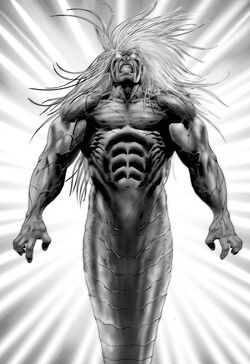
Fulgrim achieves apotheosis, becoming a Daemon Prince of his patron god Slaanesh
The Primarch of the Emperor’s Children hurled his brother aside, and Perturabo fell in a languid arc to land with a crunch of metal and crystal at the edge of the shaft. Blood trailed the air in a streaming red arc from Perturabo’s chest. The Lord of Iron lay unmoving, his body broken and lifeless. The attention of every Astartes within the chamber was irrevocably drawn towards the Primarch, for they recognised that an event of great moment was in the offing. The Phoenician was no longer the same being as had descended into the planet. He floated in the air above the shaft, which no longer poured its green torrent up to the restless darkness above, but simply radiated a fading glow of dying light. Fulgrim’s armour was shimmering with vitality, as though the light of a thousand suns were contained within him and strained to break free. The Primarch’s dark, doll-like eyes were twin black holes, doorways to heights of experience and sensation the likes of which could only be dreamed by madmen and those willing to go to any lengths to taste them.
Just as Fulgrim was about to achieve his ultimate desire, Perturabo had regained enough of his former strength and rose to his feet, the maugetar stone in his hand. Perturabo walked towards Fulgrim, keeping the hand holding the maugetar stone extended over the shaft in the center of the chamber. Perturabo looked his brother in the eye for some hint of remorse, a sign that he regretted that things had come to this, something to show he felt even a moment of shame at plotting to murder his brother. He saw nothing, and his heart broke to know that the Fulgrim he had known long ago was gone, never to return. He had not thought it possible that anyone could plunge so far as to be beyond redemption. Perturabo knew that Fulgrim no longer wanted to be an angel, he wanted to be a god. He informed the Phoenician that Mankind had outgrown such beings a long time ago. Disgusted by Fulgrim's desires, Perturabo hurled the maugetar stone into the deep shaft.
Suddenly, a barrage of Bolter fire erupted and a handful of Emperor's Children Astartes were pitched from their feet. Black-armoured Space Marines bearing a mailed fist upon their shoulder guards charged towards the Traitors. It was the Astartes of the X Legion, the Iron Tenth -- the Iron Hands. Soon the battle was joined, as Loyalist fought Traitor within the expansive chamber. The noose of battle was closing on the two Primarchs at its centre -- Perturabo locked on his knees, and Fulgrim hovering in the air as though bound to his brother by ties not even the call of war could break. The Iron Hands were mired in battle with the Emperor’s Children and Iron Warriors, zipping streams of fire blasting back and forth between them. During the battle, one of the Loyalist Astartes, the Raven Guard named Sharrowkyn, had acquired the fallen maugetar stone. He instinctively knew that if this stone was desired by Fulgrim, then it had to be destroyed. Taking a Bolter from a fallen Emperor's Children Astartes, he aimed the muzzle at the strange gold and black stone and pulled the trigger.
The weakened Perturabo was renewed with the sudden release of his lifeforce from the Chaotic relic. Fulgrim’s body arched in sympathetic resonance, for the maugetar stone contained more than just the strength stolen from Perturabo by Fulgrim. It contained their mingled essences, a power greater than the sum of its parts, a power to fuel an ascent so brutal that only the combined life-force of two Primarchs could achieve it. Armour burned from Fulgrim’s body, flaking away like golden dust in a hurricane, leaving his monstrously swollen body naked and his flesh blazing with furnace heat. Spectral flames of shimmering pink and purple licked around his body, a hungry fire waiting to consume him the moment his focus slipped. As the Lord of Iron finally pushed himself upright and stood fully erect, he lifted Forgebreaker onto his shoulder. Fulgrim saw his death in Perturabo's eyes and grinned, knowing that his brother had to do it. Perturabo hefted Forgebreaker like a headsman at an execution and swung the mighty hammer in a wide arc, splitting the Phoenician's body wide open. It was done.
Fulgrim's body exploded under the impact of Perturabo’s warhammer, and the cry of release was a shrieking birth scream. An explosion of pure force ripped from the Phoenician’s destroyed flesh, filling the chamber of towers with a blinding light that was too bright to look upon, too radiant to ignore. Like a newborn sun, the wondrous incandescence was the centre of all things, a rebirth in fire, new flesh crafted from the ashes of the old. Every eye in the chamber was turned to the light, though it would surely blind them or drive them to madness. Through slitted fingers and shimmering reflections, the survivors of the fighting bore witness to something magnificent and terrible, an agonising death and violent birth combined. A figure floated in the midst of the light, and it took a moment for Perturabo to recognise the impossibility of what he was seeing. It was Fulgrim, naked and pristine, his body unsullied by any of the mawkish ornamentations with which he had defaced his flesh, as perfect as the day the Emperor had first conceived him. Fulgrim’s back arched and his bones split with gunshot cracks. His flesh, once so perfect, now ran fluid and malleable, his form moulding and remoulding as though an invisible sculptor pressed and worked him like clay upon a wheel. Fulgrim’s legs, extended like the man of Vitruvius, ran and lengthened, fusing together in a writhing serpent’s tail, the skin thickening and sheening with reptilian scales and segmented plates of chitinous armour. Perturabo took a step towards this thing being born from the death of his brother, all the while despairing that this was his brother.
Perturabo had destroyed Fulgrim’s mortal shell. This was an immaterial avatar of light and energy, of soul and desire. What was being done here was an act of will, a creature birthing itself through its own desire to exist. Fulgrim’s face was a mask of agonised rapture, a pain endured for the pleasure it promised. Two obsidian horns erupted from Fulgrim’s brow, curling back over his skull, leaving his perfect face as unsullied as the most innocent child. Fulgrim ascended into Chaos, a prince of the Neverborn, a lord of the Ruinous Powers, the chosen and beloved Champion of Slaanesh. As the newborn Daemon Prince departed, the first of the Traitor Primarchs to achieve daemonic apotheosis, he left his brother with a cryptic message that they would one day meet again, and both brothers would yet renew their bonds. Lifting his hands into the air, a curtain of light rose up from the ground and Fulgrim and all of his Emperor's Children Chaos Space Marines disappeared in a flare of arcane teleportation energy.
With the disappearance of the Emperor's Children, the Crone World of Iydris began to tear itself apart. The force at the heart of the world was no more. The strength of the lifeforces of the dead Eldar that had kept it safe was failing, and soon this planet would be swallowed by the unimaginable force of the supermassive black hole that lay at the heart of the Eye of Terror. Across the chasm, the remaining Iron Hands gathered up their wounded and fell back from the spreading fissures and heaving ruptures opening in the floor. They looked upon Perturabo with hatred, but decided to make their way off-world from the doomed planet. They knew that they could not fight the Lord of Iron and live through the encounter. Perturabo let the Iron Hands depart. Then he led his warriors out of the crumbling citadel. Once aboard his flagship the Iron Blood, Perturabo watched the final death throes of the Eldar Crone World.
The Iron Blood strained to break orbit, but the force at the heart of the Eye of Terror was reasserting its grip on reality with a vengeance. Many of the smaller vessels of the Iron Warriors survivor fleet that had followed the Sisypheum had already been dragged within its embrace, swallowed by the black hole’s powerful energies. Only the capital ships had engines large enough to resist the inexorable pull, but even they were only delaying the inevitable. Perturabo's Triarchs stood patiently around their lord, awaiting his orders. The Lord of Iron informed them that he always moved forward, never backwards. They would go into the black hole. Though his senior commanders believed that it was suicide, the Lord of Iron informed them that Fulgrim had promised that the two brothers would meet again. The Iron Warriors were not meant to die within the Eye, and there was only one way onwards. His men moved to carry out his order, and the Iron Warriors fleet plunged deep into the heart of Terror.
After the Heresy
Over the next 7 standard years, the Horus Heresy ran its inevitable course. Horus' forces attacked Terra, failed to defeat the Loyalists during the Siege of the Imperial Palace, and the Warmaster was killed and the mortally wounded Emperor was interred within the Golden Throne. These events drove the Iron Hands to despair as they returned to Medusa. This despair soon turned to anger against the Chaos Space Marines and the other Traitor Legions, an anger which the Iron Hands began to use as a driving force to recover from the trauma of the Drop Site Massacre. They started destroying any perceived weaknesses in themselves and others, believing they were performing a beneficial act for Humanity. They raged at themselves for not being on Terra in its darkest hour, believing that, had they been there, Horus would have been defeated without the Emperor's sacrifice. After the Heresy ended and the Second Founding divided up the X Legion, the Iron Hands chose to isolate themselves from the other Chapters of the Adeptus Astartes on Medusa, leaving them to their own business and maintaining minimal contact even with their own Successor Chapters.
The Keys of Hel
The Iron Hand's obsession with strength and the elimination of physical and mental weakness led them to revere the machine and distrust the failings inherent in flesh. While other Space Marine Legions were bound in metal and laboured to create great machines of war, for the Iron Hands, inculcated in their own idiosyncratic beliefs inherited from the Cult Mechanicus' influence on Medusa, the machine was not merely an appendage to flesh but its inheritor. To them their Emperor-augmented transhuman bodies were neither more nor less than a living machine of blood and gristle made for war, a machine which could be repaired and improved upon as opportunity allowed and need commanded.
To be as strong as iron was the fire that drove the Iron Hands, and to speed recovery times cybernetic replacements, swifter by far to employ than the genetic regeneration and vat-grown transplant techniques commonly used by the Legiones Astartes, were favoured, and were capable of getting a fallen or severely injured Legionary back into the fight with frightening speed. As a result, no Iron Hands Legionary who had served in battle for any length of time was wholly without bionic augmentation, and such implants were marks of honour, and often improved and augmented away from the battle's pressing need. Some of the most veteran among the Iron Hands went so far that they were little more than machines cradling shreds of their former humanity. So it was with them that to be interred within a Dreadnought body and therefore be allowed to fight for their Primarch and the great cause of unifying humanity forever, was the highest honour any member of the X Legion could aspire to.
But there were limits to what even Ferrus Manus would countenance and, while he lived, certain mysteries of cybermancy such as the true rites of cybernetic resurrection remained proscribed as nightmare sciences of the Dark Age of Technology. Where such elements of them were encountered by the Iron Hands Legion during the Great Crusade (and indeed alone among the Legions they could easily recognise them for what they were), they were seized and suppressed by the Primarch's express order and withheld, it was rumoured, even from the Mechanicum. Whispers remained of such horrors as the Agesine Protocols, the Eight Sleepers, and the damned Sarcosan Formulae; all remained locked under the covenants of the so-called Keys of Hel, named for the mythic goddess of the Medusan pantheon. Kept deep within the vaults of Medusa and sunk in chambers on airless rocks orbiting lifeless star systems where none save a select few of the Iron Fathers of the X Legion knew of their location, they were put beyond reach but not destroyed. After the death of Ferrus Manus, however, some saw his resistance to a wider supplanting of flesh with steel as one of the flaws that had allowed him to be destroyed by the Traitors; that the impetuous rage that led him to his death was born of flesh and that flesh had failed him. Thereafter, in the dark times that followed, some among the Iron Hands saw virtue in what had once been forbidden and, it is said, turned the Keys of Hel -- and opened the path to heretekal damnation.
The Moirae Schism
During the turbulent times of the Nova Terra Interregnum which took place during the early 35th Millennium, the Imperium was fractured into a number of different warring factions. The Adeptus Mechanicus was also affected during this Interregnum by division and internal warfare brought about by doctrinal differences and competing centres of power. One of the most discordant of these conflicts was the Moirae Schism, a dogmatic battle between the Martian Orthodoxy of the standard Cult Mechanicus and a far more radical creed based upon the prophetic writings of a triad of tech-mystics from the minor Forge World of Moirae. The Moirae Schism was one of the most divisive and widespread doctrinal conflicts to afflict the Adeptus Mechanicus since the Horus Heresy. These heretical writings spread like wildfire through the demesnes of the Mechanicus even after Moirae was reduced to a cinder by the Fabricator-General of Mars' Rectification Fleet.
The Moirae tech-creed was based on the prophetic wave calculations of the triad of tech-mystics who believed that they had discerned a series of predictive patterns within the micro-fluctuations of the Astronomican's psychic beacon. They believed that these geometric patterns contained the word of the Omnissiah and the God-Emperor from which the skein of future history and humanity's destiny could be read. These radical teachings included veiled references to the future overthrow of the Priesthood of Mars and the fusion of the Cult Mechanicus and the Ecclesiarchy into a unified ecclesiastical hierarchy that would govern Mankind. Such claims were predictably treated as dark sedition by the Mechanicus authorities on Mars and civil war was soon sparked between the Orthodox and radical elements of the Mechanicus.
Chapter Schism
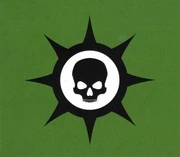
Sons of Medusa Chapter Badge
The disruptive creed of Moirae quickly gained influence; within the Mechanicus priesthood, a number of Tech-Guard regiments and even some Titan Legions turned on the Mechanicus status quo before the conflict was transmitted even further afield to Space Marine Chapters with close ties to the Adeptus Mechanicus—and in this the Iron Hands were no exception. Championed by the infamous Omnissian mystic, the Iron Father Setol Sollex, a significant percentage of those within the Chapter embraced the radical doctrines of Moirae. As discord followed, the Iron Hands were faced with the prospect of a full-scale religious civil war within the Chapter. This was only averted by the wise counsel of the Iron Hands' Great Clan Council, which proposed a settlement. Though deemed straightforward and harsh, their solution to avoid mass bloodshed within their ranks was a simple one—exile from the Iron Hands' homeworld of Medusa for the minority who had embraced the dissident doctrines, and a binding treaty never to raise their hands against their former brothers enacted by both sides. It is believed that fully a third of the Iron Hands brethren then departed, eventually joined in time by a handful of Space Marines from other Iron Hands Successor Chapters who shared their common beliefs in the Moirae doctrines (although evidence exists that some, such as the Red Talons, mercilessly destroyed their errant brothers over this matter, rather than suffer the dissidents to live). This exiled faction still saw themselves as wholly a part of the Imperium of Man and still full members of the Iron Hands. Therefore they still sought to perform their duties for the Emperor and destroy the enemies of the Imperium.
Operating as though still a part of their mother-Chapter, the Iron Hands' exiles continued to increase their numbers and strength, commending their gene-seed to higher Imperial authorities among the Adeptus Mechanicus and conducting their duties. They continued to use the iconography and signature equipment of the Iron Hands from which they had been outcast (with some minor variations) having further divided themselves into three new Clan Companies to support their steady increase in numbers. In the early years of the 37th Millennium, matters continued in this vein until the dawning of the Age of Redemption. During this era of the Age of the Imperium, the newly resurgent High Lords of Terra re-assembled the disparate strands of anarchy that had ravaged the Emperor's realm and purged what could not be saved. The Moirae exiles of the Iron Hands, now a separate Chapter in all but name, were weighed and judged, their record examined in minute detail as was their gene-seed for corruption, Chaotic taint or mutational deviance. The exiles were found to be loyal and untainted. As a result, by a special edict of the High Lords of Terra, the Sons of Medusa were reorganised and ratified as a Chapter of the Adeptus Astartes within the Emperor's grace in 011.M37, despite protests within the Mechanicus and the grave misgivings held by numerous other Space Marine Chapters at this violation of the standard practice for Founding a new Chapter of the Astartes.
Over the following centuries, the Sons of Medusa have earned a reputation for standing against the Emperor's foes, no matter how desperate the odds, winning for themselves the grudging respect, if not the trust, of their fellow Space Marines. Yet their reputation has been long-marred by those that would call the Sons of Medusa battlefield scavengers and carrion crows. During their lean years in exile, the Chapter developed the habit of seeking out and appropriating weapons and technology from the fallen. It is said of the Chapter by their detractors that the desire to take wargear from the dead remains an underlying motive of all their actions, and a principal reason they have never shunned combat against those Space Marine Chapters who have turned Renegade or become subject to censure by the High Lords of Terra.
Notable Campaigns
- The Fall of the Lords of Gardinaal (Unknown Date.M30) - During the Great Crusade there were many human worlds, indeed in some cases petty interstellar empires, who resisted the Imperial Truth through fear, fanaticism or arrogance, and of these some number possessed considerable might of arms, enough to give even the Expeditionary Fleets of the Great Crusade pause. One such was the Gardinaal; a solar empire at the edge of the Dominion of Storms to the galactic east. Comprising eleven inhabited worlds, grown strong on industrial power retained through the Age of Strife and a warlike military aristocracy, it was deemed an ideal prize well-worthy of inclusion intact for the Imperium. In particular, Gardinaal's extensive and well-equipped armed forces would make ideal inductees into the ranks of the Imperial Army. As such, negotiations for the inclusion of Gardinaal in the Imperium were deemed the first course of action, and a full delegation with an honour guard drawn from the Thousand Sons Legion was sent to meet with the lords of the pocket empire. At first, the talks proved promising, but soon degenerated when the Lords of Gardinaal's position became laboured and obstructive, believed to be an attempt to forestall an invasion while the Gardinaal covertly readied themselves for war. When the Thousand Sons detachment detected a psychic attempt to subvert the Imperial emissaries, they intervened, slaughtering the Gardinaal delegation, enabling the Imperial Expedition to flee, bringing news of the treacherous attack to the Imperium. The nearby 413th Expeditionary Fleet, under the command of Master Ulan Cicerus and his XV Chapter of the Ultramarines Legion, a strong Imperial Army core of Marnean Armsmen and Serranic Peltasts and a demi-legio of the Titan Legio Atarus were dispatched. Initially, the Imperial forces overcame the defences of Gardinaal's outer worlds and established a blockade in space. The Ultramarines' attempt to take Gardinaal Prime with minimal collateral loss would prove disastrous, as the Gardinaal utilised powerful STC weaponry and vehicles never before seen by Imperial forces. The Ultramarines and Titans were hurled back and forced to retreat off-planet rather than fight on with no possibility of victory. Nearly half of the demi-legio was lost and the Ultramarines' casualties were just as severe, but worse, over 500,000 troops of the Imperial Army lay dead or dying on Gardinaal Prime. Repulsed and bled dry, the 413th Expedition was unable to launch another assault. Breaking from the Warp to answer the Ultramarines call for aid, at the head of a new war-host, Ferrus Manus led an armada comprised of both the Iron Hands and the Emperor's Children Legions. The Emperor's Children contingent led a diversionary attack, sowing panic and death across the world but leaving its infrastructure intact. Descending at the height of the diversionary attacks, the Iron Hands divided the task of taking Gardinaal Prime's main industrialised zones between the Iron Hands Clans. The assault of the X Legion was relentless and tireless, a battle fought across a thousand engagements spread over an entire world. With their domains fallen about them, the Lords of Gardinaal offered unconditional surrender to the Imperium. Ferrus Manus refused and the Iron Hands led the final attack on the capital city. The Ultramarines, desperate to reclaim their honour from their earlier defeat, requested the honour of crossing the breach into the enemy citadel. The Gorgon acquiesced to the Ultramarines' request, but the price the warriors of the XIII Legion paid was high, for the defenders' counterattack was powerful, sparing none of their remaining might. When the last of the Lords of Gardinaal had paid for their intransigence, Ferrus Manus spoke, his orders not a death sentence of a world, but of its reprieve: "It is done." The Iron Hands fleet left the Gardinaal System shortly afterwards, its other inhabited worlds pleased to surrender unconditionally to the Imperium's mercy. Though initially faced with famine and hardship, Gardinaal soon proved a valuable addition to the Imperium and a model of Imperial Compliance.
- Compliance of One-Five-Four-Four (Unknown Date.M31) - Shortly after the Emperor quit the Great Crusade following the triumph of the Ullanor Crusade, the Iron Hands Legion took part in a joint pacification of the Eldar-controlled world designated One-Five-Four-Four alongside the Death Guard and Salamanders Legions. Charged with bringing the desert regions of the planet into Imperial Compliance, the campaign did not bode well for the Imperial forces as they were hindered by the inhospitable terrain and the fluid battle tactics of the xenos that took a savage toll on Ferrus Manus' forces, placing him well behind schedule in purging the world. The Primarch was especially troubled by the weakness and infirmity that seemed to surround him, especially in regards to the Imperial Army forces that could not seem to overcome the harsh desert conditions of the cursed planet, proving the Iron Hands mantra that "the flesh is weak." Determined not to lose face in front of his brother Primarchs Mortarion of the Death Guard and Vulkan of the Salamanders, Ferrus decided to abandon the Imperial Army regiments if they were unable to keep up with his Space Marines. The Primarch sent one of his sons, Bion Henricos, to liaise with the regiment's colonel, and informed him of the Primarch's intentions. Henricos felt a surprising twinge of remorse as he did so. Meanwhile, for reasons the Primarch could not explain, he was continuously troubled by disturbing dreams. He was also disturbed by the possibility that Eldar witchcraft might be causing his Astartes to under perform. The Primarch confessed as much to his First Captain Gabriel Santor, but he did not reveal his personal feelings that the sooner the campaign came to a successful conclusion and the X Legion left the benighted planet, the better that he would feel. Unbeknownst to Ferrus Manus, two Eldar discussed his fate. One of them decided to intervene, to ensure that Ferrus Manus walked along the more positive of the two possible paths leading to his future. The other Eldar warned against such interference, warning his companion that "Stone cannot bend, it can only break." The Iron Hands pushed on into the deep desert and arrived at a suspicious valley. For reasons that he cannot explain, the Primarch felt that this area was important somehow, but he was loath to investigate it further without a Scout force. His Legion currently lacked this important resource, and so, Brother Henricos suggested to the Primarch that it would be beneficial if they awaited the arrival of the errant Imperial Army forces. They possessed the necessary units to perform such a mission, and by using their scouts in such a way, this would help make the regiment feel that they were playing a valued role in the current campaign. But unfortunately, Henricos' suggestions were disregarded by his superiors. Unwilling to wait any longer, the Primarch ordered the Iron Hands to descend into the valley. As soon as the bulk of their forces reached the floor of the valley, a mysterious darkness engulfed them, followed by severe inclement weather. Eldar warriors lay in wait and quickly ambushed the disoriented Mon-keigh warriors in close-quarters battle. They also employed a mysterious weapon that overrode the Iron Hands' bionics, blinding those with bionic eyes and overriding and controlling bionic hands that turned their weapons upon their fellow Battle-Brothers or themselves. The Iron Hands assault force was only saved by the timely arrival of Bion Henricos' rearguard force, who took out the Eldar Warlocks responsible for the malefic psychic attack. The Eldar were forced to retreat, leaving the Iron Hands to recover. But things soon take a drastic turn when it was noticed that Ferrus Manus was missing. Ferrus found himself within a cavern and where he was assaulted by a barrage of prescient visions and perceptions of death—of his Legion, his Astartes and even himself. He also saw metaphorical representations of his fellow Primarch brothers and was perplexed by feelings of betrayal that were engendered when he gazed upon a statue of his closest brother Fulgrim. During this entire ordeal, Ferrus felt as if he was being pursued by a malevolent serpentine entity. Irritated by such sorcerous parlour tricks, the Primarch pressed onward and explored the caverns further. Meanwhile, First Captain Santor detailed 50 Morlock Terminators to help assist him in his search for the X Legion's missing Primarch, and he assigned command of the Legion to Shadrak Meduson to continue on with the Iron Hands' original mission. Meduson and the Imperial Army units were eventually able to locate the Eldar enemy's node complex that they had sought to destroy. In the meantime, Santor's force discovered signs that Ferrus Manus had somehow vanished. The initial assault by the Iron Hands strike force was temporarily halted by a powerful protective energy field that stymied their efforts as well as a powerful Eldar defence force that managed to halt the fierce and taciturn Iron Hands for quite some time. First Captain Santor eventually arrived and helped to coordinate a plan of attack. Within the cavernous depths, Ferrus Manus continued to explore until he was suddenly attacked by the serpentine creature that had been following him. The massive silver wyrm proved to be a vicious and deadly foe, and nearly slew the Primarch several times. During the ensuing battle, the Primarch was distracted by a sense of deja vu and a vague sense of prophetic vision concerning the words Angel Exterminatus, which appeared in his mind unbidden. Concocting a counter-attack against the massive creature, Ferrus was inspired by the memory of his brother Vulkan and managed to wound the serpent, forcing it to retreat. Elsewhere, the two Eldar responsible for sharing these visions with Ferrus Manus lament their allowance of an aspect of Chaos to encroach into their demesne when they kidnapped the Primarch. On the surface, Santor puts his assault plan into action. At first, the combined-arms assault goes well as the Iron Hands manage to penetrate the energy field, until the strange sorcery that afflicted their bionics earlier somehow returns, forcing them to make a tactical withdrawal. Brother Henricos once again makes an unusual request and offers to volunteer to lead a detachment of Imperial Army troops into the breached area of the shield and eliminate the Eldar threat. But to do so, Henricos detaches his only augmetic - his bionic hand - the symbolic symbol of the X Legion. At first the senior Iron Hands are initially hostile to this audacious plan, for it goes against their credo that the flesh is always weaker than the machine, but seeing no other option they reluctantly acquiesced to their subordinate's plan. Meanwhile, Ferrus Manus continued on his strange psychic journey, eventually reaching a bizarrely constructed, ancient throne with a rotting corpse sitting upon it. Coiled around it was the great serpentine wyrm that he had encountered earlier. The Iron Hands Primarch came to believe that this must be the spirit of Asirnoth, the dread wyrm of Medusa, that he had slain long ago. Wrestling with the massive creature, he was shocked by its sudden transformation as the wyrm shapeshifts into the all-too familiar form of Fulgrim, which informed the Primarch that he is not Asirnoth. Angrily, Ferrus slew the corrupted half-Primarch/serpentine beast, before tearing the corpse-king from its throne, opening a concealed doorway behind it. The Primarch then confronted his Eldar kidnappers and demanded his release, brushing aside their claims that they were merely trying to forewarn him against a likely future. Frightened for their lives, the Eldar grant the Primarch leave. On the surface, things are not going well, as Bion Henricos' non-augmented force of mortal Imperial Army troops takes massive casualties and he is sorely wounded in the process. But despite these setbacks, Henricos' force strikes a solid blow against their Eldar attackers. Before they are about to be wiped out, the Primarch appears as if from nowhere from beneath subsurface caverns and helps turn the tide of the battle. With the arrival of Santor and his heavy reinforcements, the Iron Hands quickly carry the day. As a sign of respect, the surviving Imperial Army troops are inducted as the first members of the Iron Hands mortal Auxilia forces; the Chainveil -- the adopted Sons of Medusa. They stand as a resolute reminder to the X Legion that not all flesh is weak. When asked about his recent whereabouts, Ferrus Manus refused to answer questions about his experience, claiming that nothing of import occurred. In response to vox hails from his brother Vulkan, Ferrus Manus then lead his Iron Hands into the jungle regions of the planet. In another place entirely, the two Eldar rue their failure, but take solace in knowing that even if the Primarch known as The Gorgon should fall, there is still another that would suit their purposes.
- Diasporex Persecution (Unknown Date.M31) - During the latter part of the Great Crusade, the Iron Hands encountered a nomadic, fleet-based civilisation composed of both humans and xenos known as the Diasporex. The Iron Hands shared the Imperial Truth of the Emperor of Mankind and offered the human members of the Diasporex the opportunity to separate from their alien allies and to join the newly forged Imperium, but they declined the Astartes' offer. Their offer rejected, the Iron Hands passed judgement, and in the following months the Iron Hands fleet attempted to annihilate the Diasporex, but they proved to be highly skilled and experienced in the realm of naval warfare, and managed to easily evade crucial battles and even to severely damage the Iron Hands' Strike Cruiser Ferrum. The Emperor's Children of the 28th Expeditionary Fleet were called in as reinforcements, and so, a joint Imperial strike force composed of both the Iron Hands and forces from the Emperor's Children Legion launched an all-out assault against the willful Diasporex. Though the Diasporex knew that a powerful fleet of warships was hunting them and sought their destruction, they refused to leave the sector and move on to someplace safer. The Iron Hands' scout ships soon discovered the truth—the Diasporex used hidden solar collector arrays to collect fuel for their vessels from a star. This was the reason why the Diasporex remained within the sector. Attacking these vital fuel stations, the two Imperial Expeditionary Fleets drew the Diasporex fleet out into open battle as the human-alien alliance sought to avoid utter annihilation at the Imperials' hands. During the massive naval battle that ensued Fulgrim's personal gunship, the Firebird, came under heavy attack and soon found itself in trouble. Rushing to his brother's side, Ferrus Manus' flagship, the Battle Barge Fist of Iron, came rushing to the rescue of his beleaguered brother. To restore his wounded pride, Fulgrim led a brief shipboarding action where the Emperor's Children wreaked bloody havoc on the troops of the Diasporex. But ultimate victory was robbed from him when the enemy ship's bridge was taken by one of his subordinate commanders. For months thereafter, Fulgrim would resent The Gorgon's actions, unable to truly understand the altruism of Ferrus' deed and the loss of life his selfless act had incurred on his Legion. Under the malignant influence of the Daemon-possessed Laer blade that he wore at all times, Fulgrim could only see self-aggrandisement in his brother’s action, instead of the the heroic deed it had truly been. Ferrus' critical comments, the wounding darts that Fulgrim believed were meant to undermine him, were in actuality only jests designed to puncture Fulgrim's self-importance and restore his humility. What Fulgrim perceived as Ferrus’ prideful boasts and rash actions had been deeds of courage that he spitefully dismissed as the influence of Chaos began to claim the Phoenician's soul.
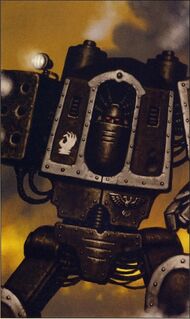
An Iron Hands Dreadnought during the Drop Site Massacre of Istvaan V
- Drop Site Massacre of Istvaan V (Unknown Date.M31) - The early battle of the Horus Heresy that would become known as the Drop Site Massacre of Istvaan V was a disaster of unimaginable proportions for the X Legion. Fuelled by anger and a sense of betrayal after Fulgrim revealed the Traitors' plans to overthrow the Emperor under the leadership of the Warmaster Horus, Ferrus Manus urged Corax of the Raven Guard Legion and Vulkan of the Salamanders Legion to launch the attack on the Traitors at Istvaan V before the other four Loyalist Legions assigned to the assault had arrived. So it was that the Raven Guard and Salamanders joined with the Iron Hands and assaulted the bloodied and diminished World Eaters, Emperor’s Children, Sons of Horus and Death Guard on the desolate plains of Istvaan V. The Traitors had been greatly reduced in strength due to the fighting on Istvaan III with the Loyalist members of their own Legions but it still proved a tough and gruelling battle, with less than three Legions pitted against four. The Loyalists' attack plan ultimately relied on the reinforcements provided by the second wave of Loyalist Legions assigned to bring Horus to heel, which included the Night Lords, Word Bearers, Iron Warriors and the Alpha Legion. The Iron Hands' elite Morlocks Terminators, led by Ferrus Manus, formed the centre of the Loyalists' assault as the Primarch of the X Legion sought out his fallen brother Fulgrim. Finally the forces of the Emperor’s Children and the Morlocks came together in a riot of bloodshed and death. The Morlocks' superior armour and experience gave them an advantage over the rank and file Astartes of the Emperor’s Children, but they were greatly outnumbered. While Ferrus Manus and Fulgrim clashed in a final confrontation, the Morlocks were slowly cut down, one by one. In the end, Fulgrim lost his soul to a powerful daemon of Slaanesh that inhabited the daemonsword he had claimed from the xenos world of Laeran after he beheaded his former brother Ferrus Manus. The daemon took possession of Fulgrim's body, defiling the head of his fallen brother and delivering it to Horus after the battle in a box—though the Warmaster was disgusted by the gift and vowed to drive the daemon from his brother's body once the Emperor had been overthrown and he no longer needed the aid of the Ruinous Powers.
- Assault on Iydris (006-007.M31) - In the wake of the terrible slaughter of Loyalists at the Drop Site Massacre on Istvaan V, a small fleet of Astartes from the ravaged Iron Hands and Raven Guard Legions managed to flee off-world. Among these vessels was the Sisypheum, a Strike Cruiser commanded by the mortally wounded Iron Hands Captain Ulrach Branthan. Determined to continue to strike against the Traitor Legions wherever and whenever they could, the crew of the Sisypheum eventually manged to intercept the encoded communications of the Traitors and learned that the Traitor Primarchs Fulgrim and Perturabo were leading their Emperor's Children and Iron Warriors Traitor Legions, respectively, into the Warp Rift later named the Eye of Terror by Perturabo in search of an unknown Eldar weapon known as the Angel Exterminatus which could decisively tip the balance of the Horus Heresy in favour of the Traitors. The Iron Hands eventually assembled a small fleet of similar Loyalist survivors of the Drop Site Massacre and made their way into the Eye to stop the Traitors from acquiring this weapon. Once within the Eye, Fulgrim led the combined Traitor Legion forces to the ancient Eldar Crone World of Iydris, into the citadel known as Amon ny-shak Kaelis where the Angel Exterminatus was supposedly located. The Traitors were forced to repel countless attacks by the ancient Eldar defense systems and by attacks from Eldar constructs animated by the ountless dead Eldar souls of the Crone World. In truth, the entire quest for the Angel Exterminatus had been a ruse perpetrated upon Perturabo and the Iron Warriors by Fulgrim and the Emperor's Children. Fulgrim, now a Champion of the Chaos God of Pleasure, Slaanesh, sought apoetheosis to become a Daemon Prince of the Prince of Chaos. But he needed the power provided by the life force of a Primarch and the sacred energies of a place like an Eldar Crone World that was sacred to Slaanesh to complete his ascension to daemonhood. Fulgrim had given to Perturabo a cloak, to which was affixed a skull-shaped pin carrying a relic known as a maugetar stone. As long as Perturabo was within the confines of the Eldar citadel the stone slowly absorbed his life force and fed these energies to Fulgrim. Once Perturabo discovered his brother's perfidy, the Iron Warriors launched an assault upon the Emperor's Children, and a three-way battle soon developed as the Iron Hands from the Sisypheum and its small flotilla of Loyalists entered the fray against both Traitor forces, unaware of what was truly happening. In the course of the combat that followed, Perturabo slew Fulgrim's mortal body with the great warhammer Forgebreaker, which ironically had originally been forged for Fulgrim by Ferrus Manus. But this action was only the final component in Fulgrim's ritual of apoetheosis, and his body remade itself into the twisted, serpentine form of a Slaaneshi Daemon Prince. Fulgrim became the first of the Traitor Primarchs to ascend to daemonhood, but he would not be the last. His goal achieved, Fulgrim had teleported his Emperor's Children away from Iydris and the Crone World began to collapse as the potent life forces of the dead that had long sustained it were drained away by Fulgrim's ascension. The Iron Hands and Perturabo's Iron Warriors successfully fled the crumbling planet, though Perturabo escaped by taking his fleet deeper into the black hole that lay at the centre of the Eye of Terror. For the first time, one of the Traitor Legions had turned on another, a situation that was to become all too common as the Dark Gods of Chaos tightened their grip on Horus' followers.
- Battle of Tallarn (Unknown Date.M31) - To this day the largest tank battle ever conducted in Imperial history remains the Battle of Tallarn. During the Horus Heresy, the Iron Warriors Traitor Legion launched a massive assault on the world of Tallarn. To soften up the Loyalist resistance, the Iron Warriors virus-bombed the former Agri-world, and the Life-Eater virus turned the once lush and productive breadbasket world into a wasteland of endless desert in short order. The few surviving Imperial citizens emerged from underground shelters to oppose the Iron Warriors' attack and soon reinforcements landed on the Desert World for both sides. Elements from the Iron Hands and Imperial Fists Legions arrived to oppose the invasion but the now-hazardous environment forced both sides to fight within the environment-sealed confines of their battle tanks. Both the Loyalists and Traitors committed armoured fighting vehicles of all sizes and configurations to the conflict in numbers never before seen in a single battle. The resulting fighting was fierce and merciless with both sides taking horrendous casualties. Eventually the Iron Warriors were forced from the planet by the Loyalist counter-attack. In the aftermath of the fighting, over a million wrecked tanks littered the surface of Tallarn, rusting in the endless dunes and wasting sands of the devastated planet. The ruination of Tallarn is a slight against the Imperium the Iron Hands and Imperial Fists have never forgotten. It was not until many centuries later that the people of Tallarn learned to their horror why the Iron Warriors had invaded their world—they had come seeking the Cursus of Alganar, an ancient Chaotic artefact that acted as a gateway into the Realm of Chaos within the Warp.
- The Moirae Schism (ca. M35) - The Adeptus Mechanicus is torn apart by conflict and internal division during the time of internal religious strife known as the Moirae Schism. The Adeptus Astartes are not immune to such conflicts; the Iron Hands, due to their close connection to the Mechanicus, are most severely affected. The result of the religious discord is the unexpected birth of the Sons of Medusa Chapter.
- Damocles Gulf Crusade (742.M41) - In 742.M41 the Imperium launched what became known as the Damocles Gulf Crusade against the newly arisen xenos threat of the Tau race. The Crusade was launched into the Lithesh Sector that stretched between the Damocles Gulf and the Perdus Rift Anomaly in the Eastern Fringes of the galaxy. The Crusade was tasked with repulsing a number of Tau incursions into the sub-sectors of the area and with pushing the xenos back to their homeworld where they would be purged from existence. To accomplish this, the vanguard of the Crusade was formed around twelve capital ships of the Imperial Navy and five Crusade Companies of the Adeptus Astartes including elements from the Ultramarines, Scythes of the Emperor, White Scars and Iron Hands Chapters. Rounding out the Crusade’s fighting strength were 19 regiments of the Imperial Guard, 7 of which were raised from the Ecclesiarchy world of Brimlock. The Crusade was to receive significant reinforcements after establishing a foothold in Tau space. The conflict essentially ended in a stalemate, as the Imperium was forced to conclude its military offensive on the Tau Sept World of Dal'yth early to deal with the encroaching Tyranid threat of Hive Fleet Behemoth while the Tau sought to open diplomatic negotiations with the Imperium. The Tau forces sensibly realised that getting in the way of an Imperial withdrawal from their space would serve no purpose and they allowed the Crusade's forces to withdraw unopposed. In this way, the first major engagement between the Tau xenos and the Imperium came to its conclusion. Though the objective of the Damocles Gulf Crusade had failed, the Astartes and other Imperial forces learned valuable lessons from this Crusade that would later see use in other conflicts against the Tau on Nimbosa and Medusa V.
- An Alliance Re-forged (751.M41) - The Forge World of Estaban III is invaded by the myriad forces of Chaos. The Iron Hands respond and stand beside the war-engines of Legio Tempestor in the Forge World's defence.
- The Siege of Hammerspire (779.M41) - Following a decade-long siege, the reportedly indestructible fortress of Hammerspire is finally breached by Iron Hands Assault Centurions and the defenders slain to a man -- a full two standard years after the Renegades declared their total and unconditional surrender.
- The Defence of Paratheon City (802.M41) - The World Eaters' Champion Varlag the Butcher challenges the Iron Father Kardan Stronos to personal combat during the defence of Paratheon City. Whilst Stronos calculates the most efficient way to slay his opponent is to shoot him through the head, he instead answers Varlag's blood-flecked bellows with an enraged battle-cry of his own before hacking his Traitor's head off with a single blow from the Axe of Medusa.
- An Honour Refused (810.M41) - The Iron Hands are one of nine Space Marine Chapters that liberate the Kelldar System from the clutches of WAAAGH! Gorzod. After their crushing victory, a celebratory feast is held by the Governor of Kelldar Prime to honour the sacrifice and heroism of the Adeptus Astartes. All of the Chapters attend the feast except the Iron Hands, who publicly refuse to sit at the same table as warriors from the Raven Guard.
- Purge of the Contqual Sub-Sector (812.M41) - The Iron Hands have long been renowned and feared as a wrathful and merciless Chapter. Many would-be Heretics and Traitors have thrown down their arms and renewed their faith in the Emperor rather than face the fury of the Iron Hands. The Purge of the Contqual Sub-sector was a sterling example of the consequences of inciting the retribution of the sons of Ferrus Manus as they concluded the campaign with a swiftness and fury that has long been a hallmark of the Iron Hands. As far as Imperial scholars can determine, the taint of the Contqual Sub-sector began late in the year 812.M41 when the Contqual High Governor fell easy prey to the corruption of the Chaos God of Pleasure, Slaanesh. From their High Governor's court the taint spread quickly and within a single month the entire Sub-sector seethed with the corruption of Chaos. The cleansing of Contqual was tasked to the Iron Hands who have always burned with hatred for Chaos in all its myriad forms since the disaster on Istvaan V. The Iron Hands stormed into the Contqual Sub-sector with a speed akin to chained lightning, seizing several planets before resistance could even be organised by the region's Forces of Chaos. In short order, the Iron Hands of Clan Raukaan, under the command of Lord Clan Commander Arven Rauth, moved against the focal point of the Chaotic taint in Contqual, the Hive World of Shardenus, where the world's large body of Chaos Cultists, making use of forbidden sorcerous rituals, had torn a hole straight through the space-time continuum and into the Warp. From this horrific Warp portal streamed all manner of daemonic monsters to pollute the realm of the Emperor. Though massively outnumbered and sustaining significant losses, the Iron Hands cut through the Heretics and their daemons like an ebon-armoured storm. The world was brought to heel in short order with the rest of the Sub-sector falling to the fury of the Iron Hands with equal speed, the citizens of many worlds turning on their tainted masters and pleading with the Iron Hands for mercy. But the sons of Ferus Manus are not known for their forgiveness and the Chapter fell on the worlds of the Sub-sector with a cleansing wrath, executing one in every three civilians in a great and bloody purge, which the Chapter intended to serve as a righteous punishment for allowing the taint of Chaos to sweep over the worlds of the Contqual. Just a few weeks after their arrival, the Iron Hands departed, leaving a Sub-sector that would become one of the most devoted of all those in the Imperium to the God-Emperor in their wake. For none of the survivors of the Iron Hands' purge doubted the cold retribution they would face should their faith waver ever again.
- The War of Vengeance (883.M41) - In the wake of the Saint Cyllia Massacres, the Iron Hands commit several hundred battle tanks to the destruction of the Renegade Adamant Fury Titan Legion. Their Land Raiders prove vital during the Battle of Planus Steppes, protecting the flanks of the Cadian 423rd Armoured Regiment and accounting for the destruction of no less than four Renegade Titans.
- The Crusade of Steel (900.M41) - Iron Father Kardan Stronos leads the full might of the Iron Hands and Brazen Claws Chapters against the Necron dynasty of the Crimson King. Stronos refuses to fall back in the face of a massive counter-attack, and alongside the Iron Hands' Garrsak Clan Company he somehow fights his way forward to strike the Crimson King a mortal blow that shatters the Necrons' command structure.
- The Battle of Tarrvorn (928.M41) - Techmarine Aviren fights for six solar days through the jungles of Tarrvorn, slaying a dozen Ork patrols to recover the battle-damaged Land Raider Ferrum Maximal.
- The Iron Ascension (935.M41) - Iron Captain Bannus is seriously wounded by the Dark Eldar when Clan Company Kaargul are ambushed on the industrial world of Kaladrone. Iron Father Blantar deems the Captain's loss an unacceptable blow to the strength of the Iron Hands and mounts a brutal counter-attack to rescue him. Despite sustaining horrific damage, Blantar and the survivors of Clan Company Kaargul endure the Dark Eldar's weapons and return to Medusa with Bannus' shattered body, interring him within the armoured sarcophagus of a Dreadnought.
- A Calculated Insult (963.M41) - The Iron Hands and the Space Wolves come to blows during the Battle for Fellcore Moon after Iron Captain Telavech's logical critique of Ragnar Blackmane's impetuous performance is taken as a scathing insult.
- The Adacore Extermination (984.M41) - Venerable Brother Bannus leads a strike force of twenty Iron Hands Dreadnoughts to scour the Mining World of Adacore after excavations awaken the Necron war-cell of Overlord Kepakh of the Nihilakh Dynasty.
- Cleansing of the Ulik Sector (997.M41) - In 997.M41 a series of Exterminatus missions were carried out across the Ulik Sector by Space Marines of the Death Strike, the Flame Falcons and the Iron Hands Chapters. The Iron Hands performed a series of destructive missions on those worlds in the Ulik Sector not yet consumed by Hive Fleet Leviathan, in order to prevent the Tyranid Hive Mind from gaining momentum and further fuelling itself on precious bio-resources.
- 13th Black Crusade (999.M41) - When the forces of Abaddon the Despoiler spilled forth from the Cadian Gate in 999.M41 to launch his 13th Black Crusade, the Iron Hands knew that Medusa faced imminent invasion due to their close proximity to the Eye of Terror, and so the Chapter scrambled to prepare their defences. Given that Medusa is the only world from which the lron Hands recruit new brethren, they were forced to defend it above all other considerations. While it is known that two of the Clan Companies were deployed elsewhere in the defence of the region, the greater strength of the Chapter was used in the defence of their homeworld. The largest battle in the defence of Medusa came when all 10 of the gargantuan tracked fortresses of the Clan Companies faced the invading Traitor Guardsmen of the Haradni 13th Heavy Armoured Regiment. The plains of Medusa played host to one of the largest armored clashes the galaxy has seen since the infamous Battle of Tallarn during the Horus Heresy, when over 10,000 Traitor tanks stormed towards the waiting Iron Hands. The ensuing battle raged for five days and five nights, as the Traitors closed within firing range of the Iron Hands mobile fortresses. When the Iron Hands opened fire, it is said that over a hundred tanks were destroyed in the first volley, for each Clan Company commanded firepower equal to a Centurio Ordinatus of the Adeptus Mechanicus. On the fifth day, at the height of the battle, the Traitors broke through the Iron Hands' lines, and an armoured company of Traitors outflanked one of the Chapter's mobile fortresses and fired shell after shell into it at nearly point blank range. The Iron Hands responded by launching a furious counter-attack spearheaded by Assault Squads armed with Melta Bombs leaping from the crenelated towers of the mobile fortress to land atop the enemy tanks. Though many Astartes lost their lives in the attack, shot down by pintle-mounted weapons or ground beneath the enemy vehicles' armoured tracks, their counter-attack was successful in disabling or destroying the majority of the Traitor armour and sending the rest into a disorderly retreat. It was then that the Iron Hands launched an armoured assault of their own, as whole formations of Predator Annihilator tanks disgorged from the mobile fortresses to run down and destroy the Heretic tanks with ravening beams of Lascannon fire. The Iron Hands managed to secure Medusa by the midpoint of the campaign and were able to deploy several Clan Companies to the defence of the Cadian System and an Iron Hands naval task force was dispatched to reinforce the naval world of Vigilatum.
Chapter Organisation
Pre-Heresy
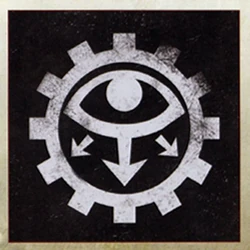
The Seal of the Eye of Vigilance, an award bestowed by the Warmaster Horus upon the Iron Hands who served beside him in battle and were held in high regard; it was with bitter spite that some Iron Hands still bore this decoration upon their armour at Istvaan V, vowing only to deface it with the blood and bone of the enemy
As is perhaps unsurprising from so calculating and methodical a master as Ferrus Manus, the Iron Hands Legion was a highly structured military force, with numerous tactical and strategic divisions of power and organisations within its ranks. However, on close inspection, the precise nature of this structure is a very particular one, instituting a system of "organised compartmentalisation" within the Legion. This stands in contrast to other highly-structured Space Marine Legions such as the single overarching hierarchy of many fine gradations as was found in the Emperor's Children or the Imperial Fists. Nor did the Iron Hands subscribe to the utterly rationalised clarity and dogmatic adherence to order and stricture espoused by the Ultramarines. The Iron Hands Legion was instead deliberately composed from a series of interlocking components, each with its own specialistation, duties and chain of command, beholden only to itself and its immediate superiors. Each of these components; be they Legionary squad, armoured vehicle squadron, support elements, etc., came together first as companies in the broadly standard model. But beyond this, each company was a part of a larger grouping with its own independent command, support and logistical network, armoury and voidships created for a particular campaign or battle. These formations were referred to as Orders and were superficially equivalent to a specialised battalion in general Legiones Astartes terms, but far more concrete in makeup and isolated in operation.
Inside an Order, the component companies were configured in such a way that each unit's function combined together to form a gestalt whole whose tactical and strategic capabilities, like the components of a machine working together in unison, were capable of actions outweighed by the sum of their parts. In battle each Order was given a specific task which it was expected to fulfil without needing assistance, and succeed it would at any cost, for pride, honour and sheer belligerence would allow no other outcome. Orders were often formed form a larger single Clan grouping, and sometimes units from different Clans fought together within them, often as rivals for glory and achievement.
Clans were notionally the Iron Hands' equivalent of the Chapter formation of other Legions but again, on close inspection, were in practice possessed of a distinct character, being patterned to a larger extent on the Medusan feudal system and were linked to the planet's nomadic barbarian populations as recruiting bases. These Iron Hands Clans were in fact "pocket Legions", fully self-sufficient and self-supplied, and each had a single officer with the title of "Chieftain" or "Iron Lord" to rule them by Primarch-given right. Each Clan had a very real and distinct identity and each vied against each other for glory, attainment and for resources, as well as for the favour of their Primarch.
The level of integration and strength the Iron Hands Legion's system manifested was extraordinary if somewhat inflexible. Whether deployed as a single company or a full Legion in scale, it was a crushing leviathan when in action; extraordinarily difficult to stop, but also at times brutally intractable and slow to change course through its single-minded pursuit of its starting objectives. This was Ferrus Manus' deliberate intention, and as part of that design he invested authority and initiative with the few, not the many. Accordingly he created several distinct tiers of organisational structure where field commanders wielded absolute power and authority, and were to be obeyed without question by those beneath them, ensuring any responsibility for failure would be identified and dealt with merciless efficiency. Within the Iron Hands Legion, command carried with it the power of both life and death; each Shield-Centurion who commanded a company was empowered to enact at will both reward and punishment on any Astartes under their command. This included the right of immediate punishement -- including execution -- over any Legionary beneath them, without recourse, hearing or trial. Likewise, at the higher echelons of the Legion, an Iron-Captain had the same rights over their War Leaders and other subordinate officers within their Order, and the ranks beneath them. An Iron-Lord held the same rights over the Iron-Captains in their Clan, and so on. Overarching this structure, Ferrus Manus was the single judge, ruler and master over all in his Legion without contest or gainsay.
The Iron Hands were a Legion whose numbers remained relatively constant throughout the latter phases of the Great Crusade, balancing their intake of new recruits largely with losses in the field. This was achieved despite the fact that many failed the Legion's rigorous and unforgivingly harsh training and assessment methods on Medusa. They were, however, known to maintain a particularly extensive and sophisticated arsenal of war engines -- particularly tanks, armoured vehicles and Dreadnought walkers -- the equal of any Legion save perhaps for Perturabo's IV Legion. Thanks to long-standing ties to elements of the Mechanicum and the technological aptitude displayed by many in their number, the Iron Hands possessed access to numerous cybernetic implant systems seldom seen outside the Machine Cult, and they were also able to widely reproduce and maintain large stockpiles of Grav-weapons, Conversion Beamer and Laser Destroyer systems, and other arcane and esoteric machineries of death. This range of materiel extended both to extensive numbers of Servitors (often created from failed Legion Aspirants and, it has long been rumoured, prisoners taken in battle), and advanced super-heavy tanks such as the Fellblade. In addition, battle-automata and troops from the Mechanicum were preferred by the Iron Hands Legion for strategic support when available as the Legion was largely dismissive of most Imperial Army units as unfit for frontline work. It is also worthy of note that the Iron Hands Legion, and its master Ferrus Manus, was at the forefront of the introduction of a number of weapons systems and armour patterns over the course of the Great Crusade. The fruits of some, such as their contribution of the prototype Indomitus Pattern to the Tactical Dreadnought Armour project and the powerful Stormbreaker Pattern Thunder Hammer, would later be widely disseminated to the rest of the Space Marine Legions. Yet, the Iron Hands were not wholly selfless in their technological developments; the secrets of certain other weapons and metallurgic and cybernetic crafts they kept to themselves and their most trusted confidantes within the Mechanicum.
The strength of the Iron Hands' pseudo-feudal system of Legion organisation created a highly discipline and motivated force which both despised and punished failure and weakness, and rewarded and glorified strength, accomplishment and success. This created an environment in which the most competent and strongest-willed rose quickly within their ranks, and those who did not make the measure were quickly weeded out. It also provided a set of boundaries and strictures which channelled the raw aggression and adversarial tendencies of the Iron Hands themselves, many of whom shared their Primarch's volatile temperament, kept in check through a mixture of coldly-imposed Legion discipline and with Medusan cultural values of bloody-minded pragmatism which were taken as the Legion's creed.
It also had the effect of creating not inconsiderable friction and indeed direct competition between the Legion's Clans, both to attain glory and praise in their Primarch's eyes and to outdo each other in battle. This competitiveness had a very practical consideration also as the most successful Clans were favoured by their Primarch with a greater proportion of recruits and additional resources -- a matter not of favoritism but logic in their master's eyes -- a distribution weighed to prefer the Clan who had proved itself most able to utilise what it was given in the Legion's service. For the rest of the message was equally clear: it was a matter of the survival of the fittest; adapt, grow strong, overcome -- or fail and wither to destruction. It has been argued by some that the embodiment of this philosophy, particularly in the person of its Primarch Ferrus Manus, contributed greatly to the crisis, mental shock and sheer psychological trauma endured by the Iron Hands Legion after the dire events of the Drop Site Massacre on Istvaan V.
Specialist Ranks and Formations
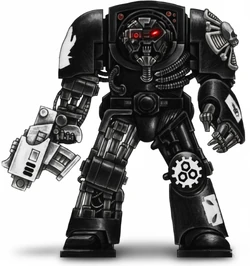
Iron Hands Veteran Legionary in Gorgon Pattern Terminator Armour
- Gorgon Terminator Squad - One of a number of Tactical Dreadnought Armour sub-classes found within the ranks of the Iron Hands Legion, Gorgon Pattern Terminator Armour was one of a number of ongoing attempts by Ferrus Manus and his cadre of Iron Fathers to refine and augment the various patterns of Terminator Armour employed by the Legiones Astartes forces. One of the most extreme technological examples of the Iron Hands' innovation to improve on the designs in this regard was the hazardous but powerful "Gorgon" prototype, a variant of Indomitus Pattern Terminator Armour which required bonding to its wearer, as well as extensive cybernetic replacement. However, volunteers for this painful modification were plentiful in the Legion's ranks, many deeming it an honour to serve as part of this great endeavour. These elite Veterans were then placed in special Gorgon Terminator Squads, made up of four Gorgon Terminators and led by one Gorgon Hammerbearer (Squad Leader). Ferrus Manus would not live long enough to refine the Gorgon Pattern to its full potential due to his untimely death at the hands of the treacherous Fulgrim during the Drop Site Massacre on Istvaan V.
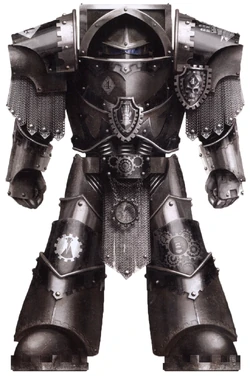
An elite Iron Hands Morlock in ancient Cataphractii Pattern Terminator Armour during the Horus Heresy
- Morlocks - The Morlocks were the Veteran Space Marine Battle-Brothers of the Iron Hands Legion who served as Primarch Ferrus Manus' personal Honour Guard. These elite Veterans of the Iron Hands' 1st Company were so-named for the fearsome visage they presented, so like the vengeful predators of the same name that howled across the frozen tundras of their Legion homeworld of Medusa. The Morlocks were the deadliest and most experienced warriors of the X Legion, and whatever force was arrayed against these black-coloured Terminators could not hope to survive their wrath. The Morlocks were the bloody tip of the spear that drove hard into the vitals of the X Legion's foes. Many of the Morlocks were comprised of the 1st Order (Order Primii) of the Avernii Clan. Many of these warriors had been slain at the hand of the Primarch Fulgrim and his Phoenix Guard aboard Ferrus Manus' flagship before the full extent of Horus' rebellion had revealed itself. Many more fought in the Drop Site Masscre on Istvaan V at the side of Ferrus Manus, determined to avenge the deaths of their brothers. Their fate instead was to fall beside their master, loyal and resolute to the end. It is unknown whether the Morlocks were reconstituted by the Second Founding Iron Hands Chapter after the events of the Horus Heresy.
- Medusan Immortals Squad - Comprised of those Iron Hands Legionaries who had failed their father's rigid standards and bleak code in battle, whether tasting defeat by the fickle whims of fate or whether laid low by a wound too terrible to bear, the Medusan Immortals Squads were the forlorn hope, a final chance at glory and redemption where the battle was at its fiercest and the risk of survival, even for an Astartes, was at its dimmest. Armed and armoured principally as Legion Breacher assault units and featuring a high level of cybernetic rebuild among them, the Immortals bore no symbols of their Clan or Legion, save its numeration and the black-on-white death's head symbol which proclaimed their mortal intent.
Legion Armoured Echelons
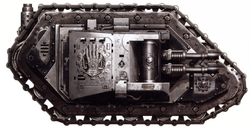
Iron Hands armoured Proteus Land Raider Wyvern, Order Primii, Clan Avernii
The Iron Hands Legion utilised its many war machines as support for individual companies and Orders, but also fielded large units of heavy battle tanks as distinct units. Such formations ranged in size from squadrons of less than a dozen vehicles to company and even Order-sized units comprised of scores of vehicles. In the case of super-heavy tanks such as the Fellblade, between three and five vehicles would be considered more than a match for any foe less powerful than a Battle Titan. Units of Predators or Land Raiders might consist of forty or more vehicles and be sub-divided into numerous commands. The armoured formations committed to the Istvaan V operation were deployed as part of the second phase of the Iron Hands Legion's attack. Their orders varied enormously, some committed to frontal assault and breakthrough actions, others to wide flanking manoeuvres. Some armoured formations were tasked with engaging those of the Traitor Legions' as the Loyalist Primarchs were well aware that the enemy had had plenty of time to prepare for battle and access to a great many war machines of their own.
Despite their power, almost all of the Iron Hands Legion's armoured formations are thought to have been destroyed under the guns of the Traitor's overwhelming numbers at Istvaan V. The heaviest formations, such as the Fellblade companies serving under Clan Ungavarr and the Land Raider echelons of Clan Avernii, are known to have been engaged by Traitor Titans and to have suffered incredible losses despite valiant attempts to concentrate their efforts against these mighty foes. Of the few eye witness accounts committed to record in the aftermath of the Drop Site Massacre, few fail to make mention of the bold attacks of the Iron Hands armoured echelons against staggering odds.
Legion Vehicles
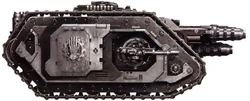
Iron Hands Legion Cerberus Heavy Tank Destroyer
The core of the Iron Hands armoured units, though limited in number by the capacity of the Battleship Ferrum which ferried them to Istvaan V, held some of the finest war machines and crews in the X Legion. Tragically, when the Legions of the second wave at Istvaan V revealed themselves as Traitors and opened fire upon the sons of Ferrus Manus, Vulkan and Corax, many of these war machines were oriented towards the fortifications of the Sons of Horus, the Emperor's Children, the Death Guard and the World Eaters. Their less armoured rears were therefore facing towards the guns of the Word Bearers, Night Lords and, in particular, the Iron Warriors. As a result of the treacherous bombardment from the rear, they suffered staggeringly high losses in the first minutes after the treachery of Lorgar, Konrad Curze and Perturabo was revealed. Nonetheless, the crews of every type of armoured vehicle in the service of the Iron Hands fought on boldly, many sacrificing themselves at the last so that the surviving infantry could break out of the trap and disperse into the surrounding wilderness to fight on.
Legion Fleet Auxillia

Iron Hands Legion Thunderhawk Transporter
In addition to heavy ground units, the Iron Hands committed every available air and sub-orbital asset at their disposal to the Istvaan V drop. In the case of the Ferrum 's complement, this primarily consisted of Thunderhawks and Caestus Assault Rams. Such vessels were utilised in a range of different roles, from that of gunship to ferrying troops around the battlefield directly in the face of enemy guns. The ultimate fate of many of these aircraft is a salutary example of the spirit in which the Legiones Astartes were forged. Even as the full and dire extent of the Traitor Legions' treachery became clear, Loyalist Thunderhawks and other similar sized classes of aircraft worked tirelessly and entirely without consideration for their own safety to aid the beleaguered ground forces. Those aircraft that were able to do so launched ceaseless strafing runs against the enemy, while those whose ammunition was expended attempted to evacuate their brothers to orbit. Others fought desperately to fend off the attacks of enemy aircraft, while a few sacrificed themselves by crashing into the densest concentration of enemy forces they could identify. Though noble in the extreme, such glorious acts of self sacrifice failed to stave off the death of the Primarch Ferrus Manus and the near-total destruction of the Iron Hands ground forces so perfidiously betrayed in the Drop Site Massacre at Istvaan V.
Iron Hands Legion Reserve
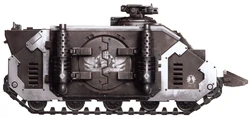
An Iron Hands Legion's Deimos Rhino armoured personnel carrier, ceded to Order Quarii of the Clan Vurgaan
The Iron Hands Legion maintained a notably large pool of reserve and second line vehicles of all types and classes. Such vehicles included many more commonly seen in the service of the Imperial Army, or since made obsolete by the discovery and exploitation of new Standard Template Construct (STC) imprints. Much of the Legion reserve consisted of war engines either awaiting attachment to a specific Clan, or otherwise intended for use in operations that required more vehicles than the Clan had immediately available. The crews assigned to operate the vehicles of the Legion reserve for the Istvaan V drop operation were drawn from many and varies sources and combined in the confines of the Ferrum 's hold. Regardless of the unconventional circumstances of their assignment, it is generally held that all of these crews comported themselves with honour and skill, regardless of their station within the Legion. In one case, a Legion Baneblade commanded by an Iron Hands Sergeant is known to have been struck by a Titan-class weapon, its turret breached and its command crew slain. In the heat of battle, the Legion Serf manning the forward secondary weapon station assumed control and kept the vehicle fighting for an estimated further eleven standard minutes before it was overrun by World Eaters infantry and all of the surviving crew were slain.
War Disposition
At the outset of the Horus Heresy, the Iron Hands Legion is commonly estimated to have had an operational strength just in excess of 113,000 Astartes, with a huge operating reserve of wargear and supplies, alongside a diverse fleet of around a hundred capital vessels of various classes. This placed the Iron Hands within the mid-tier of Space Marine Legion strengths recorded at this date by their sheer numbers alone, but in general terms, their resources in wargear, war materiel and supply made them a considerably greater military power in practice than their sheer number would suggest.
At the time the events of the Istvaan III Atrocity were taking place, the major constituent of the Legion (believed to be around two thirds its full strength both in terms of manpower and ships, comprising the majority of its most powerful Clans), were under the direct command of their Primarch, forming the 52nd Expeditionary Fleet. Owing to the perfidious treachery of Fulgrim, and the uncontrollable wrath of Ferrus Manus in response, the Iron Hands Primarch broke ranks from this force and reached Istvaan V with only an elite cadre chosen from his then-favoured Avernii Clan alongside him, almost all of whom were annihilated with their slain Primarch during the Drop Site Massacre. A great many more vessels of the 52nd Expeditionary Fleet following on behind their Primarch were also destroyed, along with tens of thousands of Iron Hands on board as they later transited into the Istvaan System, rushing unknowingly into a death trap from which only a few of the X Legion's warships were to escape. Taken together, these losses were great, although this left more survivors from the Iron Hands Legion in number than could be ascribed to the Drop Site Massacre's other victim Legions overall. This was largely the case as larger groups of Iron Hands were presently engaged elsewhere and unable to heed, or ignorant of, their Primarch's rushed call to assault the Traitors at the Istvaan System. The Legion was nevertheless savagely reduced; the survivors scattered physically and shattered spiritually by its losses.
Initially sent reeling and psychologically devastated, the Iron Hands Legion's survivors fractured, and the full story of what happened to its scions remains clouded to this day. It is known, however, that some Clans re-organised a council of Iron Fathers on Medusa to take charge of the ravaged Legion, and sped the recruitment and creation of new Space Marines from the extensive stores of gene-seed kept there with the goal of rebuilding the Legion. Alongside this, it is widely believed that in the aftermath some Iron Hands units and, in some cases, entire Clans shunned the Medusan Iron Council's assumed authority and went their own way, consumed by their own hatred and need for revenge. These fractured forces fought their own war and it is widely believed some delved into the use of dark and forbidden forces from humanity's ancient past to do so, although this has been strenuously denied since by the Iron Hands Clan Council.
What cannot be contested, however, is that other lone Iron Hands and small scattered groups cast off their Legion's livery entirely and either fought on alone or went Renegade -- Iron Hands no more. Regardless of the hidden truths of these terrible times, the Iron Hands Legion in the years that followed the Drop Site Massacre, and largely under the auspices of the Medusan faction, managed to re-enter the fight against the Traitors during the Horus Heresy and Great Scouring with devastating results on several outer worlds, but it was as a shadow of its former strength; no longer a Space Marine Legion whole, united or even entirely sane.
Post-Heresy
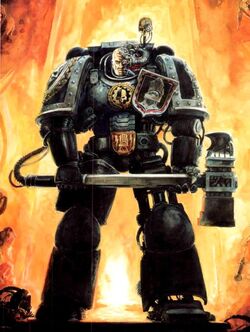
An Iron Hands Sternguard Veteran
During the Second Founding that took place early in the 31st Millennium after the Horus Heresy, the remaining Astartes of the ravaged Iron Hands Legion split into 5 separate Chapters. Four new Chapters named the Red Talons, Brazen Claws, Emperor's Shadows and Red Wolves departed Medusa forever and went to establish their own homeworlds and fortress-monasteries across the galaxy. In time, all four Successor Chapters became increasingly reclusive. One of the 5 Chapters retained the original name and heraldry of the X Space Marine Legion and remained on Medusa. Since its inception, the Iron Hands Chapter has increasingly diverged from the standard Codex Astartes-compliant organisation of most Adeptus Astartes Chapters, changing to reflect the culture of the native nomadic clans of Medusa who provide all of the Chapter's Astartes. Contact between the Successor Chapters of the X Legion slowly deteriorated as they all became increasingly insular in nature, while simultaneously contact with other Chapters drawn from the other original First Founding Space Marine Legions virtually ceased entirely as the Iron Hands became ever more insular following the terrible defeat at Istvaan V.
The Iron Council
The organisational structure of the Iron Hands also changed upon their return to Medusa after the Drop Site Massacre. Without Ferrus Manus, it was decided that no single warrior should ever permanently lead the Iron Hands. Instead, the Captains and the most revered warriors of the X Legion formed the Iron Council. Those who sat on the council became known as the Iron Fathers, and that body has guided the Iron Hands ever since. The Chapter drew much of its organisation from the political structure of the mortal clans of Medusa. Each of the 10 Clan Companies of the Chapter is a single entity, possessing its own command hierarchy, Veterans, beliefs and clan traditions. One warrior of each Clan Company is nominated to represent their peers at the Iron Council. The Iron Hands have never had a Chapter Master and are instead led by an elected member from the Iron Council from the most senior and respected members of each Clan Company. The Iron Hands view the Council as a strength, for no individual can lead the Chapter astray like they have seen happen all too often to other members of the Adeptus Astartes. It is common for members of the council to be ancient and revered Dreadnoughts who have long been free of their frail mortal flesh. This precaution was implemented so that no one man could ever lead the entire Chapter astray, as happened during the Heresy to the X Legion's closest allies, the Emperor's Children Legion.
When the fires of the Horus Heresy had ebbed and Roboute Guilliman revealed his great work, the Codex Astartes, the Iron Council saw that adopting its wisdom was the only logical course. Whilst some fought against the breaking of the Legions into Chapters, the Iron Hands refused to show weakness, and despite their reduced numbers, still managed to found two Successor Chapters. In the centuries following the Second Founding, the Iron Hands cut a deadly swathe through any and all who opposed them, methodically destroying enemy armies and alien empires. As the centuries turned into millennia, however, the Chapter grew ever more reclusive and hostile to outside interference. The one exception to this was the Chapter's continuing close alliance with the Adeptus Mechanicus.
Clan Company Autonomy
There are ten Clans which act in much the same way as the Battle Companies of traditional Codex-compliant Chapters, being versatile and capable in any given situation. However, where traditional Codex-compliant Chapters have a distinct separation and differing specialisations between the various companies that form it, such as the 10th Company always being formed of Scout Marines, the Iron Hands Chapter is made up solely of its ten Clan Companies. These generally act as completely separate entities in their own right, and it is not unknown for minor skirmishes to break out between Clan Companies in certain circumstances. This is encouraged, so as to keep the Space Marines strong and vigilant in accord with the original beliefs of Ferrus Manus.
Each Clan Company has its own hierarchy, and is responsible for the recruitment of new Space Marines in order to keep the Clan's numbers at the required level. These new recruits are taken from the mortal clans of Medusa who embrace their new Clan Company and the Chapter as a whole. The Clan Companies are nomadic, much like the clans they are recruited from. They travel the galaxy, following their continuing crusade against weakness and corruption. Unlike in standard Chapters, the squads which make up each Clan Company are referred to as claves. Additionally, officers of the Iron Hands who hold the rank of Captain are generally referred to as "Iron Captains."
When the Iron Hands return to Medusa they travel the inhospitable Medusa landscape seeking Aspirants, remaining ever vigilant against weakness in any guise appearing on their homeworld. The Iron Hands do not maintain a fortress-monastery as such, for the shifting lands produced by Medusa's constant seismic instability would inevitably make any such structure temporary. Rather, each individual Clan maintains a mobile version of a fortress-monastery, great Land Behemoths that constantly traverse the treacherous landscape. These fully automated creations, arcane wonders crafted long ago by the Adeptus Mechanicus, are serviced by great armies of mechanical Servitors, who keep them in perfect working order during the Chapter's absence. The Chapter's fleet disposition and how its starships are administered, insofar as whether or not they are pooled to serve the entire Chapter or each Clan maintains its own vessels separately, is unknown.
Known Clan Companies
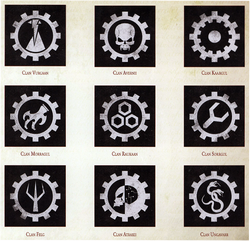
Iron Hands Legion's Clan Company Heraldry; note each of these Clan Companies would still exist after the Second Founding
Ten Clan Companies are known to comprise the present-day Iron Hands Chapter, nine of which are confirmed to date back to the time of the Great Crusade and the Horus Heresy. Each of these Clan Companies maintains the name of an Iron Hands Legion Clan that dates back to the time of the Great Crusade and the Horus Heresy. These include the:
- Atraxii Clan - The Atraxii Clan's symbol is the profile of a skull, half-human and half-machine, similar to the Adeptus Mechanicus' own Cog Mechanicum badge.
- Avernii Clan - First Captain Gabriel Santor was a member of the Avernii Clan. The Morlocks, the Primarch Ferrus Manus' Honour Guard, were exclusively drawn from the ranks of the Avernii Clan before the Horus Heresy. The symbol of Clan Company Avernii was a skull within a cog.
- Felg Clan - The Felg Clan's symbol is a three-pronged fork wthin a cog.
- Garrsak Clan - The Garrsak Clan's symbol is two meshing cogs within a cog.
- Kaargul Clan - The Kaargul Clan was led by the Venerable Dreadnought named Warleader Bannus. The Kaargul Clan's symbol is a simple cog.
- Morragul Clan - The Morragul Clan's symbol is the clawed talon of a raptor within a cog.
- Raukaan Clan - Captain Arven Rauth is the current Clan Commander of the Raukaan Clan. Clan Raukaan's symbol is three hex-shaped bolts within a cog.
- Sorrgol Clan - The Sorrgol Clan's symbol is a wrench within a cog.
- Ungavarr Clan - The symbol of the Ungavarr Clan is a two-headed serpent within a cog.
- Vurgaan Clan - The Vurgaan Clan is based out of the Weyland Land Behemoth and led by Captain Pelles. The Clan Company's badge is a lightning strike within a cog.
Clan Raukaan Order of Battle

Order of Battle of Iron Hands Clan Raukaan
While each Iron Hands Clan maintains its own autonomous make-up, an example of an Iron Hands Clan's order of battle can be seen in the forces deployed by Clan Raukaan during the campaign in Sub-sector Contqual. At this time, Clan Raukaan maintained 136 Space Marines divided between 11 claves, the Clan Commander's retinue and the Clan fleet, as well as a small Clan pool of vehicles and 23,451 mortal auxiliaries drawn from Medusa's natives and primarily deployed with the Clan fleet. Clan Raukaan's Order of Battle at that time was as follows:
- Clan Command: Lord Clan Commmander Arven Rauth, Captain of Clan Rauvaan
- 4 Terminators as Clan Commander's Retinue and Honour Guard
- 2 Apothecaries
- 1 Iron Father
- 3 Techmarines
- 1 Chief Librarian
- 3 Codiciers
- Clan fleet
- 5 starships, including Strike Cruiser Kalach
- Clave Prime (Veterans)
- 1 Sergeant in Terminator Armour
- 9 Veteran Tactical Marines
- I. Clave Taloch (Tactical)
- 1 Sergeant in Terminator Armour
- 9 Tactical Marines
- II. Clave Riis (Tactical)
- 1 Sergeant in Terminator Armour
- 9 Tactical Marines
- III. Clave Arx (Tactical)
- 1 Sergeant
- 9 Tactical Marines
- IV. Clave Nycter (Tactical)
- 1 Sergeant
- 9 Tactical Marines
- V. Clave Kalag (Tactical)
- 1 Sergeant
- 9 Tactical Marines
- VI. Clave Broesus (Assault)
- 1 Assault Sergeant
- 9 Assault Marines
- VII. Clave Neim (Assault)
- 1 Assault Sergeant
- 9 Assault Marines
- VIII. Clave Kebire (Devastator)
- 1 Sergeant
- 4 Devastator Marines
- 6 Tactical Marines
- IX. Clave Selox (Devastator)
- 1 Sergeant
- 4 Devastator Marines
- 6 Tactical Marines
- X. Clave Valan (Scout)
- 1 Scout Sergeant
- 9 Scout Marines
- 7 Dreadnoughts
- 1 Thunderhawk gunship
- 1 Land Raider
- 1 Drop Pod
- 1 Rhino
- 1 Razorback equipped with twin-linked Lascannons
- 1 Razorback equipped with twin-linked Heavy Bolters
- 1 Razorback equipped with twin-linked Multi-Meltas
Chapter Recruitment
There is no Scout Company for Iron Hands Neophytes in the Chapter; instead, each Clan Company must recruit its own Neophytes from the Medusan clans linked to the company to remain at strength. Upon indoctrination into their Clan Company, the left hand of each Neophyte is removed and replaced with a cybernetic substitute, the beginning of a process of augmetic replacement that will continue for the rest of their lives.
Iron Hands Librarians
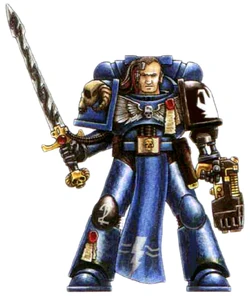
Iron Hands Lexicanum
Like their fellow Astartes Chapters, the Iron Hands also maintain a Librarium of potent psykers who are highly talented and trained to master the power of the Warp at the highest levels. As Iron Hands, they too abhor weakness and infirmity in all its forms. Therefore, they train their minds constantly to reinforce their willpower to control their powerful psychic abilities as stoically and unyielding as Adamantium. Though they stand apart from their fellow Battle-Brothers because of their innate abilities, the need for vigilance is never treated lightly, and theLibrarians of the Iron Hands Chapter routinely engage the minds of its Space Marines in order to ensure their purity and fortitude. Like their fellow battle-brothers, they too, are driven to replace the weak biological matter borne by all men, replacing their flesh, limbs and organs with bionic augmetics, each inherently superior to the original in an effort to purge themselves of any perceived weakness of the body.
They are meticulous in their record keeping, chronicling any discovered genetic deviancy for future reference. Battle-Brothers who have been exposed to particular psychic strain and trauma, such as through contact with alien horrors or the warping influence of Chaos, must undergo a series of strict screening and cleansing rituals conducted by the Librarians in order to confirm the integrity of their gene-seed. Like all Space Marine Chapters, the Iron Hands believe that their gene-seed is the Chapter's life-blood, the most invaluable of possessions, and must be kept pure at all costs. Any trace of perversion or corruption within the gene-seed must be eradicated utterly of any weakness or deficiencies if the Chapter is to remain strong and survive. Iron Hands brethren are known to abhor any trace of weakness, even more so than other Astartes Chapters. They are extremely puritanical in their drive to identify and purge weakness.
The Iron Hands' Librarium housed the collective knowledge that the Chapter has acquired over the millennia. Scribes work ceaselessly within its walls, labouring to duplicate the older texts as they are gradually destroyed by time. The Librarians of the Chapter are charged with the upkeep of the Librarium, and it is their responsibility to maintain its integrity.
Like their fellow Space Marine Chapters, the Iron Hands Librarians have a number of unique psychic abilities only used by the psykers of this Chapter:
- Deus Ex Ferrum - When an Iron Hands Librarian focuses his mind, he is able to link his iron will to the strength of his augmetics, bolstering himself and his allies, enabling them to shrug off dire wounds that would halt a normal Space Marine.
- Betrayal of Flesh - Harnessing his hatred for weakness, the Iron Hands Librarian is able to sunder the flesh of his enemies with a blast of pure Warp energy, reducing his enemies to dust.
- Punish the Weak - After fighting alongside his Iron Hands Battle-Brothers for countless battles, the Librarian has learned how to spare their mechanical bodies while assailing his enemies. He is able to summon forth a roiling tornado of force around himself, harshly tearing at the flesh of anyone not strong enough to stand against its assault.
Specialist Ranks
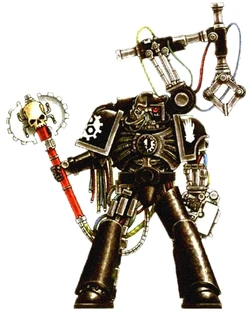
An Iron Hands Iron Father (Techmarine/Chaplain)
- Iron Father - A further departure from the doctrines of the Codex Astartes is the Iron Hands Chapter's complete lack of Chaplains. Given the atypical nature of the Iron Hands’ Chapter dogma, it is not surprising that they espouse a highly divergent form of beliefs. Instead of the conventional Chaplains fielded by most Chapters, the Iron Hands maintain a special cadre of officers known as the Iron Fathers. These individuals combine the qualities of a Chaplain and a Techmarine. To the Iron Hands, the duties of both roles are intricately intertwined. The Iron Fathers oversee the Chapter’s spiritual health, but they also guide the Battle-Brothers in their journey from a being of biological weakness to a warrior of rage and iron. It is the Iron Fathers who administer and oversee the Neophytes' ascension to full Initiate, and who, along with the Chapter’s Apothecaries, conduct the many and escalating cybernetic augmentation surgeries a Battle-Brother undergoes throughout his service. The Iron Fathers are inspirational figures to their charges, shining exemplars of all that the Chapter holds dear. They preach unyielding hatred for the foes of the Emperor, and promise that one day their lost Primarch will return, to bring light to the benighted Imperium as he did to gloomy Medusa over 10,000 Terran years ago. The Iron Father is considered the representative to the Chapter of both the Emperor of Mankind and the Adeptus Mechanicus' Cult Mechanicus. Unlike the Chaplains of other Chapters, however, the Iron Fathers do not receive a Rosarius from the Ecclesiarchy because of the perceived heresy of the Iron Hands' belief in the doctrines of the Omnissiah rather than the standard Imperial Creed. The Iron Fathers are schooled in the mysteries of the Machine Cult to a far greater degree than the Techmarines of most other Chapters. Like all Techmarines, they undergo a portion of their instruction under the supervision of the Tech-priests of the Cult Mechanicus. Yet, while most Techmarines maintain a mutually reserved distance from the Cult of Mars, the Iron Fathers appear to have far closer links, and are schooled in the most obscure of disciplines. Bionics are common place in the Imperium, yet the Iron Fathers are able to reconstruct the bodies of their charges right down to the cellular level, replacing the tiniest of biological functions with far superior mechanical components. It is only by way of the arts of the Iron Fathers and the skills they are taught by the Adeptus Mechanicus that an Iron Hands Space Marine may be transformed from a genetically enhanced warrior to something not far from a pure machine, without losing the essence of what it is to be Adeptus Astartes. A fully mechanised Iron Hands Battle-Brother is far more than an automaton controlled by a scrap of grey matter—he is an unstoppable machine of war fuelled by faith and hatred, and utterly convinced in the purity of the dogma that the flesh is weak, and that iron is strong.
Equipment Shortfall
The disastrous Drop Site Massacre on Istvaan V cost the Iron Hands many, if not most of their Dreadnoughts and suits of Terminator Armour. The limited number that remained became important relics to the Chapter, particularly the mighty Dreadnoughts who symbolise the epitome of the symbiosis of man and machine. Because of this ironic deficiency for a Chapter so dedicated to the pursuit of high technology, the Iron Hands rarely field squads of Terminators, preferring instead to equip Clan Company officers and Veteran sergeants with the precious Terminator Armour to spread its inspirational and uplifting influence to the Astartes of the entire Chapter. It is also rumoured that there may be as few as 8 Dreadnoughts in the entire Chapter, but it is unknown if this is actually true or merely a myth.
Chapter Homeworld
Medusa, the Iron Hands' homeworld, is a realm of perpetual gloom. Its polluted sky churns over a land of raging volcanoes so tall that they illuminate the black clouds from within and above. The people of Medusa are in constant battle with both the elements and each other for access to the planet's limited natural resources. At no point have the Iron Hands sought to end the conflicts between the world's techno-barbarian clans, as such competition weeds out the weak. Only the strong endure, and no compassion is spared for those who cannot survive by their own merits. It is exclusively from these unforgiving and indomitable people that the Iron Hands recruit, and the Chapter's companies bear the ancient names and symbols of Medusan clans instead of numerical designations, for the world, the people, and the Chapter are inseparable.
The skies of Medusa are always dark and choked by volcanic ash, and its lands are blasted and barren. Massive mountain chains rise high above the land and the peaks of the countless volcanoes are so high that they pierce the black clouds and illuminate them from within as if they were gateways to the infernal. The poles are freezing and savage and the Land of Shadows is a silent region of this barren world that is strewn with alien ruins millions of years old that some Imperial savants believe may belong to the ancient Necrontyr civilisation.
Karaashi, the Ice Pinnacle that the newborn Primarch Ferrus Manus' gestation capsule crashed into when he first fell to Medusa, can still be seen today, though it is said to be half the size it once was. A great gaping hole at its peak that spews ash and steam into the atmosphere is evidence of where the shining light of Ferrus Manus crashed millennia ago. Still it rumbles with the constant geological anger of Medusa -- a constant reminder to the planet's people of the need for vigilance. The clans of Medusa prepare for that day when the Ice Pinnacle ceases to rumble Medusa's unease. For that day, it is foretold, will mark the second coming of the great Primarch, and with his return, even the volcanoes of Medusa will at last be content.
The Medusan Inheritance
A cold, barely life-sustaining planet several times the size of Terra located in the outer darkness of the Segmentum Obscurus, Medusa is the fourth world orbiting a supergiant star known in the ancient Terran astrocartographic charts as Sthenelus. In the lost days of human might during the High Dark Age of Technology, the ancient lore of the Mechanicum holds that Medusa was a world deemed of great importance, its depths mined for rare core-strata deposits by vast, tireless robotic engines and its riches guarded jealously from rival species by sleepless guardians. So it was that when the shadow of the Age of Strife fell and all was given over to bloodshed and anarchy, Medusa, unlike so many other lost domains of Mankind, was not forgotten by Mars nor on Old Earth but remained a legend of glory and wealth.
The exact origins of the human presence on Medusa is uncertain, and genetic evidence reveals that it is most likely to have been the result of several different survivor groups, some perhaps dating back to the colonists of the Dark Age of Technology, others almost certainly the stranded remnants of star-wrecks and pre-Navigator sleeper ships launched by the Mechanicum during the Age of Strife to find this fabled world. These antagonistic survivor-waves of the population, confronted by the near-unlivable surface conditions created by the planet's harsh climate, violently unstable geology and lack of native flora and fauna, devolved into techno-barbaric savages. Further forced into a nomadic existence by a constantly shifting landscape where mountain ranges and seas could be forged or unmade in a season, the Medusans retained by rote a degenerate superstition-ridden faith based around the dim memories of the Cult Mechanicus, a vastly uneven trove of weapon-crafting, cybernetic and mechanical lore, but lost all semblance of civilisation beyond that of the basest hunter-gatherer. They formed into mobile, semi-tribal clans, the largest of which were centred on massive fortified land-crawlers (based in part on ancient STC designs for mining and harvesting engines), from which raiding and foraging parties set out to claim meagre resources and make ceaseless war on the other clans. They were a savage and unforgiving people; slavers and killers to whom the battle to survive was an unrelenting, bloody struggle in which only the strongest prospered.
As the Imperial Expeditionary fleets of the Great Crusade broke out of the Segmentum Solar in the late 30th Millennium, following the Warp-tides to the edges of the uttermost unknown, famed Medusa was high upon the Crusade's list of targeted goals, although its exact position was now uncertain. When a Mechanicum Warp-runner, more than a standard year out and alone in the darkness ahead of the main fleets first broke from the Empyrean into the Sthenelus star system and rediscovered Medusa, the sight that greeted them was both unexpected and bleak. The whole range of the system's inner sphere was littered with the debris of shattered voidships, fogs of silicate dust, dead hulks and fractured planetoids, all as cold and silent as the grave. Around Medusa itself, the legendary Telstarax -- the colossal planet-circling orbital ring-station which had girthed Medusa in the Dark Age of Technology to plunder its riches and carry them aloft into space on immense tether-conveyors -- was a tortured ruin, much of it having fallen back to the planet with no doubt catastrophic force. As the Warp-runner closed with the planet, it found itself beset by many dangers, from sudden ionic squalls to erratically functioning mines and autonomous weapons systems -- ancient, but still deadly -- hiding in the debris fields. Wounded, it still went on, lured by the myth of Medusa.
Reaching close orbit, the Warp-runner scanned through the thick and shrouding atmosphere, casting the hard electromagnetic glare of its Auspex on the planet below. It found a world almost lifeless and shuddering with dangerous and near-constant tectonic instability. From the Warp-runner's high vantage point, it could see the worm-coring of played-out mine workings deep beneath the sheet ice and tundra, Medusa's cold ground further riven with immense scars and impact craters, although whether from sky-fallen debris from the Telstarax ring or some ancient orbital bombardment, it could not ascertain. It also heard signals; the ghosts of Vox-traffic in half-familiar tongues and distorted tech-cant codes, and alongside this its Auguries registered the scattered heat-bloom heartbeats of crude but massive thermic reactors at the heart of huge machines crawling across Medusa's broken lands, and within these the sparse Ӕtheric signature of human life.
The glory of Medusa in the Dark Age of Technology had fallen into a wreckage of devolved ruins and barren rock, its wealth spent and ripped from it during the Age of Strife. But amidst the emptiness and despoil, its deep searching of the radiation and signals found something else, something unique that all its kind had been tasked to quest for -- a treasure beyond price -- it found a Primarch.
Chapter Fortress-Monastery
As the volcanic and earthquake-prone geology of Medusa is too unstable to support and maintain a structure the size of a fortress-monastery, the Chapter has been forced to create massive, nomadic bases for each Clan Company. These mobile fortresses, called Land Behemoths, continually traverse the surface of the planet, and are fully automatic, allowing the Behemoth to stay on the move while the entire complement of the occupying Clan Company is off on one of their many crusades across the galaxy against weakness and corruption.
Chapter Combat Doctrine
Pre-Heresy
"As iron sharpens iron, so truth cuts, and war makes right."
- — Ancient Proverb of the Medusan Clans
During the Great Crusade and Horus Heresy in the late 30th and early 31st Millennia the Iron Hands were renowned for being masters of the engines of war, wielding weapons and armoured tanks with the skill a master swordsman might a blade. The Iron Hands Legion's preference for close range, brutal engagements, where their relentless firepower could be brought to its fullest effect, was exemplified by a tactic that became known as the "Head of the Gorgon". This was where the enemy would be brought to battle, held in place and allowed to smash itself to pieces against the body of the Legion's forces, while reserve forces of mechanised armour encircled them, before closing in to create a withering crossfire that eviscerated the heart of the foe's resistance. Proud and relentless, the Legion fought for many years at the forefronts of the Great Crusade, and saw victories uncounted, though many would have labelled them as callous and as inhuman as the machines they employed with such devastating skill.
Post-Heresy
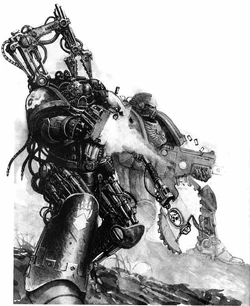
An Iron Father leads the charge against the enemies of the Imperium
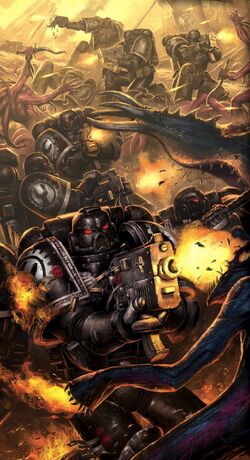
The cold, methodical Iron Hands advance relentlessly against the Forces of Chaos
In the late 41st Millennium, the hatred the Iron Hands feel towards weakness and corruption has an effect on the Chapter's doctrine and operations, a belief that even extends to their own bodies. As an organic form, even the superhuman flesh of the Astartes, can be injured, broken, or led into the temptations or corruptions of the flesh caused by Chaos, the Iron Hands seek to eliminate any perceived fault within themselves through any means possible, usually cybernetic replacement of the body part. In the minds of many Iron Hands, the machine is the ideal. This hatred of all human weaknesses is harnessed and focused by the Iron Fathers for use in battle, where the Chapter will fight with renowned intensity and determination, regardless of the opponent. These bitter Astartes will advance in a machine-like and relentless fashion, throwing themselves violently at the enemy.
Other Chapters of the Adeptus Astartes go into battle differently than the Iron Hands. Each of those other Chapters launch themselves into combat with cries of rage ringing from their Voxcasters, invoking the names of the Emperor and their Primarch to stoke their battle-fury. The Iron Hands are different. In truth, all Medusans are different, raised as they are on a world so choked with scouring winds that opening one’s mouth to shout anything in battle results in nothing more than a mouthful of grit. So the Iron Hands always prepared and trained for combat in silence. When the moment came, they would disembark from their transports in silence, keeping their communications channels free for essential battle signals. When the Iron Hands went to war, the only sound to be heard was the low machine hum of each Battle-Brother's Power Armour. When the Iron Hands advanced, they strode forwards in silence, progressing steadily, soundlessly, moving methodically like the red-eyed golems of ancient Terran legend, laying down Bolter volleys in careful, disciplined bursts. The Iron Hands always advance like automata, never speeding up nor slowing down. They storm across each defensive perimeter they come to, cutting down any who stand in their way. Losing themselves in their hate, an Iron Hands warrior's thoughts in battle are only fosuced on efficiency and slaughter in the pursuit of perfection.
Despite the appearance of moving slowly and methodically in battle, the Iron Hands have the ability to instantly switch to different styles of fighting, as if a switch had been thrown somewhere deep within their black-armoured shells. When the situation warranted it, the Iron Hands had the ability to cast-off their fetters and abandon control. Only rarely did the Sons of Ferrus Manus abandon their meticulous way of war and adopt the ancient rage that lay deep in the gene-heritage of all the Adeptus Astartes. When that happened, there were few forces in the galaxy capable of resisting it: ten thousand years of anger, of rage, of bitterness, all concentrated into a single, machine-augmented storm of vengeance. Despite the massive size of their Power Armour, the rate of acceleration of these deadly warriors during an assault charge is often extraordinary, as the Iron Hands tear across the short distance to their enemies' barricades, swerving with uncanny accuracy around the lines of incoming fire. Once they reach the obstructions erected by their foes, bedlam is unleashed. Still in complete Vox-silence, they rip up ferrocrete barriers with thundering blasts of Bolter fire. They crack open their foes' armour with vicious, sweeping blade movements, lashing out with bionic fists, crunching down with armoured boots and unleashing hurricanes of heavy weapons fire. The Iron Hands rip through enemy resistance like a swollen storm wave crashing into an unprepared coast.
Dreadnoughts and Terminators are rarely used by the Iron Hands because many of these Veteran cybernetic combat walkers and the ancient suits of Tactical Dreadnought Armour used by Terminators were lost in the Drop Site Massacre of Istvaan V at the start of the Horus Heresy. Due to their combination of the organic and the mechanic, the suits of Terminator Armour that remain are treated with great respect. Entire squads of the Iron hands' elite Morlocks Terminators will rarely be fielded, but the inspirational feeling they create among the rank-and-file is harnessed by allowing Veterans equipped with Terminator Armour to lead squads of Tactical Marines. For similar reasons, Dreadnoughts will lead forces when the occasion demands, and several of the Clan Companies' leaders are contained within the armoured sarcophagus of a Dreadnought. Needless to say, the Iron Hands' reclusiveness, obsession with replacing their flesh with bionics and their unusually close relationship with the Adeptus Mechanicus are often viewed as unhealthy by other Astartes Chapters and other Imperial Adepta like the Inquisition and the Ecclesiarchy.
When the Iron Hands march into battle, they do so alongside a profusion of war machines and main battle tanks. The Chapter boasts a great number of armoured vehicles and Dreadnoughts -- so many, in fact, that each Clan Company maintains its own revered armoury of battle tanks and Centurion warsuits. Iron Hands Battle-Brothers consider it a great honour to crew one of their Chapter’s venerated war machines and interface directly with their vehicles through bionic implants, their heartbeat becoming the thrum of powerful engines and their war cries the roar of heavy gunfire.
All Iron Hands brethren are bionically enhanced in some way, for even the most recently initiated Battle-Brother has had his left hand replaced with the iron-sheathed cybernetic gauntlet that marks his acceptance into the ranks of the Chapter. Within a few years of their initiation, most Battle-Brothers sport a burgeoning array of cybernetic augmentations, many of which stay hidden under their Power Armour. In many instances, these enhancements bolster the Battle-Brother’s combat effectiveness in some manner, influencing the tactics he utilises on the battlefield. At the very least, replacing organic flesh with steel increases the body’s resistance to physical trauma. Individual Iron Hands brethren utilise a wide range of bionics that afford them capabilities beyond that of even the already superhuman Space Marines, including highly esoteric Augur receivers bonded directly to the nervous system, inbuilt weaponry, and even, in some cases, additional limbs granting the Battle-Brother the ability to carry especially cumbersome weaponry.
The exact nature of the enhancements an Iron Hands Battle-Brother undergoes is unique to himself, a lifelong program coordinated according to the arcane counsel of the Iron Fathers. Even within the ranks of a single squad of Battle-Brothers initiated at around the same time, there is little cohesiveness. On very few recorded occasions, Battle-Brothers with a complementary range of enhancements have been grouped together into a single squad, or else squadmates have undertaken to coordinate their surgeries. Such squads rarely adhere to any particular pattern or standard doctrine and their composition may never be repeated again.
Chapter Beliefs
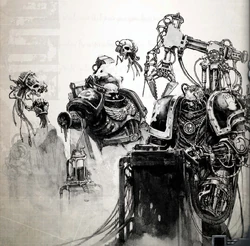
A newly inducted Battle-Brother receives his first Augmetic implant

Though sorely wounded, a lone Iron Hands warrior stands resolute in the face of defeat
The Primarch of the Iron Hands Legion was the first to die by violence as a casualty of the Horus Heresy; a loss made more tragic by the fact that it was the hand of a one-time brother and friend that dealt the blow. Since that dark day on Istvaan V, there have been a great many rumours and legends that have grown up around this fateful death, masked as it is by the anarchy and destruction loosed on the battlefield and by the lies of the enemy, whose murderous counter-assault enveloped the Primarch and his bodyguard at the end. It is said that the bitter rage of the Iron Hands was born in the fires of betrayal upon Istvaan V during the Drop Site Massacre. The most horrific loss in that battle was the loss of Ferrus Manus, the Iron Hands' Primarch. He disappeared during the massacre following his combat with the Emperor's Children's Primarch Fulgrim, and his body was never found or recovered. Rather than fall into despair, the Iron Hands took refuge in their hate, and they have used that hatred to eliminate any perceived weakness in themselves so that they may remain strong. By removing the dangerous failings of the flesh, the Iron Hands believe that they are eradicating any threats to the eventual dominance of Mankind over the galaxy.
The Iron Hands are ultimately defined by their hatred of weakness of any kind, a hatred that extends to their own bodies, for they hold that all organic bodies, even those of a genetically-enhanced Space Marine, are ultimately frail and subject to the weaknesses brought on by age and disease. The Iron Hands are compulsively driven to replace their own biological flesh with cybernetic replacements, a practise that begins as soon as a Neophyte is initiated into the Chapter. The Initiate's left hand is surgically removed and replaced with a Bionic prosthesis in a ritual inspired by the tale of Ferrus Manus' own hands becoming encased in "living metal" after the mythical battle with the great serpent on Medusa composed of the same material. Some Initiates choose to sever their own hands during the ceremony, whilst others plunge it into the searing lava that flows from the volcanoes on Medusa, bearing the pain as their hand is burned away, and transforming it into the first brick in their wall of hate.
Iron Hands brethren abhor any trace of weakness, even more so than other Chapters. They are extremely puritanical in their drive to identify and purge weakness, and they are damning when they perceive it in others around them. They are quick to anger, even if their anger is sometimes expressed in coldly flat, mechanical tones. They are blunt and uncaring of any offence they might give in their criticisms of others, even the staunchest of allies. When confronted with allies who themselves are quick to anger, it is not unheard of for bitter arguments to erupt, and even for blows to be struck. In battle, the Iron Hands are coldly resolute, seemingly unmoved by their own losses. They utilise their anger and their hatred of weakness, identifying their enemy’s vulnerabilities and exploiting them ruthlessly. While the Iron Hands seek ultimately to purge and militate against what they perceive as their own weakness, they also seek out the weakness in their foes in order to punish it without mercy. Many Iron Hands Battle-Brothers scourge their flesh, inflicting pain and scarring on themselves as a constant reminder of the weakness of organic bodies. As more of their bodies are augmented, the areas of available flesh are reduced, until those few that are still visible are a mass of scar tissue. Only when even these last few shreds of the Space Marine’s biological inheritance is gone is he truly free of physical pain, for their implants may be sensate, but they can never know true hurt.
Throughout an Iron Hand's lifetime, he grows ever more angry towards his foes and even more resentful of his own remaining organic flesh. He appears to actually come to hate himself, or at least his biological form, as if he were forcibly garbed in filthy, unclean garments. More of his organs and limbs are replaced with bionic augmetics, each of which is inherently superior to the biological original. To many outsiders, this process can even be considered a form of blasphemy, for many of the organs that have been discarded are those that make an Astartes the genetically-engineered marvel that he is and which are derived from the sacred genomes of the Emperor and his gene-sons the Primarchs. However, a Veteran Battle-Brother of the Iron Hands who has served the Chapter for several Terran centuries is likely to be almost entirely inorganic in nature with every visible swathe of flesh replaced by gleaming metal. Many Iron Hands officers' biological bodies consist of nothing more than the brain and a few remaining major organs like the heart. It is believed by some Imperial savants that the oldest Iron Hands, who survive countless battles and the strains of their own self-hate-induced transformation into cybernetic beings, are no more than a human brain encased within the Ceramite shell of their Power Armour.
Because of this unique drive towards the replacement of their own flesh with the mechanical, many of the Chapter's leaders are entombed within the metallic sarcophagus of a Dreadnought, which is considered a great honour of the Chapter and the primary path to leadership. These Dreadnoughts form the Chapter Council, as the Iron Hands have no individual Chapter Master. Each company of the Chapter is actually a semi-independent body of its own, maintaining a mobile fortress-monastery that trawls across the endless volcanic wastes of Medusa to protect its people from their own weakness and recruit the strongest amongst them into its ranks as Neophytes.
Some claim that the Chapter's hatred for the flesh is the manifestation of a strange psychological corruption to be found within their gene-seed and certainly the Iron Hands Legion sired only a few Successor Chapters that can be definitively linked back to the get of Ferrus Manus. Whatever the cause of this strange affliction, the Iron Hands' determination and effectiveness as defenders of the Imperium cannot be questioned, as so many of the Emperor's foes have learned to their regret over the centuries.
Chapter Gene-Seed
The extreme hatred the Iron Hands hold for the weaknesses of the flesh is believed to gloss over an underlying psychological fear of their physical form. As an Iron Hands Space Marine matures, that hatred and fear grows ever stronger, resulting in more extreme mechanisations of the Astartes' body. It is unclear from where this fear may originate, though many in the Adeptus Mechanicus believe that the source is a flaw in the gene-seed of the Chapter that originated some time after the death of their Primarch on Istvaan V. This flaw seems to be controlled or at the very least made moot by the increasing mechanical augmentations Iron Hands Astartes undergo.
Despite their own opinions to the contrary, the Iron Hands are still human beings, however augmented, and they shared in the full range of blessings and curses of that particular state. Among the psychological states that afflict Mankind are those in which a healthy subject comes to harm himself. A person lets himself waste away through neglect, or cuts his own flesh, or desires to have limbs amputated where no wound has been inflicted. The image he has of his body is distorted, and it is difficult for others to understand such an impulse, since they can have no insight into what he sees when he stands before a mirror.
The body of a Space Marine is the most perfect human form ever created, given every augmetic aid known to the Adeptus Mechanicus. Nothing can be compared to it in power and facility. An ordinary human could not imagine what degree of mental trauma would be required for a human to give up such a gift, to mutilate themselves and replace their priceless gene-forged heritage with mechanical parts. Those of the Machine Cult take ordinary bodies of flesh and blood and improve upon them. They do so because they desire to improve on what they were born with. The Iron Hands cannot make their bodies better, since they are already nearly perfect expressions of the human form. Nevertheless, they choose to amputate their limbs in favour of metal parts and aspire to the state of machine-hood. They do so because they fear their flesh. They look at it in the mirror of their minds and they see something loathsome. This condition gets worse the longer they serve as Astartes. Some individual Battle-Brothers of the Chapter recognise this as the flaw that it is, while others do not. Eventually this compulsion claims them all.
There is a myth, a rumour, still repeated amongst the Tech-priests of Mars, that the Iron Hands' Primarch knew of this weakness and wished to purge it. Many within the senior circles of the Mechanicus had seen scrolls, purportedly written in the hand of Ferrus Manus, that stated the matter clearly. No one knew if these scrolls were genuine. Even if Ferrus intended it, he died long before he could accomplish it. The Iron Hands no longer place trust in their gene-wrought perfection. They do not see the universe in the way that most of humanity does. When an Imperial ally advocates a course of action that seems prudent -- to slow the pace of the attack, to conserve strength, to protect their exposed flanks -- they see only weakness. It reminds of them of their own inherent bodily weakness, and so they recoil from it, unaware that their own morbid fear of weakness is in fact the most obvious expression of that which they so fear.
The Iron Hands Chapter has become increasingly reclusive and hostile towards outside interference since the Horus Heresy. Though the Inquisition continually investigates the Iron Hands, the Chapter bears such scrutiny with unconcealed disdain. Strangely, the Inquisition does not appear very concerned with the Iron Hands Chapter's many deviations from standard Adeptus Astartes and Imperial practice. Despite having apparently identified some aberrations within the Iron Hands, the Inquisition has chosen not to act against them, seeing their existence as a useful way to later enforce their will upon the Chapter, if necessary. The Inquisition seems to have decided the flaws within the Iron Hands are not particularly dangerous to the Imperium and the effectiveness of the Iron Hands as defenders of the Imperium cannot be questioned. The peculiar traits of the Chapter have precluded the Adeptus Mechanicus from making use of the Chapter's gene-seed in new Foundings and so only a few other Iron Hands Successor Chapters have been created in the centuries since the Horus Heresy.
Notable Iron Hands
- Ferrus Manus - Ferrus Manus, also known as The Gorgon, was the Primarch of the X Legion, a master smith known for creating weapons that were able to inspire awe in any who saw them. Ferrus' hands were covered in the metallic substance known as necrodermis and he needed no hammer or flame to create beauty through metallurgy, using only his exceptionally powerful hands to mold and shape molten metal. Ferrus forged his closest bond with his brother Primarch Fulgrim of the Emperor's Children Legion, but this relationship ultimately ended in tragedy after Fulgrim fell to Chaos during the Horus Heresy. During the tragic Drop Site Massacre on the world of Istvaan V at the start of the Heresy, Fulgrim and Ferrus met in mortal combat. But ultimately, Fulgrim emerged triumphant when he decapitated Ferrus's head with the daemonic sword he had taken from the xenos world of Laeran.
- Lord Commander Amadeus DuCaine - Lord Commander Amadeus DuCaine was the commander of the X Legion during the latter years of the Unification Wars and the early years of the Great Crusade in the late 30th Millennium before the redicovery of the X Legion's Primarch, Ferrus Manus.
- Iron Father Autek Mor - Autek Mor, known as "The Maimed" and the "Blood-Wrought", was both Iron Lord and Iron Father to the Morragul Clan Company during the Great Crusade. Autek Mor held a sinister reputation within his Legion, and dark rumours accompanied him long before the outbreak of the Horus Heresy, including whispered accusations that the origins of his gene-seed or perhaps his bloodline were not as they should be. A Terran by birth, he was a part of the X Legion's first intake and fought in the re-conquest of the Sol System. He held field command by the time of his Primarch's discovery, having already developed a reputation both as a weaponsmith and malevolent soul, already having killed several Astartes of his own Legion in duels over "slights of honour." He ruled his company with a cruel and unforgiving fist. His Morragul Clan became a sink for the outcasts and most unstable elements of the Iron Hands Legion, who fought and died under Mor's merciless command. No love was lost between Autek and his Primarch, but despite this, when his Grand Cruiser, the Red Talon, arrived at Istvaan V during the Drop Site Massacre when the void battle was at its height, he attacked in an attempt to reach the surface and was only driven off after sustaining massive damage, fleeing the system dogged by murderous pursuit.
- Iron Father Kardan Stronos - Kardan Stronos is the de facto current Chapter Master of the Iron Hands Chapter. Of all the Iron Fathers to have led the Iron Hands Chapter, none echo the glory of their Primarch Ferrus Manus more than Stronos. Since the loss of their Primarch, no single warrior has ever permanently led the Iron Hands. Instead, they are guided by the Council of Iron Fathers who appoint one amongst their number to command, according to the needs of the Chapter. So it is that an Iron Father might lead for the course of a campaign for which his particular skills make him singularly suited, and whilst that war rages, he wields all the power and responsibility of a Chapter Master. Upon the mission’s conclusion, he cedes power back to the Iron Council, who then calculate the next Iron Father to lead them. It is testament to Kardan Stronos' skill as both warrior and commander that he has been reappointed as head of the Iron Council for over three hundred consecutive years.
- Captain Pelles - Commander of the Vurgaan Clan Company. Pelles was recruited at the same time as Iron Father Gdolkin and sports two service studs denoting over two hundred years of service to the Chapter. Where Gdolkin showed an aptitude for machines, Pelles showed an innate understanding for tactics and command, leading to his rise to command of the Vurgaan Clan Company.
- Captain Arven Rauth - Arven Rauth is the Lord Clan Commander of the Raukaan Clan. Once set to a purpose, he will not stop until his objective has been achieved. He will neither deviate from his goal nor slacken. This is not a trait unique to him, but a characteristic of the entire Iron Hands Chapter. Rauth led the Raukaan Clan in the Purging of Contqual on the world of Melamar Secundus, against the Forces of Chaos in 812.M41. Later, the Raukaan Clan would take part in the Battle of Medusa, defending their Chapter homeworld during the 13th Black Crusade in 999.M41.
- Captain Dozeph Imanol - A former Lord Clan Commander of the Raukaan Clan and predecessor of Arven Rauth.
- Captain Rumann - Given overall command of the Astartes elements of the Damocles Gulf Crusade.
- Captain Sien - Captain Sien commanded the small Iron Hands force present during one of the largest armoured battles in Imperial history at the Battle of Thranx in the 36th Millennium.
- Iron Captain Strake - Strake was the Captain of the Strike Cruiser Ajax since the Grailsword Campaign. Captain Strake lost his legs during a battle with a Tyranid Hive Fleet when the Ajax was crippled and nearly destroyed. Strake survived the combat, but instead of having his legs replaced with augmetics he requested he be fitted to an anti-gravity platform with technology based on that used in Servo-skulls.
- First Captain Gabriel Santor - Gabriel Santor hailed from the Avernii Clan on the X Legion's homeworld of Medusa. He served as the Equerry to the Primarch Ferrus Manus as well as the First Captain of the Iron Hands Legion's elite 1st Company and elite Honour Guard, known as the Morlocks, during the Great Crusade and the opening days of the Horus Heresy. When the Emperor's Children were corrupted by the Warmaster Horus of the Sons of Horus Legion, they attempted to sway their fellow cousins, the Iron Hands, to the Warmaster's cause. Gravely miscalculating Ferrus Manus' response to his offer, the Emperor's Children's Primarch Fulgrim callously attacked his brother, leaving him gravely wounded, as well as having ten of his elite praetorians cut down in a cowardly attack, that left Gabriel Santor near death. Enraged by this base betrayal, Ferrus Manus led his Honour Guard in the initial first wave assault during the tragic events of the Drop Site Massacre on Istvaan V. Overextended and cut-off by the Warmaster's treacherous trap, Gabriel Santor was confronted by the Chaos-corrupted Emperor's Children First Captain Julius Kaesoron, and was ultimately slain, just as Ferrus Manus was killed by his former brother Fulgrim. In the ensuing battle the two Space Marines were mortally wounded and left in agony. Enthralled with the exquisite feeling of agonising pain, Kaesoron thanked the Iron Handa as he lay beleeding in the dust of Istvaan V. "Thank you...that was exquisite..." These were the last words Santor heard before he died, his Primarch slain and his entire Legion also near death.
- Captain Ulrach Branthan - Ulrach Branthan was the revered Captain of the Iron Hands' 65th Company, an iron-blooded son of the Nirankar Clan. He had survived the massacre of the killing grounds of the Urgall Depression on Istvaan V during the Drop Site Massacre, sustaining horrific wounds that left him in permanent agony. Both his legs were horribly mutilated, one little more than stringy sinews of ruptured meat and heat-fused bone, the other severed just above the knee. One arm was held to the body by a splintered nub of bone and tattered scraps of skin. His arm was missing much of its mechanical structure and all but one of the fingers had been broken off in the flight from the Istvaan System. Branthan’s chest was a ruin of four Bolter impact craters that ran in a ragged line from hip to sternum. Gathering with the remnants of the Iron Hands Legion that had fought their way off of Istvaan V, Branthan joined the ad hoc group of survivors of that battle aboard the Iron Hands Strike Cruiser Sisypheum as it fled the Istvaan System. Under normal circumstances the Captain would have been accorded the honour of being interred within the cybernetic chassis of a Dreadnought, but such an option was unavailable due to the X Legion's severely limited resources. Though there were those amongst the surviving Iron Hands that demanded the Captain be removed from his stasis sarcophagus and allowed to live again as their only functional Dreadnought, Branthan had graciously declined the offer. The only thing that kept him alive was his own indomitable will and the miraculous arcane cybernetic replacement organ known as the Heart of Iron, as well as the stasis field generated within his casket. Despite his condition, he took command of the desperate survivors of the Drop Site Massacre aboard the Sisypheum and led them in a successful series of hit-and-run attacks against the hated Traitors in service to Horus over the months after the disaster on Istvaan V.
- Captain Balhaan - Balhaan was a Captain of the Iron Hands Legion during the Great Crusade and commander of the Primarch's temporary flagship, the Strike Cruiser Ferrum. Like the vessel he commanded, Baalhan was stark and unforgiving, as befitted a warrior of the Kaargul Clan. No man who served under him had ever dared question his orders and no man had ever failed him. His Mark IV Power Armour was polished a lustrous black, and a white, wool cloak embroidered with silver thread hung to his knees. An Orks' cleaver had taken his left arm and a Deuthrite flenser his right. He had received the Blessing of Iron; both his arms were heavy augmetics of burnished iron. Balhaan welcomed his new mechanised limbs, for flesh, even Astartes flesh, was weak and would eventually fail.
- Vermanus Cybus - Vermanus Cybus was the senior surviving Morlock veteran of the Drop Site Massacre on Istvaan V. Gathering with the remnants of the Iron Hands Legion that had fought their way out of the killing grounds of the Urgall Depression on Istvaan V, he joined the ad hoc group of survivors of that battle aboard the Iron Hands Strike Cruiser Sisypheum as it fled the Istvaan System. Cybus possessed multiple chimeric bio-modifications and had been viewed as nearly pathological in his reverence for the machine and his loathing for flesh. In truth, Cybus was a warrior not even his Battle-Brothers could be around for any length of time, for adherence to the doctrines of augmetic superiority had already spread through many of the Battle-Brothers of the Iron Hands Legion even before the death of Ferrus Manus and his warning against such beliefs to the X Legion. Before the betrayal at Istvaan, Cybus had fought beside the warriors of the Emperor's Children Legion on numerous occasions. He had always respected the III legion's devotion to the attainment of perfection, finding much to admire in the Emperor's Children's martial ethos. Many years earlier, Cybus had argued long into the night with a young officer of the III Legion named Rylanor on the merits of organic strength against augmented power, mocking the Legionary’s faith in his flesh while extolling the virtue of iron. Cybus was an uncompromising man of little personal charisma, but he had a secutor's grasp of the methodology of combat.
- Septus Thoic and Ignatius Numen - This duo of Morlocks veterans were some of the very first Iron Hands warriors to make planetfall on Istvaan V, having marched alongside the best and bravest of the X Legion. Gathering with the remnants of the Legion that had fought their way out of the killing ground of the Urgall Depression on Istvaan V, they jjoined the ad hoc group of survivors of that battle aboard the Iron Hands Strike Cruiser Sisypheum as it fled the Istvaan System. The Iron Hands and their mortal serfs formed the bulk of the survivors to take refuge on that starship, but warriors of the Salamanders and a single Raven Guard Astartes were counted amongst their number as well. The months that followed saw the Sisypheum embark on a series of hit-and-run attacks on Traitor forces on the northern frontiers of the galaxy, wreaking harm like a lone predator against the hated Traitors of Horus. Like all those who had escaped the Drop Site Massacre, they had cut their warplate with the names of the fallen, and the black armour of these two Morlocks was inscribed with intricate scriptwork, each name inscribed over the cuts, tears and burns inflicted on Isstvan V. But these warriors had a name acid-etched on their shoulder guards that marked them out as special even in a brotherhood of remarkable warriors, that of Ferrus Manus, for they had seen their Primarch die at the treacherous hands of his brother Fulgrim. Like other veterans of the X Legion, they had refused to repaint or repair their armour until the Traitor who had murdered the Iron Hands' Primarch was dead. Thoic's face was bisected by a curling series of scars inflicted by a laughing swordsman of the Emperor's Children, while Numen's features had the plasticised sheen of synth-skin after a close-range plasma detonation had seared the ceramite of his battle helm to his skull. His flash-burned eyes had been replaced by simple targeting optics, but his hearing was almost entirely gone.
- Veteran Legionary Mokan - Veteran Mokan was a part of Squad Demetae, Terminator Century, Order Quarii, of the Clan Vurgaan during the Great Crusade. He was assigned to the leading edge of Clan Vurgaan's deployment to the surface of Istvaan V. While many of the Clan's companies deployed via Drop Pod, the Terminator Century of the 4th Order (Order Quarii) is known to have teleported directly to the dropsite in order to secure the landing zone. While the massed Terminators of the Iron Hands' Avernii Clan assaulted the Traitor fortress-line, Squad Demetae is known to have survived into the Drop Site Massacre's third hour before destruction under heavy bombardment.
- Spearhead-Centurion Castrmen Orth - Known as the "Hell Rider", Spearhead-Centurion Castrmen Orth was one of the most highly regarded tank commanders in the Iron Hands Legion during the last days of the Great Crusade, and the youngest to hold his rank. Orth's "Subjugator" armoured battalion was chosen among all of the Gorgon's forces to accompany him and the veterans of the Avernii Clan aboard the Ferrum in the Primarch's enraged pursuit of Fulgrim and his Emperor's Children following the start of the Horus Heresy. On Istvaan V, Orth first took charge of the Iron Hands super-heavy tank spearhead in the battle and survived the destruction of the Fellblade Rashemion at the frontline. Afterwards, he took charge of the Sicaran tank Black Sun and redeployed to take charge of Loyalist fast-armour elements in a successful counter-attack against an attempted Traitor outflanking assault. What happened to Orth after the Drop Site Massacre trap was closed and the second wave of Traitors assaulted the Loyalists remains a matter of conjecture, but it has long been rumoured that Orth survived, though he was badly disfigured, abandoning his name and rank in shame, but not his burning desire for vengeance against the Traitors.
- Venerable Dreadnought Axagoras - The third Iron Hands Dreadnought currently serving on the Clan Council. Axagoras is a legendary figure in the Chapter whose most notable accomplishments include his battles against the Kartha and Sheed xenos of the Durian Sub-sector and his command of the Xerxes Campaign. The tactics Axagoras developed in the Xerxes Campaign are now mandatory study for new Initiates to the Chapter. Axagoras favors a Plasma Cannon weapon mount.
- Venerable Dreadnought Bannus - Bannus served his Chapter as a Captain of a Clan Company for many centuries, nearly losing his life on the industrial world of Kaladrone, he was saved by the legendary Iron Father Paullian Blantar. Eventually Bannus was interred within an ancient Dreadnought sarcophagus and now serves as one of the most respected figures in the Iron Hands Chapter, a voice of great wisdom on the Great Council and a war leader of supreme skill.
- Venerable Dreadnought Anatolus Gdolkin - Iron Father Anatolus Gdolkin was given command of the Strike Team sent to aid Magos Omega Thule during the 13th Black Crusade. Gdolkin was accompanied on the mission by his blessed Combat Servitors Gideon XII, Joab XIII, Gibal 674, and Ishmael 192. While critically wounded in combat against the Word Bearers Dark Apostle Iscariot, Gdolkin survived his mission and was interred within a venerable and sacred Dreadnought of the Chapter.
- Venerable Dreadnought Talumech - A member of the Chapter Council and a revered Dreadnought-Brother of the Chapter, Talumech goes to war armed with a mighty twin-linkedLascannon in addition to the close combat weapon borne on the left arm of all the Chapter’s Dreadnoughts.
- Dreadnought Comech - Dreadnought of the Iron Hands Legion during the Horus Heresy.
- Dreadnought Veneratii Urien - Veneratii Urien was once Centurion of Clan Vurgaan's 4th Order (or Order Quarri), a warrior feared for his uncompromising rule during the Great Crusade. Urien was a Terran rather than a Medusan, and one who had fought with the X Legion long before its union with its Primarch. He fell during a battle against the xenos Psy-Gore less than a decade before the Battle of Istvaan V, and was subsequently interred within a suit of Contemptor Pattern Dreadnought armour, curtailing his rise to high command, but ensuring he would continue to serve his Legion.
- Ancient Morn - Ancient Morn was one of Clan Avernii's most respected warriors, serving within its 1st Order (or Order Primii) during the Great Crusade. He served in the Avernii's Terminator Centuries of the Iron Hands Primarch's Morlock Honour Guard, fighting alongside Ferrus Manus himself throughout countless battles. Morn fell in battle at the height of the Battle of Gardinaal Prime early in the Great Crusade, his body crushed beneath the iron tread of one of the gargantuan combat walkers fielded by the Lords of Gardinaal. Interred within the armoured sarcophagus of a Contemptor Pattern Dreadnought, he continued his sterling service to his lord and master. Morn's service is thought to have come to an end amidst the savagery and bloodshed as he fell defending the decapitated body of his slain Primarch upon the blood-soaked ground of Istvaan V during the Drop Site Massacre.
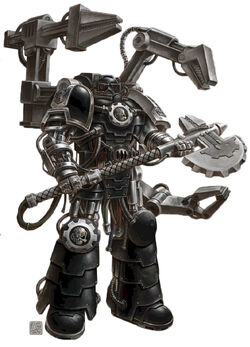
Master of the Forge Xerill, Iron Father seconded to the Deathwatch
- Master of the Forge Xerill - Xerill is an Iron Father of the Iron Hands Chapter who is currently seconded to the Deathwatch and has served as a Master of the Forge for close to eight Terran decades. He joined a handful of like-minded, inquisitive Deathwatch Space Marines that have been drawn back to the study of nearly-deserted Watch Stations, now known as the Dead Stations, and the ancient traces of knowledge and prophecy they contained. These few members have since dedicated their lives to finally unravelling the enigma of the Jericho Reach known as the Dark Pattern -- a series of mysterious events that continue to unfold, presaged in numerous ancient prophecies foretelling of great strife and darkness are coming to pass in this area of space. Thanks to their interest in the Dead Stations, their peers refer to them as the "Dead Cabal." Xerill was inducted into their ranks fifty standard years ago after he recovered a series of Eldar Spirit Stones. His passion for understanding and unlocking the knowledge contained within xenos artefacts drew the attention of Inquisitor Ramaeus, who had him reassigned to permanent detail on the Dead Stations Vigil. Since that time, Xerill has embraced the Dead Cabal and has dedicated his tenure with the Deathwatch to studying as many xenos artefacts as he can. He is especially fascinated by anything relating to the Necrons and has undertaken many missions based on the slightest inclination that there could be Necron activity involved.
- Iron Father Paullian Blantar - Paullian Blantar is an Iron Father from the Kaargul Clan Company. This inspirational figure embodied every one of the Chapter's teachings, from the utter certainty that Ferrus Manus would day return, to the hatred of all that is of the flesh. His knowledge of bionic enhancement is unparalleled, and his refinements of the augmentation process distinctly affected the direction of the Chapter. He led the dramatic counter-attack against the insidious Dark Eldar on the industrial world of Kaladrone, rescuing the badly wounded Warleader Bannus. Blanter personally performed the augmetic surgeries and augmentations that enabled the crippled form of Bannus to survive and go on to lead his company for many centuries to come. In fact, Bannus still leads his Clan Company as an ancient Venerable Dreadnaught and is an integral part of the current Great Council. Bannus' wisdom and experience continue to serve the Chapter to this day. Of equal legendary status was Blantar's disdain for his own organic body. Blantar constantly flayed his own body of the flesh he was born into, until eventually, towards the end of his extremely long and successful life-span, only his mind remained. This was implanted into the towering frame of a mighty Dreadnought, and some say that in so doing his very soul was ex-loaded into the machine’s systems so that not a scrap of biological matter remained. Blantar serves as a permanent member of the Chapter Council, having transcended the limits of his flesh and effectively attained immortality. Should Ferrus Manus ever return, as Chapter dogma asserts he will, it is certain that Paullian Blantar and any others who replicate his feat will be there to greet their Primarch, and to fight at his side in the final battle. To this day Iron Fathers ritually scar their flesh in honour of one of the Chapters most renowned Iron Fathers of all time.
- Iron Father Gebren - Ever since the dawn of the Great Crusade, the most technically adept members of the Astartes Legions have been sent to Mars to be trained as Adepts in the Cult Mechanicus, and Iron Father Gebren was one of the first and best. Gebren served during the Great Crusade and on through the dark days of the Horus Heresy. Gebren was trained by none other than Fabricator Locum Kane, who would later become the Fabricator-General of Mars after the betrayal of Kelbor-Hal during the Schism of Mars.
- Frater Thamatica, "Ironwrought" - Frater Thamatica was an Iron Father of the Iron Hands Legion, a member of the Morlocks, and a survivor of the killing fields of the Urgall Depression on the world of Istvaan V. It was Thamatica who helped establish contact with the disparate groups of Loyalist forces whohad escaped the Drop Site Massacre, and he helped develop a stratagem for their survival. With the X Legion too scattered to function in a traditional battlefield role, its surviving commanders found their own way to fight back. Thamatica escaped alongside the remnants of the X Legion and joined the ad hoc group of survivors of that battle aboard the Iron Hands Strike Cruiser Sisypheum as it fled the Istvaan System. Following the Drop Site Massacre, Thamatica had become the longest-serving Iron Father left alive in the X Legion.
- Iron Father Diederik - Iron Father Diederik served with Captain Balhaan during the Great Crusade aboard the Strike Cruiser Ferrum.
- Librarian Madeus - A member of the Clan Council, Madeus has the honour of wearing a suit of modified Terminator Armour.
- Librarian Melchor - Librarian attached to Iron Father Gdolkin’s Strike Team during the Thirteenth Black Crusade. Melchor sacrificed himself to teleport the survivors of the Strike Team to the bridge of the Strike Cruiser Ajax. Melchor had the honour of wearing a suit of revered Terminator Armour.
- Apothecary Caduceus - Apothecary of the Vurgaan Clan Company and member of Gdolkin’s Strike Team during the 13th Black Crusade. Caduceus was one of the few survivors and was also a member of the Strike Team’s Command Squad.
- Veteran Sergeant Miel Erastus - Member of Iron Father Gdolkin’s Strike Force during the 13th Black Crusade, one of the few members of the Strike Force to survive the mission and return to Medusa. Sergeant Erastus fought alongside Gdolkin on numerous occasions, including the battle for the Diocletian Gate on the Chaos-contested Hive World of Manastus VII where the sergeant lost his left hand a second time while defending the last operational spaceport.
- Veteran Brother Avidan - A respected and legendary warrior within the Iron Hands Chapter, Brother Avidan wears one of the Chapter's revered suits of Terminator Armour and holds a seat on the Clan Council.
- Clan Champion Oros Telemar - Oros Telemar was a Clan Champion of the Iron Hands Chapter. In 237.M38, Clan Garrsak of the Iron Hands was deployed to the Herevok Sector to help put down an insurgency that had gripped more than twenty worlds. Upon their arrival, they discovered that the rebels were, in fact, Chaos-tainted Heretics, aided by Traitor Marines from the Emperor's Children Legion of old. The Iron Hands fell upon their ancient foes with relish, cleansing them from world after world in the name of Ferrus Manus, slain in a bygone age by the Emperor's Children Primarch Fulgrim in an act of fratricide which changed history. Taking a handful of Space Marines with him, Telemar crossed the sector in pursuit of his quarry, eventually chasing him down to an airless asteroid on the outskirts of a long-abandoned planetary system. There, Telemar and his men engaged Lucius the Eternal, the Chaos-corrupted swordsman and Champion of Slaanesh. Eventually, Telemar prevailed, striking the Traitor down and taking his sabre and whip to display as trophies of victory on the Iron Hands homeworld. When he returned to the clan, the war was over, and the Iron Hands departed for Medusa. When their ship arrived in orbit around the Iron Hands homeworld, the vessel was silent, refusing to answer hails or follow recognised approach vectors. Ship's logs revealed much to the Iron Hands' horror that Telemar had begun to change, ritually scarring himself and repainting his armour in wild and sickening colours. Eventually, his will had snapped and he had rampaged through the ship, killing all the crew and passengers with the weapons claimed from the Traitor, before entering a saviour pod and disappearing into the depths of the Immaterium. To this day, none are sure exactly how this happened, though this is well, as to try and explain the methods of Chaos is to invite madness. Later sightings of Lucius in war zones across the Imperium and beyond have only added to this mystery.
Chapter Fleet
The following vessels were a part of the Iron Hands Legion fleet during the Great Crusade and Horus Heresy eras or the Iron Hands Chapter fleet after the Second Founding:
- Fist of Iron (Gloriana-class Battleship) - Former flagship of the X Legion and its Primarch Ferrus Manus.
- Metallus (Battle-Barge) - Vessel that was destroyed during the Imperial Compliance action against the xenos-human alliance of the Diasporex during the Great Crusade.
- Ajax (Strike Cruiser) - Attached to Iron Father Gdolkin’s Strike Team during the 13th Black Crusade.
- Armourum Ferrus (Strike Cruiser) - This vessel participated in the Imperial Compliance action against the Diasporex during the Great Crusade.
- Ferrum (Strike Cruiser) - Named for the X Legion's Primarch, the Ferrum participated in the Imperial Compliance action against the Diasporex during the Great Crusade. During this era, the Ferrum had served faithfully in the Iron Hands' 52nd Expeditionary Fleet for almost a standard century and a half. For sixty of those years it had been under Captain Balhaan’s command and he prided himself on the fact that it was the best starship and possessed the best crew in the Iron Hands' Expeditionary Fleet.
- Heart of Gold (Strike Cruiser) - Vessel that was destroyed during the Imperial Compliance action against the xenos-human alliance of the Diasporex during the Great Crusade.
- Iron Dream (Strike Cruiser) - Vessel that was destroyed the Imperial Compliance action against the xenos-human alliance of the Diasporex during the Great Crusade.
- Kalach (Strike Cruiser) - The Kalach was the vessel that served as the flagship for the 5-ship Clan fleet of Clan Raukaan during thePurge of the Contqual Sub-sector.
- Medusa's Glory (Strike Cruiser) - Vessel that was destroyed the Imperial Compliance action against the xenos-human alliance of the Diasporex during the Great Crusade.
- Omnissiah's Might (Strike Cruiser)
- Sisypheum (Strike Cruiser) - The Sisypheum was a Strike Cruiser of the Iron Hands Legion that helped some of the X Legion's survivors flee from Istvaan V after the Drop Site Massacre. Under the command of the terribly wounded Captain Ulrach Branthan, the Sisypheum carried out a series of successful hit-and-run raids against the Traitor Legions in the months following the massacre and the death of Ferrus Manus.
- Glory of Victory (Unknown Class) - Served in the X Legion's fleet during the Great Crusade and Horus Heresy eras.
- Veritas Ferrum (Unknown Class)
Chapter Relics
- Artificer Bionics - The Iron Hands are masters of bionics and often replace undamaged limbs with cybernetics to enhance themselves with greater strength, speed, or endurance. Artificer Bionics represents the height of this craft and the greatest examples of cybernetics available to the forces of the Imperium.
- Digital Housing - Unlike limbs of flesh and blood, bionic attachments can often be modified, changed, or altered prior to battle simply by removing a few bolts. Originally used by Deathwatch Forge Master Harl Greyweaver when he waded into combat, a Digital Housing is an upgrade for a bionic arm which allows the user to incorporate an Astartes Digital Weapon into his cybernetic limb. Those Iron Hands that make a name for themselves at Watch Fortress Erioch have a chance to acquire one of the few Digital Housings that have been crafted by the Forge Master in his time in service to the Deathwatch.
- The Heart of Iron - A relic of the Dark Age of Technology, the Heart of Iron is a bionic of a kind unknown outside the vaults of the Iron Hands. Worn under armour, it looks not unlike a mechanical spider wrapped around a Battle-Brother’s chest, where it links to his organs via monofilament tendrils and maintains his life (keeping his twin hearts beating) despite even the most terrible of injuries. The heart comes at a cost however; if it is worn for lengthy periods it slowly drains a Battle-Brother’s vitality even as it strives to keep his organs functioning.
- Recoil Baffling - Iron Father Erastus was amongst the Iron Hands accompanying the Achilus Crusade in its assault of the Jericho Reach. The Iron Father is well known for the ancient upgrades and modification techniques he has learned throughout his long life. Among these is the Recoil Baffling, a combination of compensation servos and suspensor cushions that makes rapid fire weapons easier to control and easier to fire on the move. After seeing the looming threat Hive Fleet Dagon posed, Erastus decided to share this technology with the Deathwatch in the Jericho Reach, believing that only they could truly stand in the way of the Great Devourer.
Chapter Appearance
Chapter Colours
The appearance of the Iron Hands has remained constant since the Legion's foundation. TheirPower Armour is painted black with the Chapter icon on the left shoulder plate. Each Clan Company has an individual symbol, which is worn on the right shoulder plate. The white-coloured squad specialty symbol (Tactical, Assault, Devastator, or Veteran) is indicated on the left knee plate while the squad number is designated by a Gothic numeral stenciled on the right knee plate. Apothecaries of the Iron Hands have the entire right arm, including the shoulder guard, painted white as well as the backpack. A white stripe is also painted vertically down the front of the helmet.
Chapter Badge
The badge of the Chapter is an iron gauntlet, symbolic of Ferrus Manus' metal-covered hands.
Chapter Notes
Strong links are suggested between the Iron Hands and the C'tan and their Necron servants, largely because Ferrus Manus' hands may have been covered in the same necrodermis living metal that makes up the C'tan's physical bodies and the armoured shells of the Necrons. Their close links with the Adeptus Mechanicus and their devotion to cybernetic and mechanical augmentation possibly link them with the Void Dragon, a C'tan (that may or may not be the true Machine God of the Adeptus Mechanicus) who is believed to lie dormant beneath Mars. Some within the Imperium believe that Ferrus Manus is not only still alive, but resting deep within the Red Planet himself. This belief is violently refuted by the Iron Hands themselves as Ferrus Manus is known to have been beheaded by his brother Primarch Fulgrim during the Drop Site Massacre on Istvaan V at the start of the Horus Heresy.
Another interesting side note is that the etymology of the Iron Hands Primarch's name—Ferrus Manus—when translated from Latin means, 'Iron Hand'.
Sources
- Apocalypse (4th Edition)
- Codex: Eye of Terror (3rd Edition), pg. 16
- Codex: Space Marines (6th Edition), pp. 8, 55, 66-72, 78, 146-147
- Codex: Space Marines (5th Edition), pp. 8, 27, 30, 45
- Codex: Space Marines (4th Edition), pp. 8, 45, 72
- Codex: Tau (4th Edition)
- Deathwatch: First Founding (RPG), pp. 6-13
- Deathwatch: The Outer Reach (RPG), pp. 20-21
- Games Day UK Pamphlet (2005)
- Hammer & Bolter Issue 7, "Flesh" by Chris Wraight
- Horus Heresy: Collected Visions
- How To Paint Space Marines
- Index Astartes III, "Hand of Justice - The Iron Hands Space Marine Chapter"
- Index Astartes: Company Champions (Digital Edition), pp. 26-27
- Planetstrike (4th Edition)
- Warhammer 40,000: Compendium (1st Edition)
- Warhanner 40,000: Rogue Trader (1st Edition)
- White Dwarf 290 (US), "The Flesh Is Weak"
- White Dwarf 286 (US), "The Eye of the Storm: Space Marine Chapters fighting in the Eye of Terror", pp. 66-71
- White Dwarf 281 (US), "Codex Eye of Terror: The 13th Black Crusade"
- White Dwarf 263 (AUS), "Index Astartes – Iron Hands"
- White Dwarf 262 (US), "Index Astartes First Founding: Hand of Justice, The Iron Hands Space Marine Chapter"
- White Dwarf 197 (US), "For They Shall Know No Fear", pp. 22-29
- Fulgrim (Novel) by Graham McNeill
- The First Heretic (Novel) by Aaron Dembski-Bowden
- Promethean Sun (Novella) by Nick Kyme
- Age of Darkness (Anthology) Edited by C.Z. Dunn, "Little Horus" by Dan Abnett
- The Primarchs (Anthology), "Feat of Iron" by Nick Kymes and "The Lion" by Gav Thorpe
- Kryptos (Ebook) by Graham McNeill
- Angel Exterminatus (Novel) by Graham McNeill
- Brothers of the Snake (Novel) by Dan Abnett
- Innocence Proves Nothing (Novel) by Sandy Mitchell
- Iron Hands (Novel) by Jonathan Green
- Mechanicum (Novel) by Graham McNeill
- Rogue Star (Novel) by Andy Hoare
- Scourge the Heretic (Novel) by Sandy Mitchell
- Star of Damocles (Novel) by Andy Hoare
- Wrath of Iron (Novel) by Chris Wraight
- Iron Warriors (Novella) by Graham McNeill
- Flesh (Ebook) by Chris Wraight
- The Heraclitus Effect (Ebook) by Graham McNeill
- Veritas Ferrum (Audio) by David Annandale
- Waiting Death (Audio) by Steve Lyons
- Forge World - Ferrus Manus, Primarch of the Iron Hands
- Forge World - Iron Father
- Forge World - Iron Hands Medusan Immortals
- Forge World - Iron Hands Legion MK III Squad

